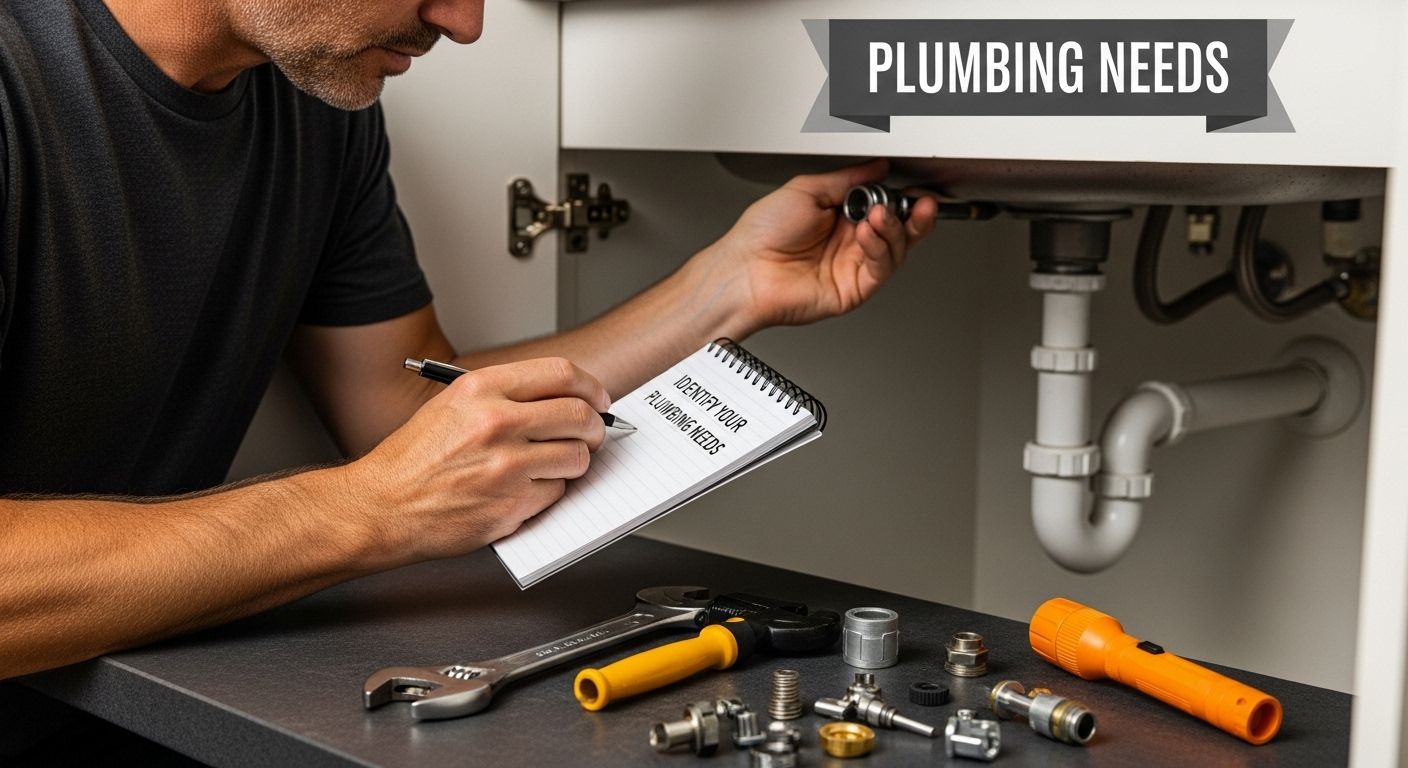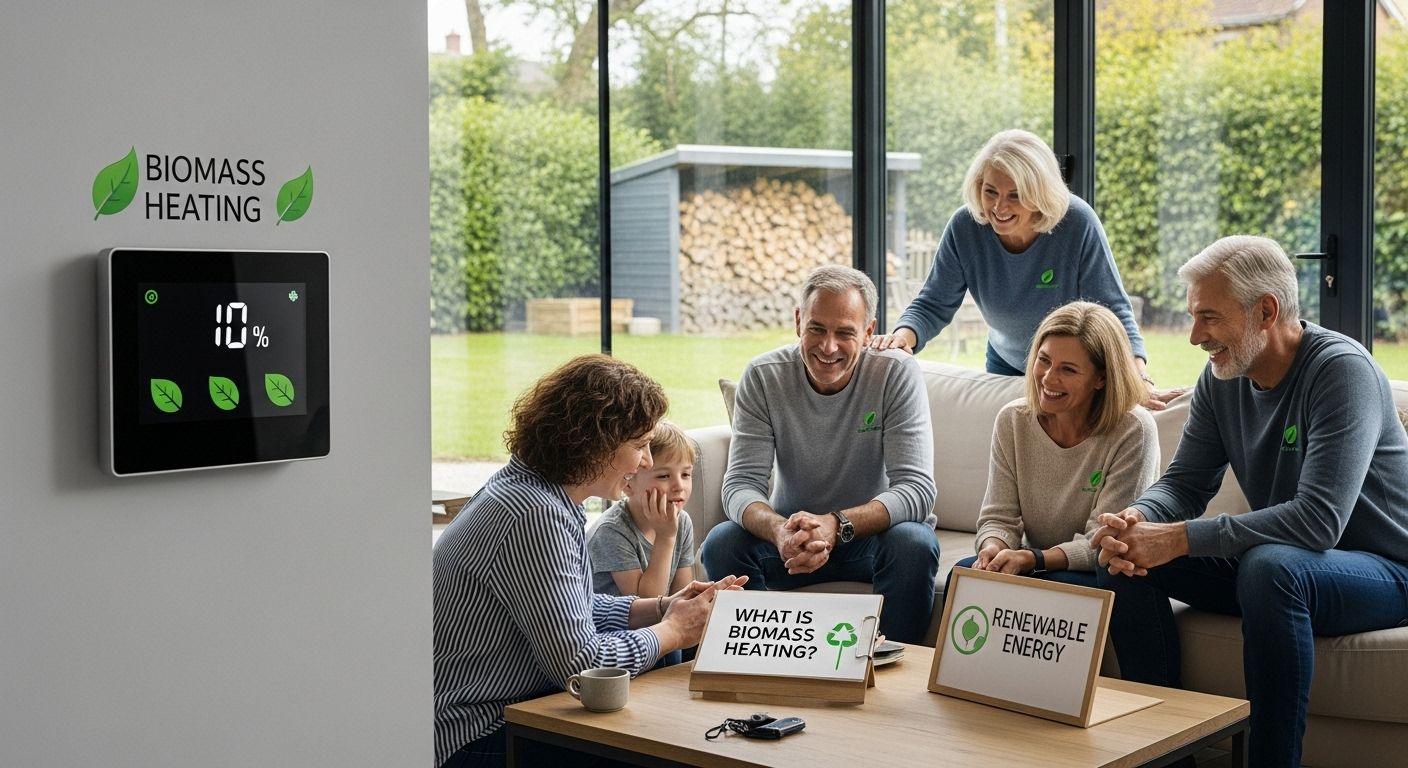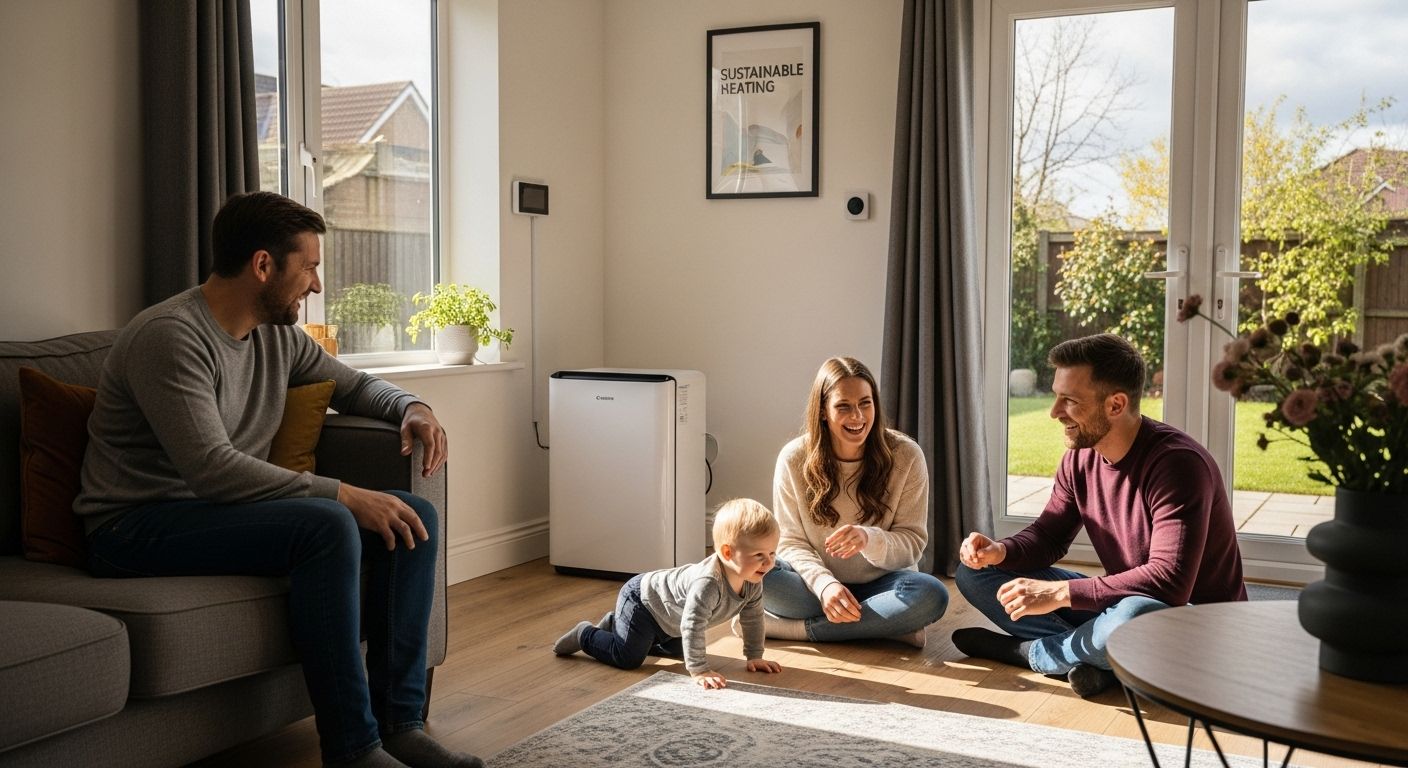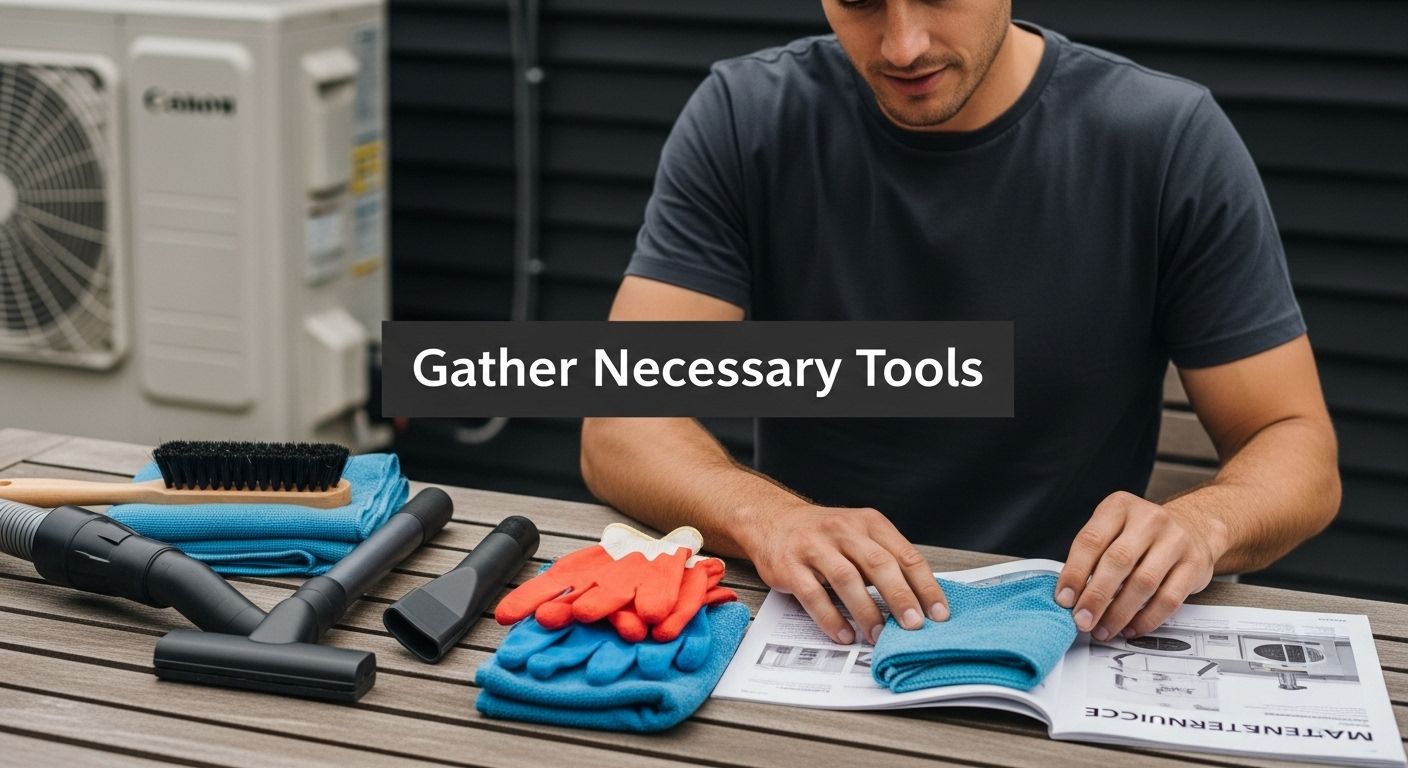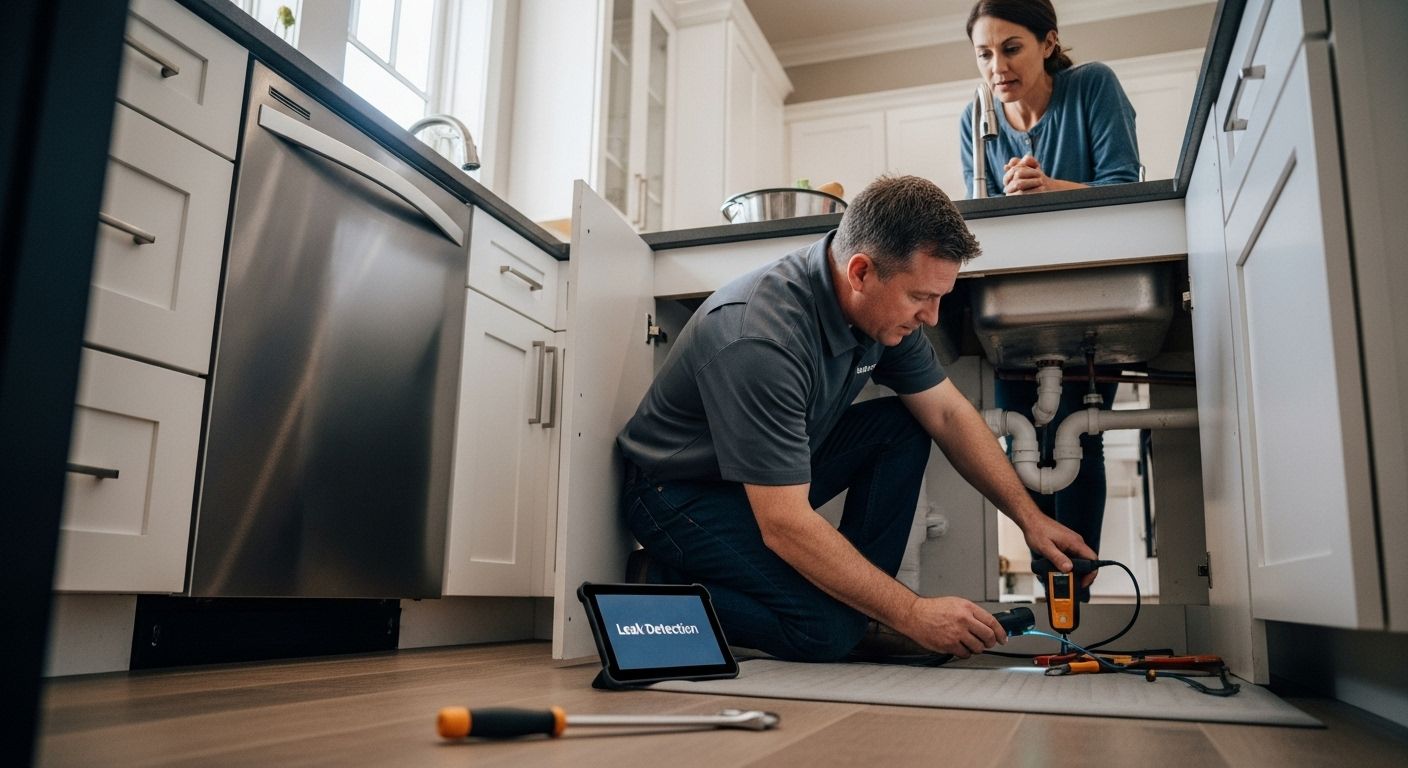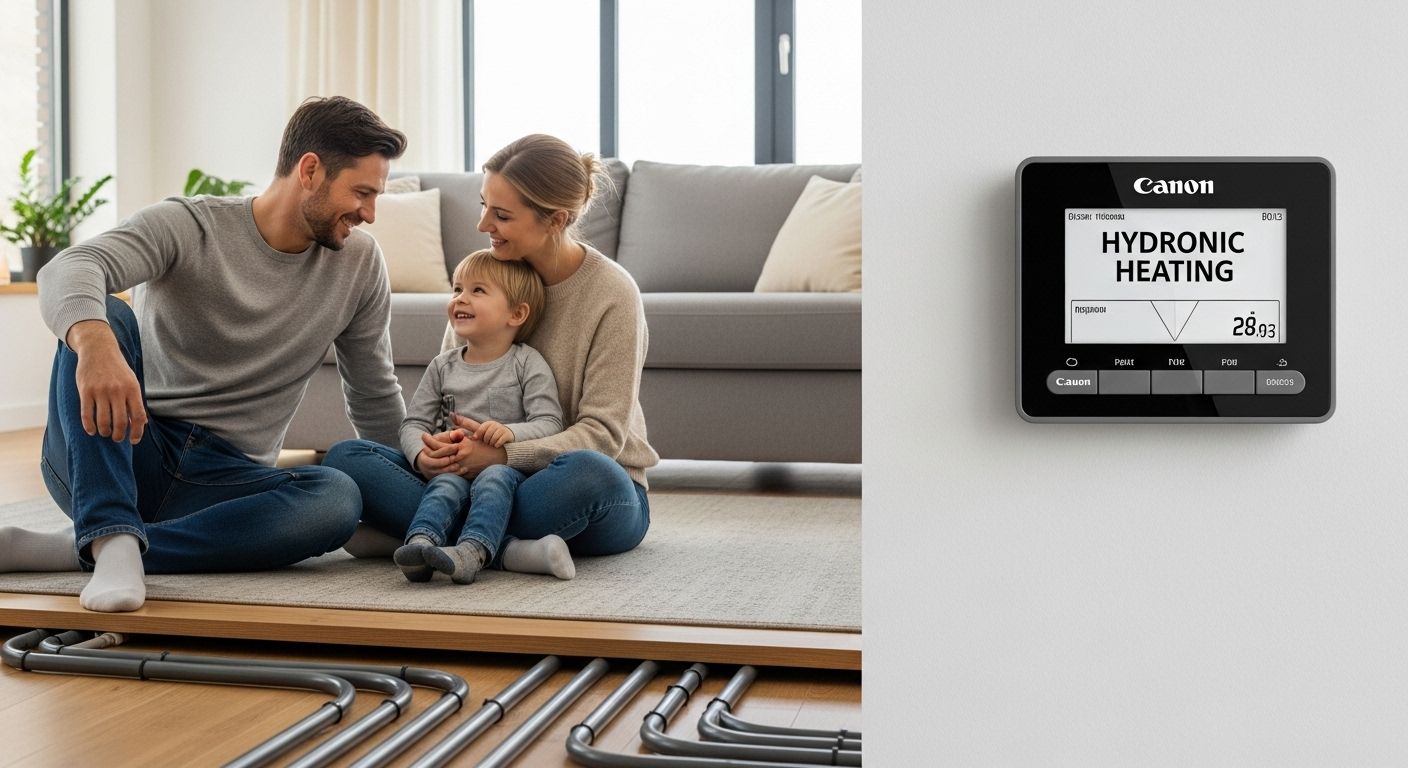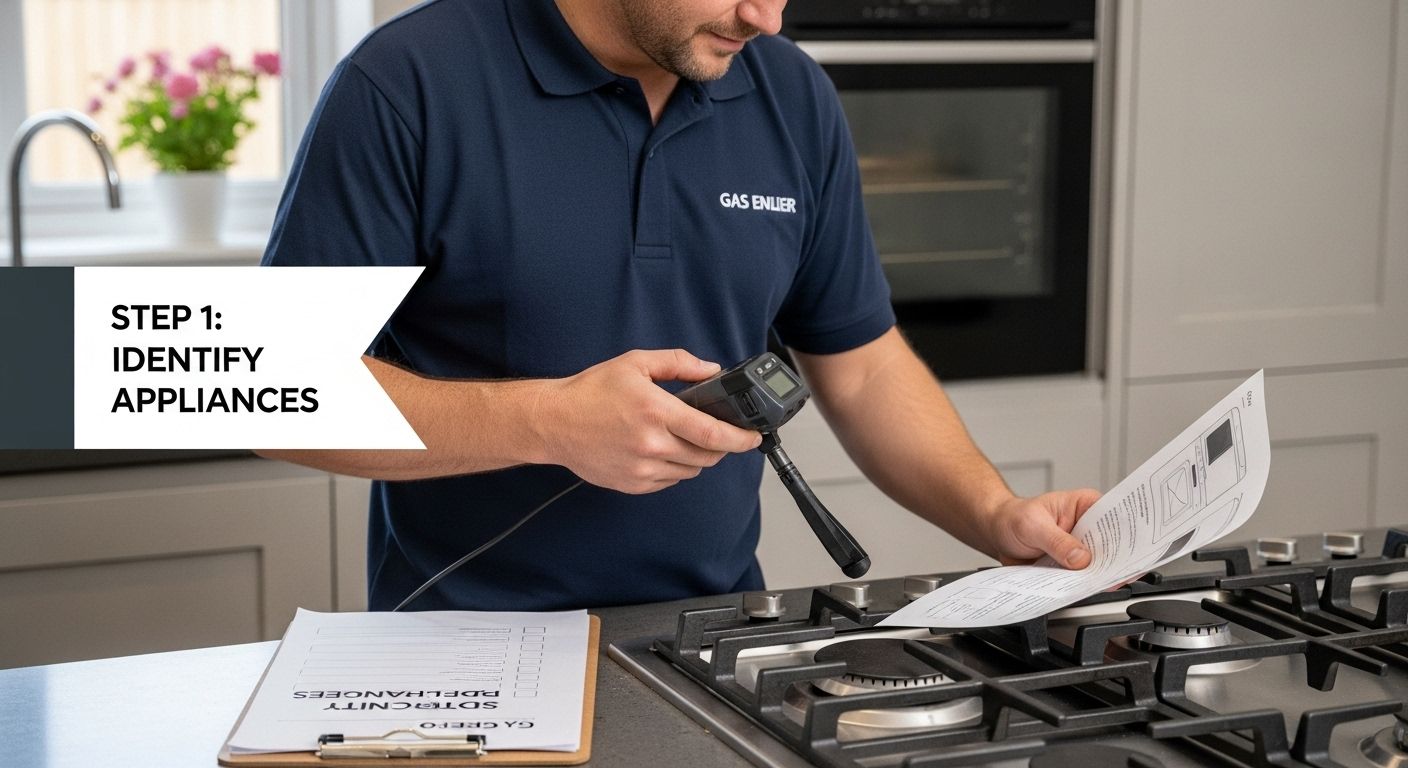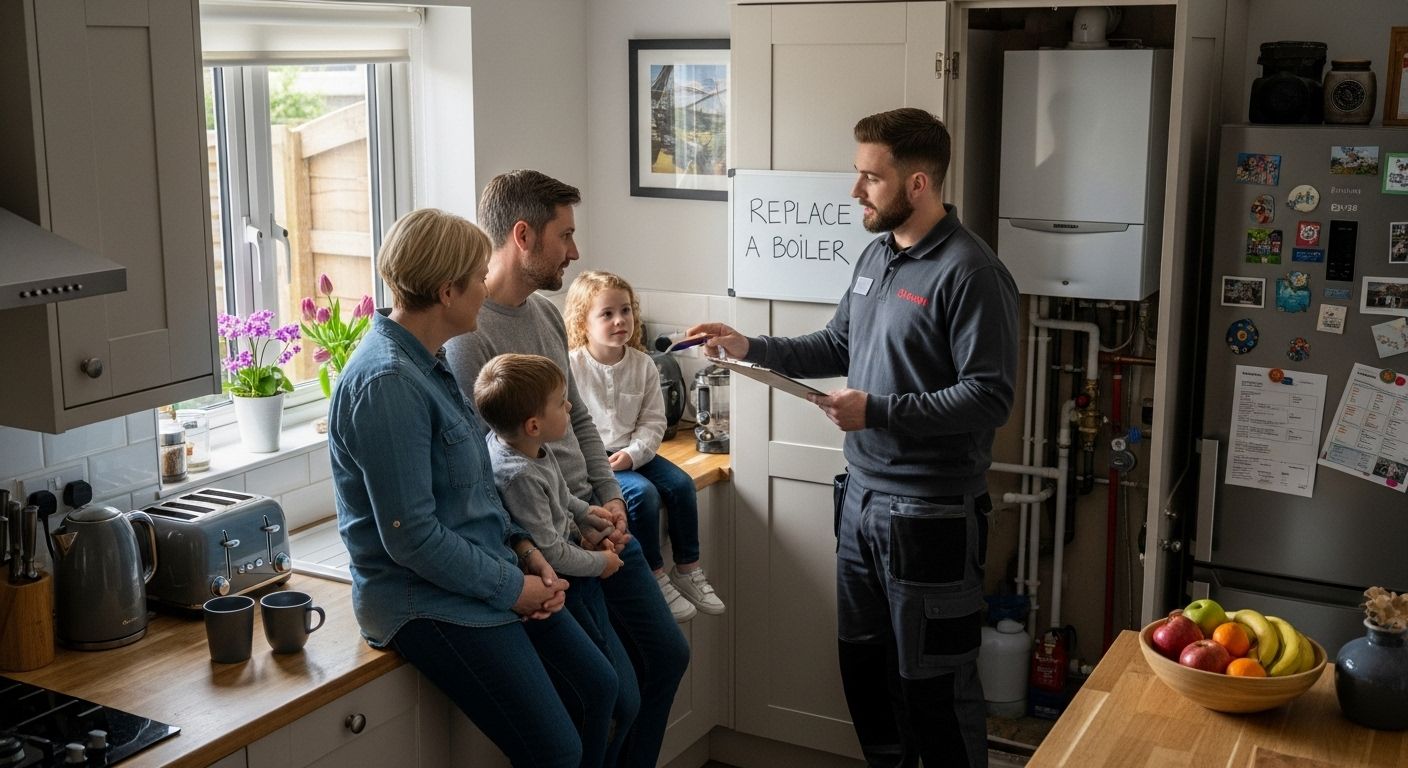How to Choose a Plumber: Find the Perfect Fit for Your Needs
Finding the right plumber matters more than ever. A single unnoticed leak can waste over 6,000 litres of water each year in the average UK home. That is more water than most people drink in a decade. Yet most people choose plumbers based solely on price or the first name they find. By flipping your approach, you can protect your home and finances in ways most homeowners never even consider.
Table of Contents
- Step 1: Identify Your Plumbing Needs
- Step 2: Research Local Plumbers
- Step 3: Evaluate Credentials And Experience
- Step 4: Request And Compare Quotes
- Step 5: Check Reviews And References
- Step 6: Make Your Final Choice
Quick Summary
| Key Point | Explanation |
|---|---|
| 1. Clearly identify plumbing needs | Conduct a thorough assessment of your plumbing issues to make your search for a plumber more effective. |
| 2. Research local plumbers thoroughly | Use various sources, including online directories and personal recommendations, to identify qualified plumbers. |
| 3. Verify credentials and experience | Check plumbers’ certifications and professional experience to ensure they are qualified for your specific job. |
| 4. Request and compare detailed quotes | Obtain multiple itemized quotes to evaluate pricing, services, and approaches before making a decision. |
| 5. Check reviews and references carefully | Investigate online reviews and contact past clients to gain insights into a plumber’s reliability and quality of work. |
Step 1: Identify Your Plumbing Needs
Before diving into the process of selecting a plumber, understanding your specific plumbing requirements is crucial. Every home presents unique challenges, and pinpointing exactly what needs attention will streamline your search and help you find the most suitable professional.
Start by conducting a thorough assessment of your current plumbing situation. Walk through your property methodically, examining each water system and potential issue. Look for warning signs such as persistent dripping, reduced water pressure, unusual noises in pipes, or visible water damage. Take detailed notes about the specific problems you observe, which will become invaluable when communicating with potential plumbers.
According to the Drinking Water Inspectorate, being precise about your requirements helps ensure you find a qualified professional who can address your exact needs. Your assessment might reveal different categories of work, such as:
- Emergency repairs (burst pipes, severe leaks)
- Routine maintenance
- System upgrades or replacements
- Heating system services
- Drainage and pipe work
Consider the complexity and urgency of your plumbing needs. Some issues require immediate attention, while others might be preventative maintenance. Complex tasks like central heating installations or complete bathroom renovations will need a plumber with specialized skills, whereas minor repairs might require less expertise.
Documenting your findings provides two significant advantages. First, it helps you communicate precisely with potential plumbers, enabling more accurate initial quotes. Second, it demonstrates your understanding of the work needed, which can prevent potential miscommunications or unnecessary work. Sketch basic diagrams if possible, noting specific locations of issues and any relevant measurements that might impact the repair or installation process.
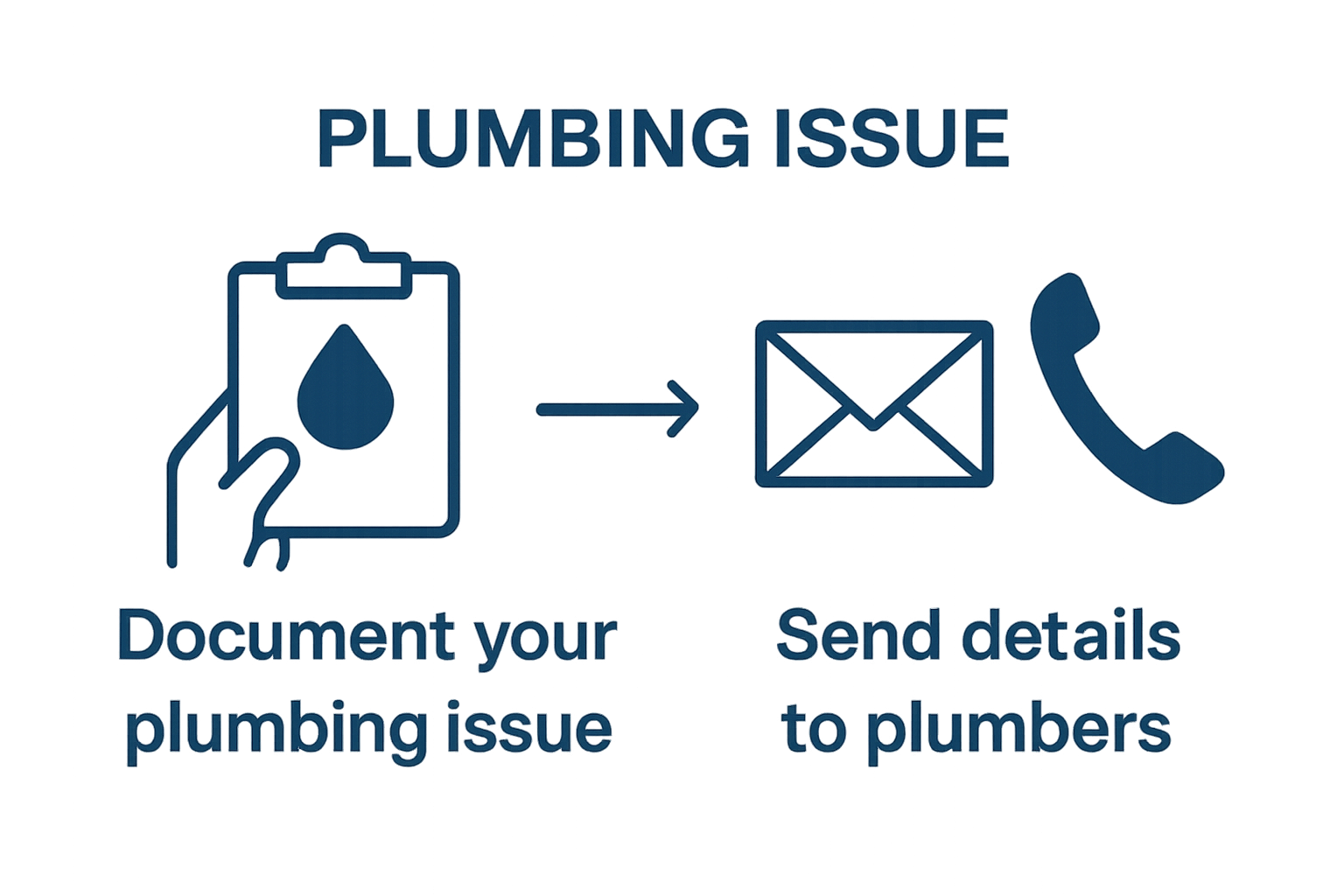
Remember that transparency about your needs will help plumbers provide more accurate assessments and prevent unexpected complications during the actual work. By taking time to thoroughly identify and document your plumbing requirements, you set the foundation for finding the right professional who can effectively resolve your specific challenges.
Step 2: Research Local Plumbers
With your plumbing needs clearly identified, the next crucial step is researching qualified local plumbers who can effectively address your specific requirements. This stage demands careful investigation to ensure you select a professional who combines technical expertise, reliability, and trustworthiness.
Begin your research by leveraging multiple information sources. Local online directories, community recommendation platforms, and professional trade association websites offer valuable insights. Word of mouth recommendations remain incredibly powerful, so ask neighbours, colleagues, and friends about plumbers they have successfully used. Their personal experiences can reveal nuanced details about a plumber’s work quality, punctuality, and professionalism that online reviews might not capture.
As you compile your list of potential plumbers, pay close attention to their professional credentials. Research from the Gas Safe Register emphasizes the critical importance of verifying trade certifications. Look for professionals registered with recognized bodies such as:
- Gas Safe Register
- WaterSafe
- Chartered Institute of Plumbing and Heating Engineering
These accreditations indicate that the plumber has undergone rigorous training and adheres to strict professional standards. Check their registration status online and confirm they are qualified to perform the specific type of work you require.
Online platforms provide an excellent opportunity to assess a plumber’s reputation. Review websites, social media profiles, and Google Business listings can offer transparent insights into their past performance. Look for plumbers with consistent positive feedback, detailed reviews that describe specific work completed, and a track record of resolving complex issues. Be wary of profiles with limited or suspiciously generic reviews.
Consider our plumbing services in Edinburgh as a benchmark for professional standards when comparing potential plumbers. Compare their response times, communication clarity, range of services, and pricing transparency. Create a comparison spreadsheet or document to systematically evaluate each potential professional, noting their strengths, specializations, and any potential concerns.
Remember that thorough research takes time but prevents potential future complications. Your goal is not just finding a plumber who can complete the job, but identifying a reliable professional who will provide high quality, trustworthy service that meets your specific plumbing needs.
Step 3: Evaluate Credentials and Experience
As you narrow down your list of potential plumbers, a critical phase involves meticulously examining their professional credentials and practical experience. This step transforms your initial research into a targeted selection process that ensures you hire a truly qualified professional.
Credentials serve as the foundational proof of a plumber’s technical competence. Professional qualifications are not just pieces of paper but represent rigorous training and validated skills. According to the National Careers Service, plumbers should possess specific certifications that demonstrate their technical expertise and legal compliance.
When evaluating credentials, focus on several key areas of professional certification. Look for evidence of:
- Gas Safe Register certification
- NVQ Level 2 or 3 in plumbing
- Water Regulations certification
- Relevant trade association memberships
Experience transforms theoretical knowledge into practical skill. Request detailed information about a plumber’s professional history, including the number of years they have been working, types of projects completed, and their specialization areas. Experienced plumbers will readily share portfolios or provide references from previous clients. Do not hesitate to request and contact these references directly.
Pay close attention to the plumber’s experience with projects similar to your specific needs. A professional who has repeatedly handled comparable work will likely understand the nuanced challenges of your particular situation. Some plumbers specialize in residential repairs, while others focus on commercial installations or specific systems like heating or drainage.
Verification is key in this evaluation process. Confirm all claimed credentials by directly checking with issuing organizations.
The Gas Safe Register, for instance, allows online verification of a tradesperson’s current registration. This step might seem time consuming, but it provides critical assurance about the plumber’s legitimacy and current professional standing.
Beyond formal qualifications, seek evidence of ongoing professional development. The most reliable plumbers invest in continuous learning, staying updated with the latest technologies, regulations, and best practices. Ask about recent training courses, workshops, or additional certifications they have pursued. This demonstrates a commitment to maintaining high professional standards and adapting to evolving industry requirements.
Remember, comprehensive credential evaluation protects you from potential substandard work, ensures safety compliance, and increases the likelihood of a successful plumbing project. Your diligence in this step will pay dividends in the quality and reliability of the service you ultimately receive.
Below is a comparative checklist to help you evaluate and verify plumbers’ credentials and experience before making a final decision.
| Credential/Experience | What to Look For | How to Verify |
|---|---|---|
| Gas Safe Register certification | Proof of current registration | Check online via Gas Safe Register website |
| NVQ Level 2 or 3 in plumbing | Certificate or statement of achievement | Request documentation; confirm with issuing body |
| Water Regulations certification | Valid certification for compliance | Request a copy; verify with certification authority |
| Trade association membership | Membership with organisations like WaterSafe | Look for official logos and verify on association sites |
| Years of relevant experience | Detailed project history similar to your needs | Ask for portfolio; request references from past clients |
| Ongoing professional development | Evidence of recent training or new certifications | Ask about recent courses or workshops attended |
| References from previous clients | Willingness to provide direct contact details | Contact references to ask about completed work |
Step 4: Request and Compare Quotes
With your preliminary research complete, the next critical phase involves gathering and systematically comparing quotes from potential plumbers. This step transforms your shortlist into a precise selection process, ensuring you receive fair pricing and comprehensive service understanding.
Transparency and detail are paramount when requesting quotes. Reach out to each plumber with a comprehensive description of the work required, including specific measurements, current system configurations, and any unique challenges you identified during your initial assessment. The more precise your description, the more accurate the quote will be. Do not rely on vague verbal descriptions or quick phone estimates.
According to the UK Government’s procurement guidance, obtaining multiple quotes is crucial for making an informed decision. Aim to collect quotes from at least three different plumbers, ensuring each professional provides a written, itemized estimate that breaks down:
- Labour costs
- Material expenses
- Potential additional charges
- Estimated project duration
- Warranty or guarantee details
When comparing quotes, resist the temptation to select solely based on the lowest price. A significantly cheaper quote might indicate lower quality materials, less experienced labour, or hidden additional costs. Examine each quote holistically, considering the plumber’s credentials, reputation, and the comprehensiveness of their proposed solution.
Request that each quote includes a detailed explanation of the proposed work methodology. A professional plumber should be able to articulate not just what they will do, but why they recommend specific approaches. This demonstrates technical understanding and gives you insight into their problem solving capabilities.
Pay close attention to the quote’s small print. Look for clauses about unexpected complications, potential additional costs, and the process for managing unforeseen issues. Some quotes might appear competitive initially but contain provisions that could significantly increase the final price. A truly transparent quote will outline potential scenarios and associated costs upfront.
Consider scheduling brief follow up discussions with each plumber who submitted a quote. These conversations can reveal nuances not captured in written estimates and allow you to gauge their communication style and professionalism. Ask clarifying questions about their proposed approach, timeline, and how they would handle potential complications.
Remember, the goal is not just finding the cheapest option, but selecting a plumber who offers the best value combination of expertise, reliability, and fair pricing. Your meticulous approach in comparing quotes will significantly increase the likelihood of a successful plumbing project.
Step 5: Check Reviews and References
After gathering quotes and evaluating credentials, the next crucial step involves meticulously investigating a plumber’s professional reputation through comprehensive review and reference checking. This process goes beyond surface level assessment, diving deep into their actual performance and client satisfaction.
Online reviews provide valuable initial insights, but they should not be your sole evaluation method. Multiple platforms offer perspectives on a plumber’s reliability, including Google Reviews, Trustpilot, and specialized trade websites. Look for patterns in feedback rather than isolated comments. Consistent positive mentions of punctuality, problem solving skills, and quality of work are far more meaningful than sporadic praise.
According to Citizens Advice, obtaining 2 or 3 recent examples of similar work and directly contacting previous clients can provide the most authentic understanding of a plumber’s capabilities. When reviewing references, pay attention to:
- Complexity of previous projects
- Quality of communication
- Adherence to initial quotes
- Professionalism during work
- Cleanliness and respect for property
Do not hesitate to request and personally contact references.
Use the table below to compare and assess quotes from different plumbers, ensuring each estimate meets essential criteria for transparency and thoroughness.
| Quote Criterion | Description | Why It Matters |
|---|---|---|
| Written, itemised estimate | Detailed breakdown of all costs | Helps clarify scope and prevents hidden fees |
| Labour costs | Clear specification of hourly or project rate | Enables fair comparison between plumbers |
| Material expenses | List of materials and their respective costs | Reveals quality and pricing transparency |
| Additional potential charges | Any extra fees for complications or emergencies | Prepares you for possible extra expenditure |
| Estimated project duration | Stated start and completion times | Aids in planning and minimises disruption |
| Warranty or guarantee details | Information on service or parts cover | Assures aftercare and recourse if problems |
| Work methodology explanation | Rationale for chosen approach | Demonstrates competence and problem solving |
Be cautious of potential red flags in reviews. Recurring complaints about hidden charges, missed appointments, or incomplete work should prompt careful consideration. Similarly, an absence of reviews or a profile with only generic, overly positive testimonials might indicate fabricated feedback.
Cross reference reviews across multiple platforms to build a comprehensive picture. A plumber might have excellent ratings on one website but mixed reviews elsewhere. This holistic approach helps prevent potential disappointment and ensures you select a truly reliable professional.
Remember that thorough reference checking is more than a procedural step it is your primary defence against substandard work. Your diligence in this stage can save significant time, money, and potential future repair costs. By investing effort in understanding a plumber’s true professional reputation, you dramatically increase the likelihood of a successful, stress free plumbing project.

Step 6: Make Your Final Choice
After methodically working through previous steps, you now arrive at the critical moment of selecting your plumber. This final decision synthesizes all the research, comparisons, and evaluations you have carefully conducted. The goal is not just hiring a service provider, but establishing a trustworthy professional relationship.
Weigh each candidate against a comprehensive set of criteria that goes beyond simple price comparison. Consider how well each plumber demonstrated technical competence, communication skills, reliability, and alignment with your specific project requirements. The cheapest option is rarely the best choice when it comes to specialized technical work that impacts your home’s fundamental infrastructure.
According to the Drinking Water Inspectorate, selecting a plumber involves more than technical skills. Look for professionals who demonstrate:
- Clear, transparent communication
- Willingness to explain technical details
- Professional demeanor
- Comprehensive understanding of your specific project
- Flexibility and problem solving abilities
Before making a final commitment, schedule a final consultation with your top candidate. This meeting serves multiple purposes beyond technical discussion. Observe their punctuality, preparedness, and ability to articulate complex solutions in understandable terms. A truly professional plumber will welcome your questions and provide comprehensive, confidence inspiring answers.
Pay close attention to the contract details. A professional written agreement protects both parties. Ensure the document clearly outlines project scope, expected timeline, total costs, payment schedule, and warranty provisions. Do not sign anything you do not fully understand, and do not hesitate to request clarification on any points that seem ambiguous.
Consider the intangible factors that emerged during your interactions. Professional chemistry matters significantly in technical service relationships. A plumber who listens carefully, shows genuine interest in solving your specific problem, and communicates with respect will likely provide a superior overall experience compared to someone who seems disinterested or dismissive.
Finally, trust your instincts. After rigorous research and evaluation, your accumulated insights will guide you towards the right professional. The ideal plumber is not just technically competent but also demonstrates integrity, reliability, and a commitment to solving your specific challenges with professionalism and expertise.
Discover Trusted Plumbing Solutions Tailored to Your Needs
Have you finished comparing quotes and checking references, but still feel anxious about making the right choice? Finding a reliable plumber can be stressful, especially when every decision affects the safety and efficiency of your home. If you want complete confidence that your plumbing, central heating, and renewable energy projects are handled by experts who are fully accredited and come highly recommended, then why gamble with uncertainty? At Thermatek Heating you will find professionals who meet all the qualifications and customer service standards explained in this guide.
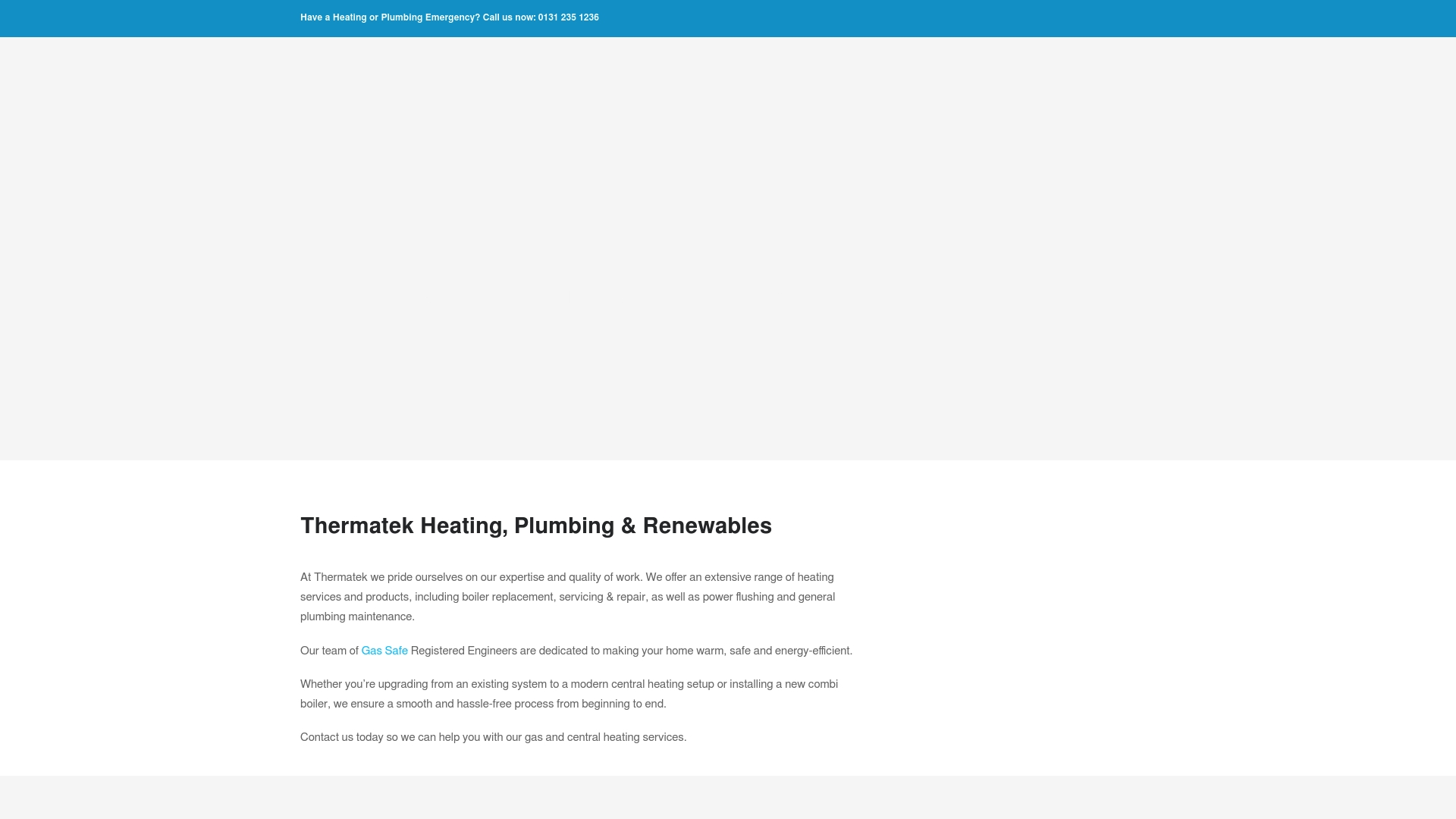
Experience peace of mind knowing your home or property is in the hands of experienced Gas Safe Registered engineers who prioritise safety, honesty, and transparent communication. Check out our full range of plumbing and heating services for Edinburgh and Midlothian, and see real customer testimonials that reflect our commitment to quality. Do not wait until small issues become costly headaches. Reach out today for a no-obligation quote and discover why so many homeowners and landlords trust Thermatek for their heating and plumbing needs.
Frequently Asked Questions
What should I consider when identifying my plumbing needs?
Before selecting a plumber, assess your plumbing situation thoroughly by looking for signs like dripping faucets, reduced water pressure, or visible water damage. Document your findings to communicate your needs clearly with potential plumbers.
How do I research local plumbers effectively?
Utilise local online directories, community recommendation platforms, and ask for word-of-mouth recommendations from friends and neighbours. Check their credentials with recognised bodies such as the Gas Safe Register and WaterSafe to ensure they are qualified for your plumbing needs.
What credentials should I look for in a plumber?
Look for certifications such as Gas Safe Register membership, NVQ qualifications in plumbing, and relevant trade association affiliations. These credentials show that a plumber has received the necessary training and adheres to industry standards.
How can I compare quotes from different plumbers?
Request detailed written quotes from at least three plumbers, ensuring they include breakdowns of labour costs, material expenses, and estimated project duration. Compare these quotes holistically, considering quality, services offered, and not just the lowest price.
Recommended
- Plumbing Services In Edinburgh
- New Boiler Installation & Replacement In Edinburgh
- Boiler Repair In Edinburgh
What is Biomass Heating? Understanding Renewable Energy
Biomass heating is changing the way people think about warmth at home and in industry. Think wood pellets and plant waste turned directly into energy. Yet, most never guess that some Midlothian projects now supply thousands of homes with low-carbon heat from local waste. This renewable approach does not just keep homes cosy. It is pushing entire communities in Edinburgh and beyond towards cleaner, smarter energy solutions.
Table of Contents
- Defining Biomass Heating: What It Is And How It Works
- The Importance Of Biomass Heating: Why It Matters
- The Components Of Biomass Heating Systems: Key Concepts
- Benefits And Challenges Of Biomass Heating For Homeowners
- Real-World Applications Of Biomass Heating In Edinburgh And Midlothian
Quick Summary
| Takeaway | Explanation |
|---|---|
| Biomass heating is a renewable solution | Utilises organic materials like wood and agricultural waste to generate heat, transforming waste into energy. |
| Significant carbon reduction potential | Biomass heating can reduce greenhouse gas emissions, offering a circular approach to energy production from organic waste. |
| Local economic benefits and job creation | Developing biomass supply chains fosters local employment and lessens reliance on imported energy resources. |
| Key factors for system selection | Consideration of fuel availability, efficiency, space requirements, and maintenance is crucial when choosing a biomass system. |
| Challenges include installation and maintenance | Homeowners face upfront costs, space needs for equipment, and regulatory compliance when implementing biomass heating systems. |
Defining Biomass Heating: What It Is and How It Works
Biomass heating represents a renewable energy solution that transforms organic materials into heat through systematic combustion processes. At its core, this technology harnesses biological matter like wood, agricultural residues, and plant-based waste to generate warmth for homes, businesses, and industrial applications.
The Science Behind Biomass Energy Conversion
Biomass heating operates through direct thermal conversion, where organic materials undergo controlled combustion to release energy. During this process, biomass fuels are burned in specialised boilers or heating systems, generating high-temperature gases that can be used immediately for heating or transformed into hot water and steam.
According to Forest Research, this method offers a sustainable alternative to traditional fossil fuel-based heating systems.
The energy conversion process involves several key stages:
- Fuel preparation and sizing
- Controlled combustion
- Heat capture and distribution
- Emissions management
Types of Biomass Heating Systems
Biomass heating technologies vary significantly in scale and complexity. Domestic systems typically utilise wood pellet or log boilers, while larger industrial installations might employ wood chip systems or advanced combined heat and power (CHP) configurations. These systems can be integrated into existing heating infrastructures, providing flexible renewable energy solutions.
To help readers compare the different types of biomass heating systems discussed, the table below summarises key characteristics and system suitability for various applications.
| Type of Biomass System | Typical Applications | Fuel Type | Efficiency Considerations | Scalability |
|---|---|---|---|---|
| Wood Pellet Boiler | Domestic, small commercial | Wood pellets | High efficiency, low emissions | Small to medium |
| Log Boiler | Domestic, rural properties | Logs | Manual loading required | Small |
| Wood Chip System | Large commercial, industrial | Wood chips | Suits automated feeding | Medium to large |
| Combined Heat & Power (CHP) | Industrial, district heating | Various biomass fuels | Generates heat & electricity | Large |
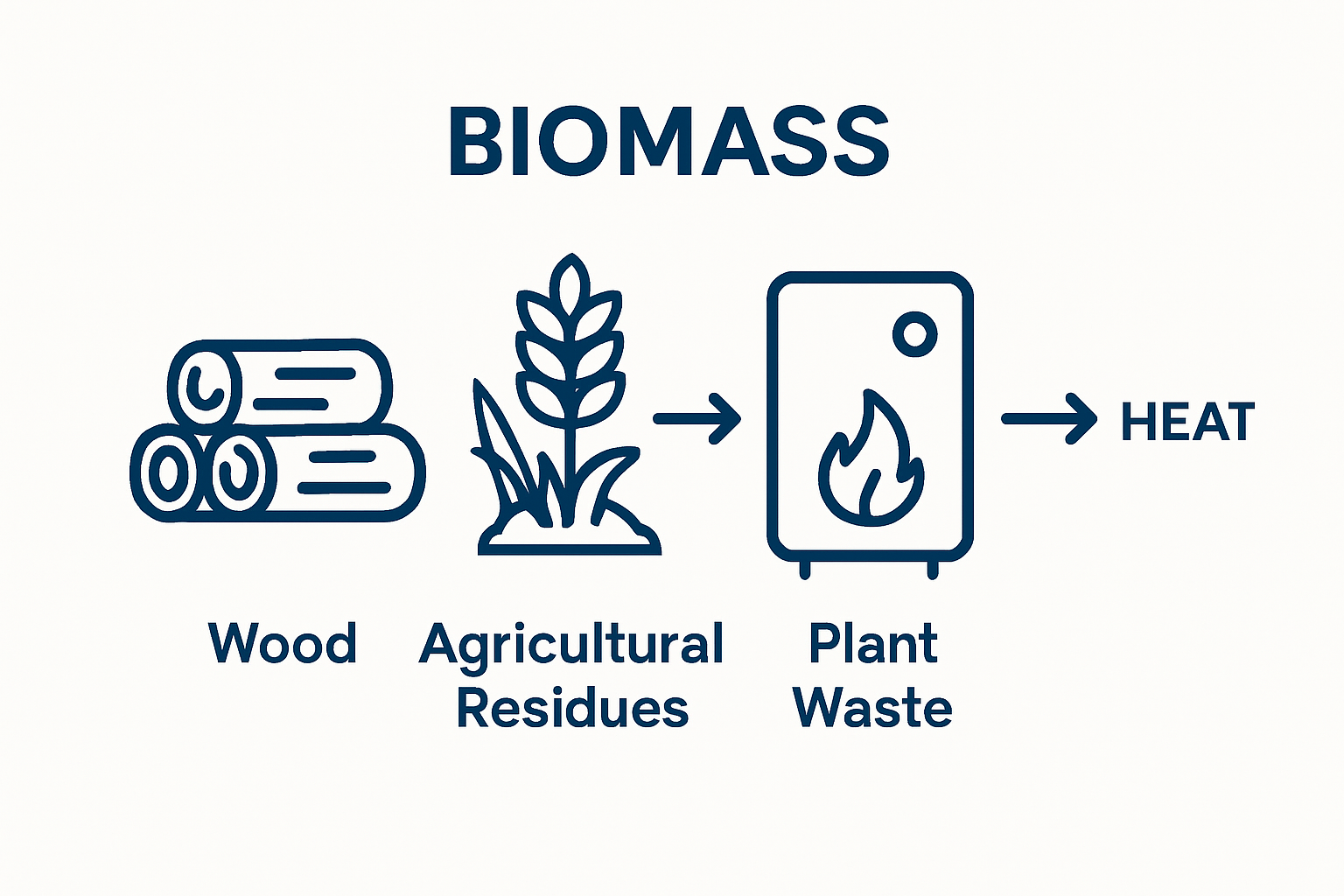
Key considerations when selecting a biomass heating system include:
- Fuel availability and local sourcing
- Installation space requirements
- Efficiency ratings
- Maintenance complexity
- Initial investment costs
By converting organic waste into usable heat, biomass heating not only provides a practical energy solution but also contributes to waste reduction and carbon emissions mitigation.
The Importance of Biomass Heating: Why It Matters
Biomass heating emerges as a pivotal renewable energy strategy with profound environmental and economic implications. By transforming organic waste into sustainable heat, this technology offers a comprehensive approach to addressing climate challenges while providing practical energy solutions for communities and industries.
Environmental Benefits and Carbon Reduction
One of the most significant advantages of biomass heating is its potential to substantially reduce carbon emissions. Unlike fossil fuel systems, biomass utilises organic materials that would otherwise be discarded, creating a circular approach to energy production. According to the UK Biomass Strategy, biomass plays a critical role in decarbonising heating systems and supporting national net zero targets.
Key environmental advantages include:
- Reduced greenhouse gas emissions
- Waste material repurposing
- Lower dependency on fossil fuels
- Support for sustainable forestry and agricultural practices
Economic and Energy Security Implications
Beyond environmental benefits, biomass heating presents significant economic opportunities. By developing localised biomass supply chains, regions can create jobs, support rural economies, and reduce energy import dependencies. The technology provides a flexible renewable energy solution that can be scaled from small residential installations to large industrial applications.
Strategic economic benefits encompass:
- Local job creation in biomass production
- Reduced energy import reliance
- Potential for lower long-term heating costs
- Enhanced energy system resilience
As the United Kingdom continues to transition towards more sustainable energy systems, biomass heating represents a pragmatic and adaptable approach to meeting complex environmental and economic challenges. By integrating renewable technologies like biomass, communities can actively contribute to a more sustainable and resilient energy future.
The Components of Biomass Heating Systems: Key Concepts
Biomass heating systems represent sophisticated technologies designed to convert organic materials into usable thermal energy. Understanding their fundamental components is crucial for evaluating their efficiency, performance, and suitability for different applications.
Core System Architecture
A typical biomass heating system comprises several interconnected components that work seamlessly to transform organic fuel into heat. The primary elements include the fuel storage unit, combustion chamber, heat exchange mechanism, and distribution system. According to Forest Research, proper design and integration of these components are essential for optimal system performance.
This table outlines the principal components of a biomass heating system alongside their primary functions, making it easier to understand system architecture at a glance.
| Component | Function |
|---|---|
| Fuel Storage | Holds biomass fuel prior to combustion |
| Fuel Handling Mechanism | Moves fuel from storage to combustion chamber |
| Combustion Chamber | Burns the biomass to release heat |
| Heat Exchanger | Transfers heat from combustion to water/air |
| Flue and Emissions System | Manages exhaust gases and emissions |
| Control Electronics | Monitors and controls system performance |
Key architectural components include:
- Fuel storage and handling mechanisms
- Combustion chambers
- Heat exchangers
- Flue and emission control systems
- Control and monitoring electronics
Technical Performance Considerations
The efficiency of a biomass heating system depends on multiple technical factors. Fuel quality, moisture content, particle size, and combustion temperature significantly influence the system’s overall performance. Modern biomass systems incorporate advanced technologies like automated fuel feeding, precise temperature control, and sophisticated emission management to enhance operational reliability.
Critical performance parameters include:
- Thermal efficiency ratings
- Fuel conversion rates
- Emissions standards compliance
- Maintenance requirements
- System scalability
By understanding these fundamental components and performance characteristics, property owners and energy managers can make informed decisions about implementing biomass heating solutions that align with their specific energy requirements and sustainability goals.

Benefits and Challenges of Biomass Heating for Homeowners
Biomass heating represents a compelling renewable energy solution for homeowners seeking sustainable and environmentally conscious heating alternatives. Understanding the nuanced advantages and potential limitations is crucial for making informed decisions about implementing this technology.
Financial and Environmental Advantages
Homeowners considering biomass heating can benefit from significant long-term financial and environmental rewards. According to the Energy Saving Trust, biomass systems offer substantial carbon emissions reduction compared to traditional fossil fuel heating methods. The technology provides a renewable energy approach that can potentially lower household energy expenses while supporting broader climate mitigation efforts.
Key financial and environmental benefits include:
- Reduced carbon dioxide emissions
- Potential for lower long-term heating costs
- Utilisation of renewable, locally sourced fuel
- Reduced dependence on fossil fuel energy systems
- Contribution to national renewable energy targets
Practical Considerations and Installation Challenges
While biomass heating presents numerous advantages, homeowners must carefully evaluate practical implementation factors. System installation requires significant upfront investment, specialised infrastructure, and ongoing maintenance. Space requirements for fuel storage, potential building modifications, and compliance with local regulations are critical considerations.
Potential challenges homeowners might encounter include:
- Higher initial installation costs
- Dedicated space requirements for equipment
- Regular maintenance and fuel management
- Potential planning permission restrictions
- Fuel sourcing and storage complexities
By thoroughly understanding these benefits and challenges, homeowners can make sophisticated energy choices that align with their environmental values, financial capabilities, and long-term sustainability objectives.
To provide a clear overview, the following table compares the key benefits and challenges of biomass heating for homeowners, enabling effective assessment of this technology for domestic use.
| Aspect | Advantages | Challenges |
|---|---|---|
| Environmental Impact | Substantial carbon emissions reduction | Emissions management required |
| Financial Considerations | Potential for lower long-term energy bills | Higher upfront installation costs |
| Fuel Source | Renewable, often locally available | Requires reliable sourcing and storage |
| Practical Implementation | Reduces reliance on fossil fuels | Needs dedicated space and regular maintenance |
| Regulatory | Supports national renewable targets | Possible planning permission and compliance issues |
Real-World Applications of Biomass Heating in Edinburgh and Midlothian
Biomass heating is rapidly transforming local energy landscapes, with Edinburgh and Midlothian emerging as pioneering regions in renewable energy implementation. These areas demonstrate innovative approaches to integrating sustainable heating technologies into urban and rural infrastructures.
Community and Municipal Energy Initiatives
Midlothian represents a prime example of strategic renewable energy development. According to Midlothian Energy Limited, local energy projects are capturing low-carbon heat from waste processing facilities to supply thousands of homes. These initiatives not only reduce carbon emissions but also create localised, sustainable energy networks that support community resilience.
Key community biomass heating applications include:
- District heating networks
- Municipal building energy systems
- Shared renewable energy infrastructure
- Community-owned energy projects
- Waste-to-energy conversion programmes
Institutional and Academic Implementations
Academic institutions in the region are leading groundbreaking biomass heating research and practical applications. The University of Edinburgh has been exploring innovative heat recovery techniques, demonstrating how institutional buildings can serve as testbeds for advanced renewable energy solutions. These projects showcase the potential for heat pump installations that complement biomass heating strategies.
Notable institutional biomass heating approaches encompass:
- Campus-wide renewable energy networks
- Experimental heat storage technologies
- Integration of waste heat recovery systems
- Collaborative research programmes
- Pilot decarbonisation projects
By embracing biomass heating, Edinburgh and Midlothian are not just reducing carbon footprints but also establishing replicable models for sustainable urban energy transformation.
Take Control of Your Renewable Heating Journey Today
Wondering how to bridge the gap between understanding the benefits of biomass heating and making your home truly sustainable? If you are facing rising energy costs, concerns about carbon emissions, or uncertainty about installing new renewable systems, you are not alone. Many readers like you are searching for a trusted provider who understands the complexities of fuel sourcing, system efficiency, and space requirements outlined in the article. Thermatek delivers expert guidance and tailored solutions for Edinburgh and Midlothian homeowners ready to turn information into action.

Start your transition to clean, reliable heating now with Thermatek. Our Gas Safe engineers help you make sense of renewable technologies, including heat pump installation, and fully support you from the first quote to ongoing maintenance. Discover how your home can benefit from effective, safe, and compliant renewable heating by visiting our services page. Take the next step towards lower bills and a greener future—contact Thermatek today and secure your place at the forefront of energy innovation.
Frequently Asked Questions
What is biomass heating?
Biomass heating is a renewable energy solution that generates heat by burning organic materials, such as wood, agricultural residues, or plant-based waste. It transforms these biological materials into thermal energy for homes, businesses, and industrial applications.
How does biomass heating work?
Biomass heating systems operate through controlled combustion of organic fuels in specially designed boilers. This process produces high-temperature gases that can be used for direct heating or converted into hot water and steam.
What are the environmental benefits of biomass heating?
Biomass heating helps reduce carbon emissions by repurposing organic waste, thereby lowering dependency on fossil fuels. It contributes to sustainable forestry practices and promotes waste material recycling, supporting climate change mitigation efforts.
What are the main components of a biomass heating system?
A biomass heating system typically includes a fuel storage unit, combustion chamber, heat exchange mechanism, and distribution system. Each component plays a crucial role in the efficient conversion of organic materials into usable thermal energy.
Recommended
- Solar Thermal Installers In Edinburgh
- News
- Air Source Heat Pump Installation In Edinburgh
- New Boiler Installation & Replacement In Edinburgh
Understanding Sustainable Heating Systems Today
Sustainable heating systems are rapidly changing how homes and businesses stay warm while tackling environmental concerns. Picture this. Residential and commercial buildings are responsible for about 40 percent of global energy-related carbon dioxide emissions. Most people assume that cutting emissions means sacrificing comfort or paying more. In reality, these innovative heating technologies deliver both efficiency and affordability while protecting the planet.
Table of Contents
- What Are Sustainable Heating Systems?
- Why Sustainable Heating Systems Matter
- How Sustainable Heating Systems Operate
- Key Concepts In Sustainable Heating Technologies
- Real-World Applications Of Sustainable Heating Systems
Quick Summary
| Takeaway | Explanation |
|---|---|
| Sustainable heating reduces carbon emissions. | Transitioning from fossil fuels to renewable sources can significantly lower greenhouse gas emissions from buildings. |
| Utilise renewable energy sources for heating. | Air source heat pumps, solar thermal systems, and biomass boilers harness natural energy to provide effective heating solutions. |
| Homeowners can save on energy costs. | Implementing sustainable heating systems can lower energy bills and maintenance costs through efficient energy use. |
| Sustainable heating improves air quality. | By reducing reliance on fossil fuels, these systems help decrease air pollutants, benefiting both urban and rural environments. |
| Transition enables energy independence. | Sustainable technologies lessen reliance on imported fuels and enhance energy security through local renewable resources. |
What are Sustainable Heating Systems?
Sustainable heating systems represent a critical technological approach to reducing carbon emissions while providing efficient thermal comfort for homes and buildings. These innovative solutions focus on generating heat through environmentally friendly methods that minimise energy consumption and greenhouse gas production.
The Core Principles of Sustainability
At their fundamental level, sustainable heating systems prioritise renewable energy sources and energy efficiency. Unlike traditional fossil fuel-based heating methods, these systems leverage natural resources such as solar energy, ground heat, air temperature, and biomass to generate warmth. The primary goal is to create heating solutions that significantly reduce carbon footprints while maintaining high performance standards.
According to the UK Government’s Heat and Buildings Strategy, sustainable heating technologies are essential for achieving national climate objectives. Key characteristics include:
- Minimal environmental impact
- Reduced carbon emissions
- Lower long-term operational costs
- Utilisation of renewable energy sources
Technology and Implementation
Sustainable heating encompasses various technologies, each designed to harness different renewable energy principles. These include air source heat pumps, ground source heat pumps, solar thermal systems, and biomass boilers. Each technology offers unique advantages and can be tailored to specific property requirements.
The following table compares the main types of sustainable heating technologies discussed in the article, highlighting their key energy sources, primary applications, and unique advantages.
| Technology | Primary Energy Source | Typical Applications | Key Advantages |
|---|---|---|---|
| Air Source Heat Pump | Ambient air | Residential & commercial buildings | High efficiency, easy integration, low carbon |
| Ground Source Heat Pump | Ground heat | Homes & larger commercial sites | Consistent performance, very low emissions |
| Solar Thermal System | Solar radiation | Domestic water & space heating | Renewable, reduces reliance on grid energy |
| Biomass Boiler | Organic biomass | Rural homes, districts, small firms | Utilises renewable fuels, reduces waste |
For those interested in exploring local renewable heating options, our guide on heat pump installations provides comprehensive insights into practical implementation strategies for Edinburgh and Midlothian properties.
The transition to sustainable heating systems represents more than a technological upgrade it signifies a fundamental shift towards responsible energy consumption and environmental stewardship. By embracing these innovative solutions, homeowners and businesses can contribute meaningfully to reducing global carbon emissions while enjoying efficient and cost-effective heating technologies.
Why Sustainable Heating Systems Matter
Sustainable heating systems are far more than a technological trend they represent a critical strategy for addressing global environmental challenges, reducing carbon emissions, and creating more resilient energy infrastructures for homes and communities.
Environmental Impact and Climate Mitigation
Traditional heating methods relying on fossil fuels contribute significantly to greenhouse gas emissions. Residential and commercial buildings account for approximately 40% of global energy-related carbon dioxide emissions. Sustainable heating systems offer a transformative approach to dramatically reducing this environmental burden.
According to the UK Government’s Clean Growth Strategy, transitioning to low-carbon heating technologies is essential for achieving national climate targets. The environmental benefits include:
- Substantial reduction in carbon emissions
- Decreased reliance on non-renewable energy sources
- Improved air quality in urban and rural environments
- Mitigation of climate change impacts
Economic and Social Benefits
Beyond environmental advantages, sustainable heating systems provide significant economic incentives. Homeowners can experience long-term cost savings through reduced energy consumption and lower maintenance requirements. Government incentives and potential grants further enhance the financial attractiveness of these technologies.
For residents in Edinburgh and Midlothian interested in understanding local renewable heating opportunities, our detailed heat pump installation guide provides comprehensive insights into practical implementation and potential cost savings.
Moreover, sustainable heating contributes to energy security by reducing dependence on imported fossil fuels and creating more decentralised, resilient energy systems. As global energy landscapes continue to evolve, investing in sustainable heating technologies represents a forward-thinking approach to meeting both environmental responsibilities and practical energy needs.
This table summarises the key environmental, economic, and social benefits of sustainable heating systems, as referenced throughout the article, for quick comparison and clarity.
| Benefit Area | Explanation |
|---|---|
| Environmental | Significantly reduces carbon emissions and reliance on non-renewable energy |
| Air Quality | Decreases air pollutants, improving conditions in urban and rural environments |
| Economic | Delivers long-term savings through lower bills and maintenance costs |
| Social | Enhances energy security and resilience through local renewable sources |
How Sustainable Heating Systems Operate
Sustainable heating systems represent sophisticated technological solutions that harness renewable energy sources to generate thermal comfort efficiently and environmentally responsibly. Unlike traditional heating methods, these systems leverage advanced principles of heat transfer and energy conversion to minimise carbon emissions and maximise performance.
Principles of Heat Energy Extraction
Thermal energy transfer lies at the core of sustainable heating technologies. These systems predominantly operate by extracting heat from natural environmental sources such as ambient air, ground temperatures, solar radiation, and biomass. The fundamental mechanism involves capturing existing heat energy and upgrading its temperature to make it suitable for residential or commercial heating requirements.
According to the Energy Saving Trust, heat pump technologies exemplify this principle perfectly. Key operational characteristics include:
- Extracting low-grade heat from external sources
- Compressing and upgrading heat energy
- Transferring thermal energy into interior spaces
- Utilising minimal electrical input for maximum thermal output
Technology-Specific Operational Mechanisms
Different sustainable heating technologies employ unique operational strategies. Heat pumps, for instance, use refrigeration cycles to absorb heat from external environments and concentrate it at higher temperatures. Solar thermal systems capture solar radiation through specialised collectors, converting sunlight directly into usable thermal energy. Biomass boilers combust organic materials to generate heat, providing a renewable alternative to fossil fuel combustion.
Our comprehensive heat pump installation guide offers detailed insights into the specific operational mechanics of these innovative heating technologies for Edinburgh and Midlothian residents.
The sophisticated engineering behind sustainable heating systems transforms how we conceptualise energy generation. By prioritising efficiency, renewable sources, and minimal environmental impact, these technologies represent a revolutionary approach to meeting human thermal comfort needs while protecting our planetary ecosystem.
Key Concepts in Sustainable Heating Technologies
Sustainable heating technologies represent a sophisticated intersection of engineering, environmental science, and energy management. Understanding their fundamental principles is crucial for homeowners and businesses seeking to transition towards more environmentally responsible thermal comfort solutions.
Energy Efficiency and Thermal Transfer
Energy efficiency sits at the core of sustainable heating technologies. These systems are designed to maximise heat generation while minimising energy consumption through advanced thermodynamic principles. Unlike traditional heating methods that often waste significant energy, sustainable technologies focus on capturing, concentrating, and transferring thermal energy with unprecedented precision.
According to the UK Government’s Heat Pump Net Zero Investment Roadmap, heat pump technologies can reduce carbon emissions by up to 70% compared to conventional gas boilers. Key efficiency principles include:
- Minimal electrical input for maximum thermal output
- Advanced refrigeration cycle technologies
- Intelligent heat capture from environmental sources
- Precision temperature management systems
Technology Classification and Performance Metrics
Sustainable heating technologies can be broadly categorised into three primary groups: heat pumps, solar thermal systems, and biomass solutions. Each technology offers unique performance characteristics tailored to different environmental conditions and property requirements. Performance is typically measured through coefficients like Coefficient of Performance (CoP), which indicates the ratio of heat generated to electrical energy consumed.
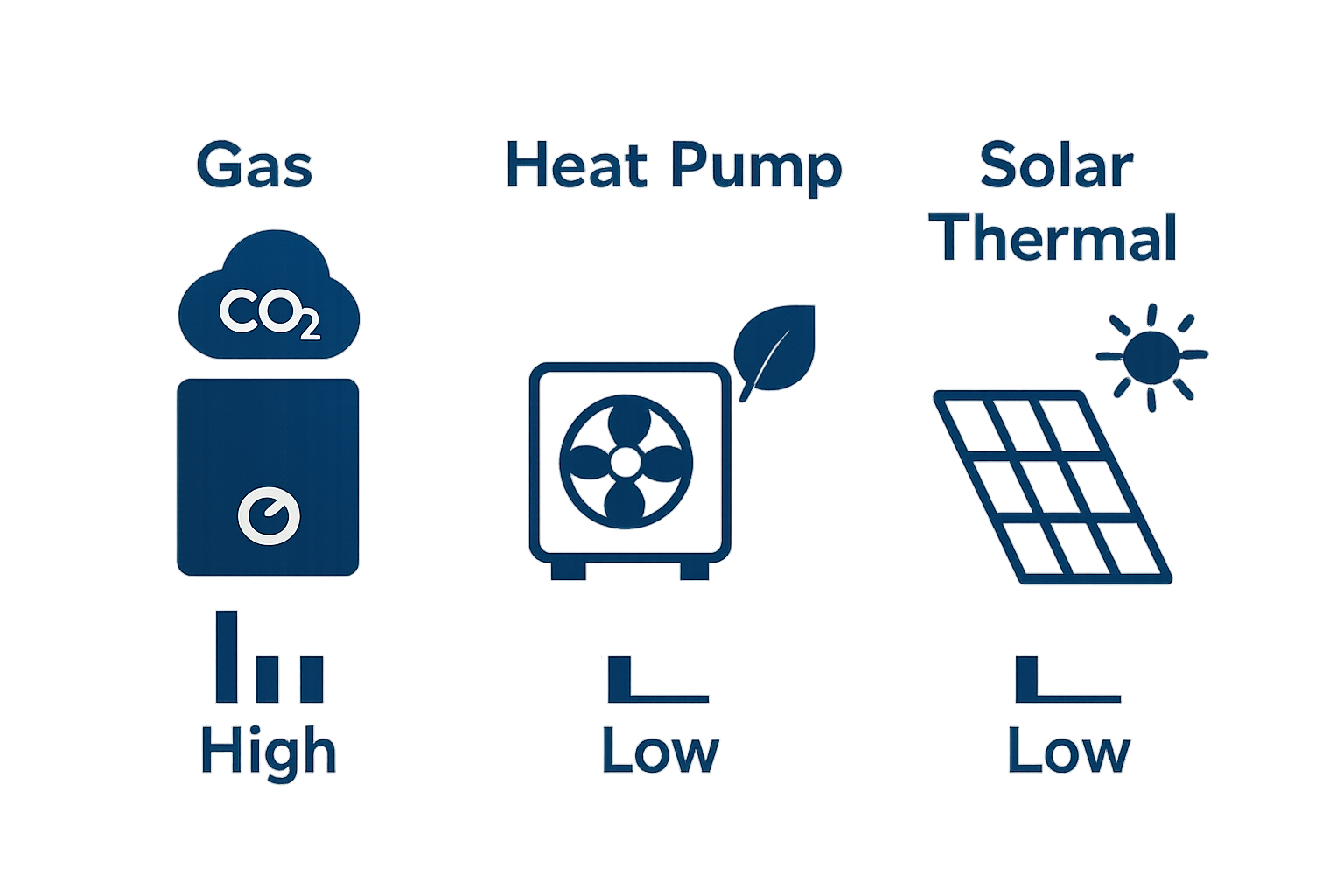
Our comprehensive heat pump installation guide provides deeper insights into the technical nuances of these innovative heating technologies for residents in Edinburgh and Midlothian.
The ongoing evolution of sustainable heating technologies represents a critical pathway towards decarbonising residential and commercial heating infrastructure. By continually advancing energy capture, transfer, and management methodologies, these technologies promise a more sustainable and environmentally responsible approach to thermal comfort.
Real-World Applications of Sustainable Heating Systems
Sustainable heating technologies have transitioned from theoretical concepts to practical solutions that are transforming residential, commercial, and industrial heating landscapes. These innovative systems demonstrate remarkable versatility across diverse environmental contexts and property types.
Residential Implementation Strategies
Domestic heating applications represent the most immediate and impactful arena for sustainable heating technologies. Homeowners are increasingly adopting solutions like air source heat pumps and solar thermal systems to reduce energy costs and minimise carbon footprints. Modern sustainable heating systems can be seamlessly integrated into existing properties, offering retrofitting options that do not require complete infrastructure overhauls.
According to the Energy Saving Trust, residential sustainable heating technologies can deliver significant environmental and economic benefits. Key residential implementation considerations include:
- Compatibility with existing building infrastructure
- Potential for substantial energy bill reductions
- Minimal disruption during installation
- Adaptability to different property types and sizes
Commercial and Industrial Applications
Beyond residential settings, sustainable heating systems are revolutionising commercial and industrial thermal management. Sectors such as hospitality, healthcare, education, and manufacturing are discovering substantial efficiency gains through advanced heating technologies. These solutions offer scalable approaches that can be tailored to complex operational requirements, from small office spaces to large industrial complexes.
Our comprehensive heat pump installation guide provides detailed insights into practical implementation strategies for Edinburgh and Midlothian businesses seeking sustainable heating solutions.
The real-world success of sustainable heating technologies demonstrates their potential to drive meaningful environmental change. By bridging innovative engineering with practical energy management, these systems are not just theoretical solutions but tangible pathways towards a more sustainable future.
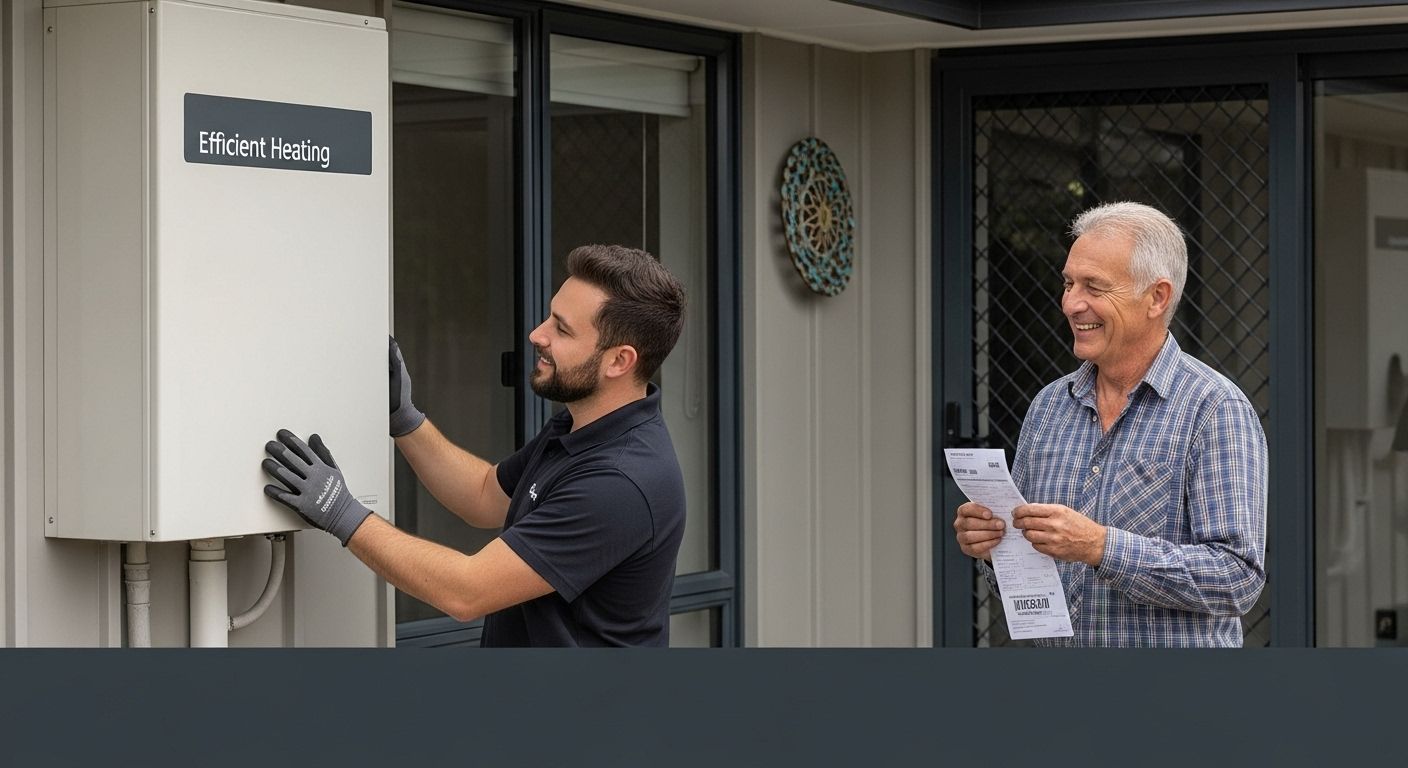
Ready to Make Your Heating Truly Sustainable and Efficient?
Are you concerned about the rising costs and carbon emissions of traditional heating systems? If you found our article insightful, you likely understand the serious impact inefficient heating can have not just on your bills but also on the environment. Thermatek Heating specialises in upgrading outdated systems with next-generation solutions such as air source heat pumps and solar thermal technology—offering reliable comfort while keeping your carbon footprint and expenses low. Our team of Gas Safe Registered engineers guide you through every step, from assessment to installation, ensuring your home in Edinburgh or Midlothian benefits from expert service and maximum efficiency.

Take your first step to a greener, more cost-effective future today. Explore our heat pump installation options or browse our full range of renewable energy solutions. If you are ready for a personal consultation or have questions, visit Thermatek Heating to get your free quote. Act now to secure long-term savings and environmental peace of mind.
Frequently Asked Questions
What are the primary benefits of sustainable heating systems?
Sustainable heating systems offer numerous benefits, including significant reductions in carbon emissions, lower long-term operational costs, improved energy efficiency, and enhanced air quality. They utilise renewable energy sources, making them environmentally responsible alternatives to traditional heating methods.
How do sustainable heating systems operate?
Sustainable heating systems operate by harnessing renewable energy sources, such as air, ground, or solar energy. They extract existing heat from these sources and concentrate it to produce thermal comfort in homes and buildings. Technologies like heat pumps, solar thermal systems, and biomass boilers exemplify this process.
What types of technologies are considered sustainable heating systems?
The main types of sustainable heating technologies include air source heat pumps, ground source heat pumps, solar thermal systems, and biomass boilers. Each technology has unique features and benefits tailored to different heating needs and property types.
Can sustainable heating systems be integrated into existing buildings?
Yes, many sustainable heating systems can be seamlessly integrated into existing buildings. Retrofits are often possible, allowing homeowners to upgrade their heating solutions without the need for complete infrastructure overhauls, making it a practical choice for enhancing energy efficiency.
Recommended
- News
- Air Source Heat Pump Installation In Edinburgh
- Solar Thermal Installers In Edinburgh
- Local Heating Installer Kicks Off His New Business With £500 Birthday Present
- What is a Tankless System? Understanding Its Benefits - 8th Bend Plumbing Heating and Cooling
- Technology Lost to Time X
Essential Air Source Heat Pump Maintenance for Efficiency
Maintaining an air source heat pump might sound like a technical headache, but the truth is, even a little regular care can make a massive difference. Most people have no idea that regular cleaning and filter checks can extend a heat pump’s life by several years and help maintain its efficiency. Surprisingly, it is the simple steps at home—not just the annual visits from a professional—that keep these systems running smoothly while saving you money on repairs.
Table of Contents
- Step 1: Gather Necessary Tools And Materials
- Step 2: Turn Off The Power Supply Safely
- Step 3: Inspect And Clean The Outdoor Unit
- Step 4: Check And Replace Filters Regularly
- Step 5: Verify System Performance And Efficiency
- Step 6: Schedule Professional Inspections Annually
Quick Summary
| Key Point | Explanation |
|---|---|
| 1. Gather essential maintenance tools | Collect specific equipment like brushes, cloths, and vacuum cleaners for effective heat pump upkeep. |
| 2. Always turn off power before maintenance | Safely disconnect electrical supply to prevent hazards and protect the system during servicing. |
| 3. Regularly clean the outdoor unit | Inspect and clean the outdoor unit to maintain efficiency and prevent long-term damage. |
| 4. Replace air filters frequently | Clean or replace filters every 3-6 months to improve air quality and system performance. |
| 5. Schedule annual professional inspections | Hire qualified technicians for thorough annual assessments, enhancing system longevity and performance. |
Step 1: Gather Necessary Tools and Materials
Preparing for air source heat pump maintenance requires careful planning and the right equipment. Before diving into the maintenance process, homeowners must collect specific tools and materials that will ensure a safe and effective service. Proper preparation minimises potential damage and helps maintain the heat pump’s optimal performance.
The first step involves assembling a comprehensive toolkit designed specifically for heat pump maintenance. You will need several essential items to complete the task professionally. Your toolkit should include:
- Soft bristle brush for delicate cleaning
- Vacuum cleaner with soft attachment
- Protective work gloves
- Clean microfibre cloths
- Manufacturer’s maintenance guide
- Compressed air canister (optional)
According to the Energy Saving Trust, safety should be your primary consideration. Before beginning any maintenance, ensure the heat pump is completely powered off at the electrical circuit breaker. This crucial step prevents potential electrical accidents and protects both you and the equipment.
Carefully review your heat pump’s specific manufacturer documentation, as different models might have unique maintenance requirements. Some systems may need specialised cleaning solutions or have specific areas that require extra attention. Understanding these nuanced details prevents accidental damage and ensures you follow the manufacturer’s recommended maintenance protocols.
Your protective gear is equally important. Work gloves will shield your hands from potential sharp edges or dirt, while clean microfibre cloths will help you wipe surfaces without leaving residue. The soft bristle brush allows gentle removal of dust and debris from delicate components without causing scratches or mechanical damage.
By meticulously gathering these tools and preparing your workspace, you set the foundation for a successful air source heat pump maintenance session. The next steps will build upon this careful preparation, guiding you through a comprehensive service that maintains your system’s efficiency and longevity.
Below is a summary of essential tools and materials required for effective air source heat pump maintenance.
| Tool/Material | Purpose | Notes/Special Considerations |
|---|---|---|
| Soft bristle brush | Gentle cleaning of delicate components | Avoid hard bristles; prevents scratches |
| Vacuum cleaner with soft attachment | Removes loose dust and debris | Use a soft or brush attachment for safety |
| Protective work gloves | Shields hands from sharp edges and dirt | Wear during all cleaning steps |
| Clean microfibre cloths | Wipes surfaces without leaving residue | Use fresh cloths to avoid re-depositing dust |
| Manufacturer’s maintenance guide | Reference for model-specific requirements | Check for any unique procedures per model |
| Compressed air canister (optional) | Blows away dust from hard-to-reach areas | Use gently and with caution; optional item |
Step 2: Turn Off the Power Supply Safely
Before beginning any air source heat pump maintenance, safely disconnecting the electrical power is absolutely critical. This step protects you from potential electrical hazards and prevents accidental system damage during your maintenance procedure. Proper power isolation requires careful attention and methodical execution.
Locate your home’s primary electrical panel or circuit breaker box. This is typically situated in a utility room, garage, or basement. Identify the specific circuit breaker designated for your heat pump system. Most modern heat pump installations have a dedicated circuit breaker, usually labelled with terms like “heat pump” or “outdoor unit”.
According to the National Occupational Standards, safe electrical isolation involves a systematic approach. Begin by switching off the circuit breaker completely. This means moving the breaker switch fully to the “off” position. Do not simply reduce power or leave it in a mid-position.
After switching off the circuit breaker, perform a crucial verification step. Use a non-contact voltage tester near the heat pump’s electrical connections to confirm zero electrical current. This additional check provides an extra layer of safety, ensuring no residual electricity remains in the system.
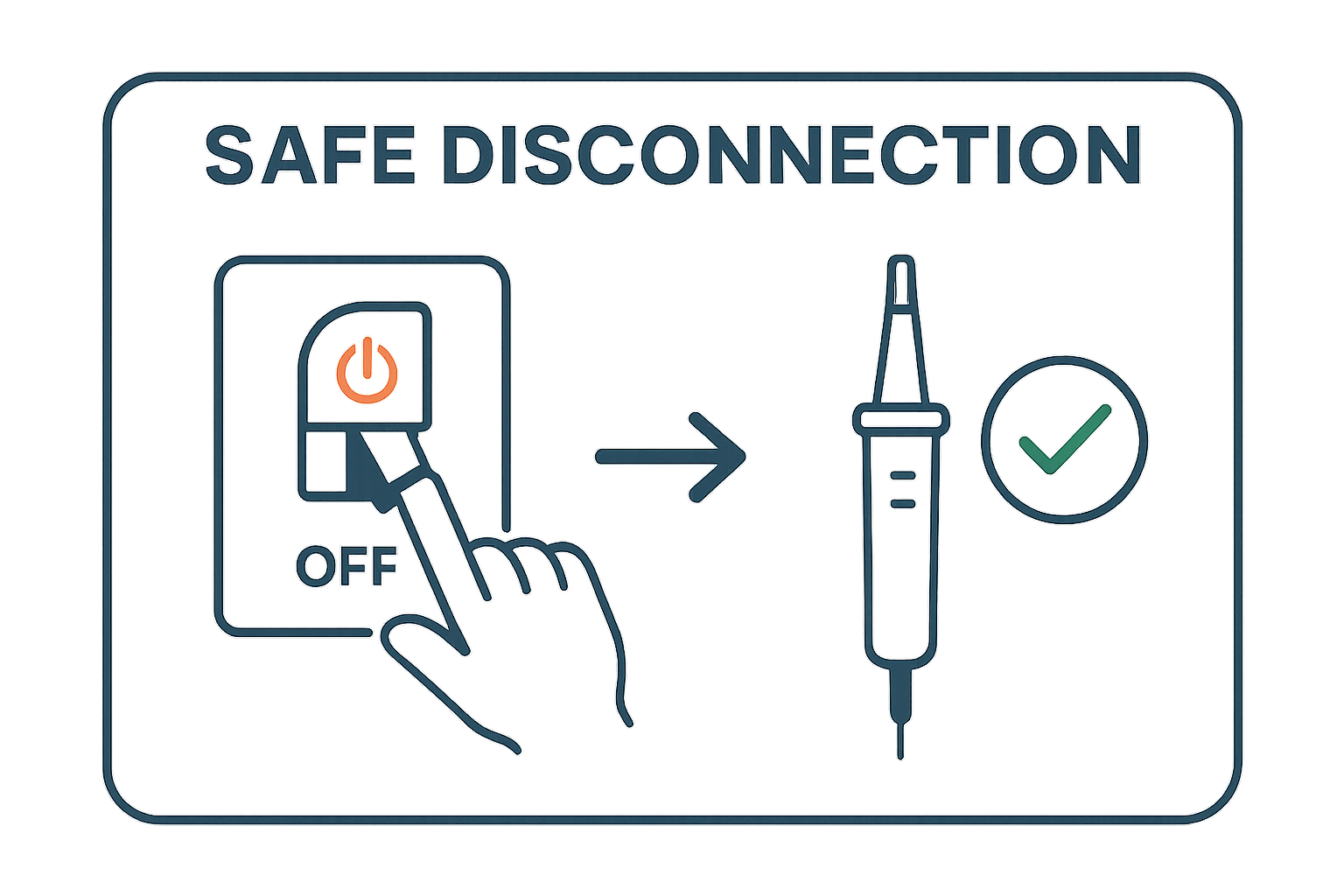 Remember: never assume a circuit is dead without proper testing.
Remember: never assume a circuit is dead without proper testing.
If you are uncertain about identifying the correct circuit breaker or lack confidence in electrical safety procedures, consult a professional heating engineer. Some heat pump systems might have multiple power feeds or complex electrical setups that require specialised knowledge.
Once you have confirmed the power is completely off, place a temporary warning tag or piece of tape on the circuit breaker. This simple action prevents accidental re-energisation while you are working on the system. Your warning tag should clearly indicate that maintenance is in progress and the circuit should not be switched on.
By meticulously following these power isolation steps, you create a safe working environment for your heat pump maintenance. The next stages of your maintenance process can now proceed with significantly reduced risk of electrical accidents or system damage.
Step 3: Inspect and Clean the Outdoor Unit
The outdoor unit of an air source heat pump is continuously exposed to environmental elements, making regular inspection and cleaning fundamental to maintaining system efficiency. This critical maintenance step ensures optimal performance and prevents potential long-term damage.
Begin by carefully examining the entire exterior of the outdoor unit. Look for any visible signs of damage, such as dents, cracks, or corrosion on the unit’s casing. Pay special attention to the surrounding area, checking that no vegetation has grown too close or that no debris has accumulated around the unit’s base.
According to Changeworks, annual checks are crucial for maintaining system performance. Using your soft bristle brush, gently remove any accumulated dirt, fallen leave, or debris from the unit’s exterior and around its base. Be particularly careful around the air intake grill and evaporator components.
Your cleaning process should be methodical and gentle. Start by using the soft brush to loosen any loose dirt or debris. Follow this with your vacuum cleaner’s soft attachment to remove the loosened particles. Avoid using high-pressure water or harsh cleaning chemicals, as these can damage the delicate components of the heat pump.
Inspect the unit’s fins carefully. These thin metal pieces can easily become bent or damaged, which impacts the heat pump’s efficiency. If you notice any bent fins, use a fin comb (available at most hardware stores) to carefully straighten them. Work slowly and gently to avoid causing additional damage.
Check the drainage areas and condensate lines to ensure they are clear and unobstructed. Any blockages can lead to water buildup and potential system issues. Look for signs of water staining or unusual moisture around the unit that might indicate drainage problems.
Once you have completed the cleaning, step back and do a final visual inspection. The outdoor unit should look clean, with no visible debris and no signs of damage or unusual wear. Ensure there is at least 30 centimetres of clear space around the unit to allow proper air circulation. This final verification step confirms that your maintenance has been thorough and effective, setting the stage for the next phase of your air source heat pump service.
Step 4: Check and Replace Filters Regularly
Filter maintenance is a critical component of air source heat pump efficiency, directly impacting system performance and indoor air quality. Clean filters are the first line of defence against dust, debris, and potential system inefficiencies. Neglecting this simple maintenance task can lead to reduced heating performance and increased energy consumption.
Begin by locating the air filters in your heat pump system. Most units have filters positioned in the indoor air handling unit or return air grille. Carefully remove the filter cover, taking care not to damage any surrounding components. Inspect the filter thoroughly, looking for visible signs of dirt accumulation, discolouration, or physical damage.
The frequency of filter replacement depends on several factors, including environmental conditions, usage, and manufacturer recommendations. Generally, most residential heat pump systems require filter replacement or cleaning every three to six months. Homes with pets, high dust levels, or frequent cooking may need more frequent filter changes.
Carefully remove the old filter, noting its exact size and type. Take a clear photo or make a note of the filter specifications to ensure you purchase the correct replacement. When handling used filters, wear protective gloves and avoid shaking them, as this can release trapped dust and allergens into the air.
If the filter is a washable type, clean it carefully using lukewarm water and a mild detergent. Allow the filter to dry completely before reinstalling. For disposable filters, simply discard the old one and install a new, matching filter. Ensure the filter is inserted in the correct orientation, paying attention to any directional arrows indicating airflow direction.
While replacing the filter, take a moment to inspect the filter housing. Clean any dust or debris from the surrounding area using a soft cloth or vacuum cleaner with a soft attachment. A clean filter housing helps maintain optimal airflow and system efficiency.
Finish by securely replacing the filter cover, ensuring it fits snugly without any gaps. Perform a quick system check to confirm everything is properly seated. Signs of a successful filter replacement include smooth airflow, no unusual noises, and a general sense of improved air quality.
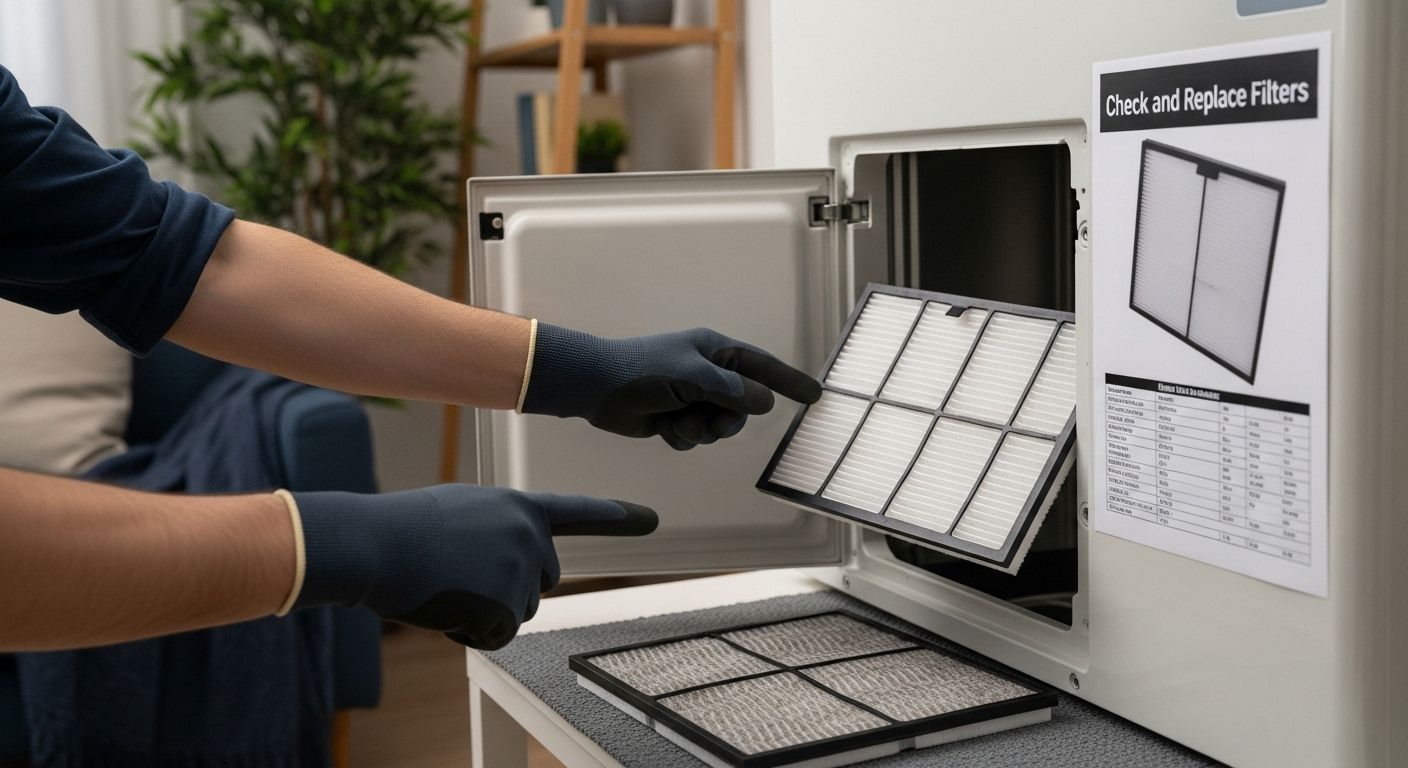
Regular filter maintenance is a simple yet powerful way to extend the life of your air source heat pump, improve energy efficiency, and maintain a healthy indoor environment. Mark your calendar or set a reminder to check and replace filters consistently, transforming this task into a reliable part of your home maintenance routine.
Step 5: Verify System Performance and Efficiency
After completing the previous maintenance steps, verifying your air source heat pump’s overall performance and efficiency becomes crucial. This final diagnostic process ensures that all your maintenance efforts have optimised the system’s functionality. Systematic performance verification helps identify potential issues before they escalate into costly repairs.
Start by powering the system back on and allowing it to run through a complete heating cycle. Listen carefully for any unusual sounds that might indicate mechanical problems. Normal operation should involve smooth, consistent airflow with minimal noise. Pay attention to how quickly the system reaches the desired temperature and maintains it.
According to the UK Government’s Air Conditioning Inspection Guidelines, regular performance assessments are essential for maintaining system efficiency. Monitor your heat pump’s energy consumption using either the integrated display or your home’s energy monitoring system. Compare current energy usage with previous bills to determine if the maintenance has improved overall efficiency.
Check the thermostat settings and ensure they respond correctly to temperature adjustments. Verify that the heat pump switches between modes smoothly and maintains consistent temperature levels. A well-functioning system should adapt quickly to temperature changes without significant lag or excessive cycling.
Inspect the refrigerant levels, though this might require professional equipment. Signs of potential refrigerant issues include reduced heating performance, ice formation on external units, or unusual hissing sounds. If you suspect refrigerant problems, contact a professional heating engineer for a detailed assessment.
Make a detailed record of your observations. Note the date of maintenance, any components replaced, and your performance findings. This documentation becomes valuable for future maintenance sessions and can help track the system’s long-term performance trends.
Finally, clean up your workspace and ensure all protective covers and panels are securely replaced. Your comprehensive maintenance routine has not only preserved the heat pump’s efficiency but also extended its operational lifespan. Regular, thorough maintenance like this prevents unexpected breakdowns and maintains optimal home heating performance.
Step 6: Schedule Professional Inspections Annually
Despite your diligent personal maintenance efforts, professional annual inspections remain a critical component of comprehensive air source heat pump care. These expert assessments provide a deep diagnostic review that goes beyond routine homeowner maintenance, uncovering potential issues before they transform into expensive repairs.
Begin by researching qualified heating engineers specialising in air source heat pump systems. Look for professionals with specific credentials such as Gas Safe Registration and manufacturers’ specific certifications. Recommendations from the manufacturer or local heating associations can guide you towards reputable technicians.
According to UK Government Guidance, professional inspections are crucial for maintaining system efficiency. When scheduling your annual inspection, prepare documentation about your heat pump’s model, previous maintenance records, and any performance observations you’ve noted during your personal maintenance checks.
A comprehensive professional inspection typically involves several critical assessments. The technician will conduct a thorough examination of electrical connections, refrigerant levels, system pressures, and mechanical component conditions. They will use specialised diagnostic equipment to measure system performance metrics that are not accessible through standard homeowner maintenance.
During the inspection, request a detailed report outlining the system’s current condition. This documentation serves multiple purposes: it provides a professional assessment of your heat pump’s health, identifies potential future maintenance requirements, and creates a historical record of the system’s performance over time.
Financial planning is an important consideration. Professional inspections represent an investment in your heating system’s longevity. While the cost might seem unnecessary, these annual check-ups can prevent significant repair expenses by identifying and addressing minor issues before they escalate.
Ensure the inspection includes comprehensive testing of all system components, including electrical systems, mechanical parts, refrigerant levels, and overall energy efficiency. A high-quality professional inspection goes beyond a simple visual check, providing a holistic assessment of your air source heat pump’s operational status.
By consistently scheduling these annual professional inspections, you transform your approach from reactive maintenance to proactive system management. This strategy ensures your air source heat pump continues operating at peak efficiency, delivering reliable heating while minimising unexpected breakdowns and extending the system’s operational lifespan.
Use the following table as a step-by-step overview of the main maintenance tasks, including their estimated difficulty and key outcomes.
| Step | Estimated Difficulty | Key Outcome |
|---|---|---|
| Gather necessary tools and materials | Easy | Prepared and safe workspace for maintenance |
| Turn off the power supply safely | Medium | Safe environment, electrical hazards eliminated |
| Inspect and clean the outdoor unit | Medium | Debris removed, optimal airflow, external unit protected |
| Check and replace filters regularly | Easy | Improved air quality and system performance |
| Verify system performance and efficiency | Medium | Ensures recent maintenance improved operation |
| Schedule professional inspections annually | Medium | Deep diagnostic assessment, preventative maintenance |
Secure Lasting Efficiency for Your Air Source Heat Pump
Do you feel uncertain about maintaining your air source heat pump at its best? This article highlights how missed maintenance or incorrect steps can result in lost efficiency, higher bills and unexpected repairs. If you worry about safely inspecting components or feel unsure when it is time for professional help, you are not alone. Many homeowners struggle to keep up with the details of regular filter changes, outdoor unit cleaning and annual safety checks. You deserve peace of mind and lasting warmth in your home, no matter what the Scottish weather brings. If you want your heat pump to deliver maximum efficiency and reliable comfort all year, the right specialist makes all the difference.

Let Thermatek’s Gas Safe Registered engineers take the stress out of your heat pump maintenance. Enjoy the confidence of comprehensive care, from routine inspections right through to urgent repairs and system upgrades. See what sets us apart in Edinburgh and Midlothian by visiting our main website or hear directly from our satisfied clients on the customer testimonials page. Schedule your next maintenance visit now and avoid costly breakdowns in the future. Reach out for a free quote today and keep your heat pump running smoothly all year round.
Frequently Asked Questions
What tools are needed for air source heat pump maintenance?
You will need a soft bristle brush, a vacuum cleaner with a soft attachment, protective work gloves, clean microfibre cloths, the manufacturer’s maintenance guide, and optionally a compressed air canister.
How often should I check and replace my heat pump filters?
Filters should be checked and replaced or cleaned every three to six months. Homes with pets or high dust levels may require more frequent changes.
Why is it important to turn off the power supply before maintenance?
Turning off the power supply ensures safety by preventing electrical hazards and accidental damage to the heat pump during maintenance.
What are the signs that my air source heat pump needs professional inspection?
Signs include unusual sounds during operation, reduced heating performance, ice formation on the outdoor unit, or irregularities in airflow. If you notice these issues, it’s best to consult a heating engineer.
Recommended
- Air Source Heat Pump Installation In Edinburgh
- Central Heating Power Flushing In Edinburgh
- Annual Boiler Servicing In Edinburgh
- News
Understanding Plumbing Leak Detection: Why It Matters
Plumbing leaks might sound like a minor household nuisance but they are anything but trivial once you look closer. The numbers are hard to ignore. A single dripping toilet can waste up to 400 litres of water each day and about 10 percent of UK homes lose water to hidden leaks without even realising it. Most property owners assume damage comes from sudden flooding but it is actually these slow, silent leaks that quietly drain your finances and can end up costing more than most major pipe bursts ever will.
Table of Contents
- What Is Plumbing Leak Detection And Its Importance?
- Why Timely Leak Detection Matters For Properties
- How Plumbing Leak Detection Techniques Work
- Key Concepts And Technologies In Leak Detection
- Real-World Implications Of Ignoring Plumbing Leaks
Quick Summary
| Takeaway | Explanation |
|---|---|
| Invest in leak detection services | Proactive monitoring prevents costly repairs and structural damage from unforeseen leaks. |
| Utilise advanced detection technologies | Employ methods like thermal and acoustic sensing to identify leaks undetected by visual inspections. |
| Address leaks immediately to reduce risks | Timely interventions prevent mould growth, structural deterioration, and potential health hazards. |
| Understand the financial implications of leaks | Unresolved leaks lead to extensive repair costs and can significantly reduce property value. |
| Leak monitoring supports water conservation | Regular checks help manage resources and reduce unnecessary water waste, contributing to environmental protection. |
What is Plumbing Leak Detection and Its Importance?
Plumbing leak detection represents a crucial preventative maintenance strategy designed to identify water leakage within residential and commercial property pipework systems before substantial damage occurs. This sophisticated approach combines technological tools, expert techniques, and strategic monitoring to pinpoint potential water escape points across complex plumbing networks.
Understanding the Core Mechanics of Leak Detection
Modern plumbing leak detection involves multiple sophisticated methodologies that go far beyond traditional visual inspections. Water UK reports advanced techniques now include:
- Acoustic sensor technology that listens for unusual water flow sounds
- Satellite imaging for tracking underground pipe infrastructure
- Thermal imaging cameras detecting temperature variations indicating water movement
- Smart metering systems monitoring unusual water consumption patterns
These technologies enable professionals to identify even microscopic leaks that might remain undetected through conventional assessment methods. The precision of these techniques means potential water damage can be intercepted before causing significant structural or financial harm.
Below is a summary table comparing advanced plumbing leak detection technologies and their key features. This helps illustrate the diverse approaches available for identifying leaks in modern pipe systems.
| Technology | Key Feature | Detects Hidden Leaks? | Typical Use Case |
|---|---|---|---|
| Acoustic Sensor Technology | Listens for unusual water flow sounds | Yes | Locating leaks in inaccessible pipes |
| Satellite Imaging | Tracks underground pipe infrastructure | Yes | Large-scale underground networks |
| Thermal Imaging Cameras | Detects temperature variations | Yes | Walls, floors, and underground |
| Smart Metering Systems | Monitors unusual consumption patterns | Yes | Continuous property-wide monitoring |
Why Leak Detection Matters for Property Owners
According to Waterwise, approximately 10% of homes and 25% of businesses in the UK experience internal leaks that waste substantial water volumes annually. These undetected leaks pose multiple risks:
- Structural damage to walls, floors, and foundations
- Potential mould and mildew development
- Significant financial losses through water wastage
- Increased insurance claim risks
- Potential long-term property value reduction
Effective plumbing leak detection transforms these potential risks into manageable maintenance scenarios. By identifying and addressing leaks early, property owners can prevent expensive repairs, conserve water resources, and maintain their property’s structural integrity. The investment in professional leak detection services represents a proactive approach to property management, offering both immediate and long-term financial and structural benefits.
Why Timely Leak Detection Matters for Properties
Timely leak detection represents a critical strategy for property preservation, financial protection, and environmental responsibility. Property owners who proactively monitor and address potential water leakage can mitigate substantial risks that could otherwise lead to extensive damage, significant financial losses, and complex repair challenges.
Financial and Structural Consequences of Delayed Detection
South Tyneside Council emphasizes that unaddressed plumbing leaks can cause severe structural damage, potentially leading to catastrophic outcomes such as:
- Rotting of wooden joists and floorboards
- Potential structural collapse in extreme scenarios
- Compromised building foundation integrity
- Extensive water damage to internal walls and ceilings
- Rapid deterioration of building materials
The financial implications of delayed leak detection extend far beyond immediate repair costs. Undetected water leakage can create long-term structural vulnerabilities that dramatically reduce a property’s market value and require extensive, expensive remediation.
Environmental and Resource Conservation Impact
WaterSafe highlights the profound resource wastage associated with undetected leaks. A seemingly minor leak, such as a dripping toilet, can waste up to 400 litres of water daily, potentially increasing annual water bills by approximately 300. This wastage not only represents a significant financial burden but also contributes to unnecessary environmental resource depletion.
Beyond the immediate financial consequences, unaddressed leaks contribute to broader environmental challenges. Water conservation becomes increasingly crucial in an era of climate uncertainty, making proactive leak detection a responsible approach to resource management.
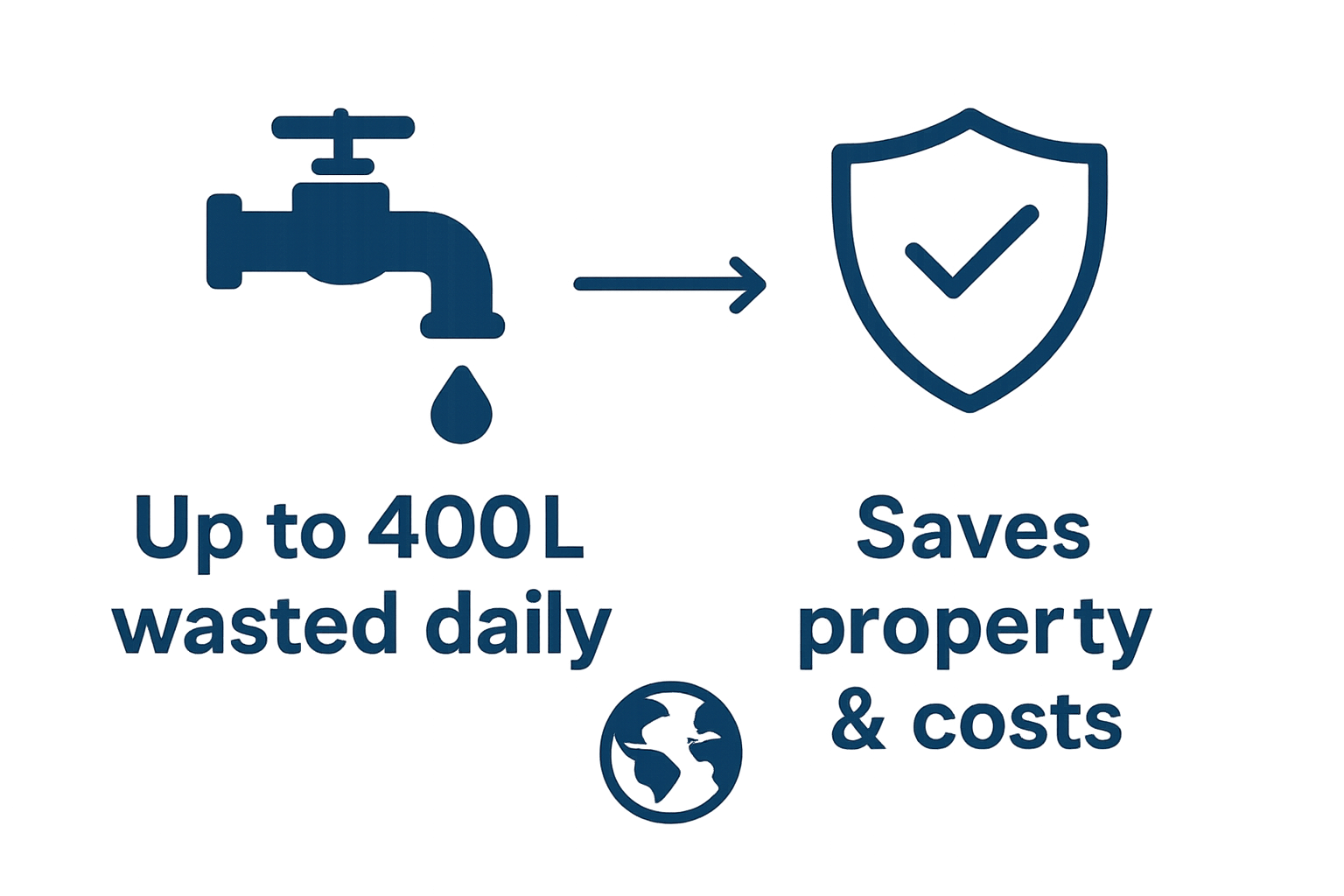 Property owners who invest in regular leak monitoring demonstrate a commitment to sustainable practices, reducing unnecessary water consumption and supporting broader environmental conservation efforts.
Property owners who invest in regular leak monitoring demonstrate a commitment to sustainable practices, reducing unnecessary water consumption and supporting broader environmental conservation efforts.
How Plumbing Leak Detection Techniques Work
Plumbing leak detection represents a sophisticated technological process combining multiple advanced methodologies to identify and locate water leakage within complex pipe networks. These techniques leverage cutting-edge scientific principles and innovative technological tools to provide precise, comprehensive assessments of potential water system vulnerabilities.
Advanced Acoustic and Digital Monitoring Technologies
University of Southampton highlights emerging acoustic sensing technologies that revolutionise leak detection capabilities. These advanced systems utilise specialised sensors that:
- Capture minute sound frequencies generated by water escaping from pipes
- Analyse pressure variations within pipe networks
- Differentiate between normal water flow and potential leak signatures
- Create detailed digital maps of potential problem areas
Digital acoustic monitoring enables professionals to detect microscopic leaks that might remain invisible through traditional inspection methods. The precision of these technologies allows for early intervention, preventing potential extensive water damage and infrastructure deterioration.
Thermal and Visual Inspection Methods
Modern leak detection incorporates multiple complementary techniques beyond acoustic monitoring. Thermal imaging cameras play a crucial role in identifying hidden water leakage by detecting temperature variations that indicate moisture presence. These cameras can penetrate walls, floors, and underground structures, revealing potential leak points that conventional visual inspections might miss.
Infrared thermographic scanning provides real-time temperature mapping, enabling technicians to pinpoint exact locations where water might be escaping. By capturing subtle heat differential patterns, these advanced imaging techniques transform leak detection from reactive maintenance to a proactive, data-driven approach to property preservation.
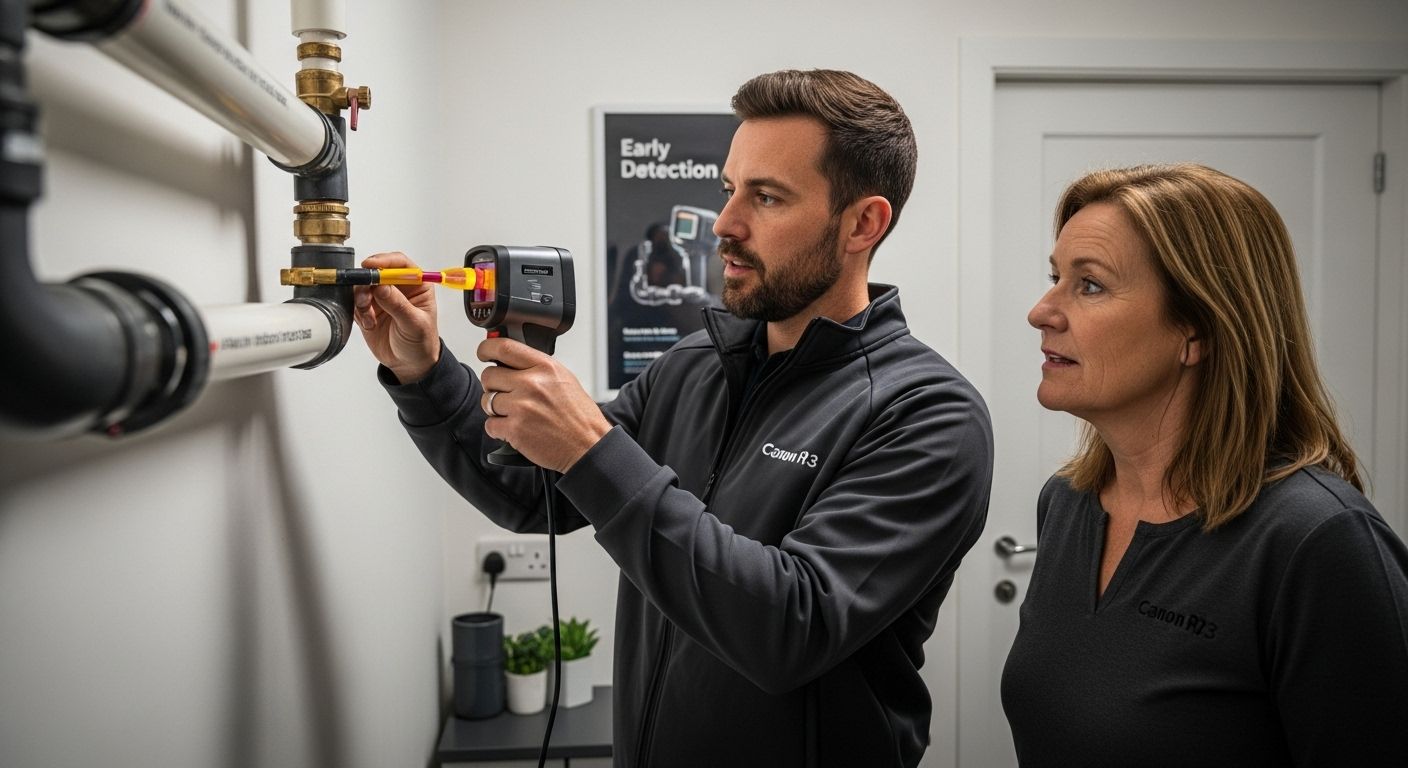
Key Concepts and Technologies in Leak Detection
Leak detection represents a sophisticated intersection of engineering, technology, and scientific principles designed to identify and mitigate water system vulnerabilities. Modern approaches transform traditional maintenance strategies through innovative diagnostic technologies that provide unprecedented precision and early intervention capabilities.
Fundamental Technological Principles
National Infrastructure Commission highlights the fundamental technological principles underlying contemporary leak detection methodologies. These principles emphasise understanding water system dynamics through:
- Comprehensive pressure mapping
- Sophisticated signal processing techniques
- Real-time data monitoring and analysis
- Advanced computational modelling
- Predictive algorithmic assessments
These foundational technologies enable professionals to move beyond reactive maintenance towards a proactive, data-driven approach. By capturing minute variations in water flow, pressure, and system performance, technicians can predict and prevent potential leakage before significant damage occurs.
Emerging Detection Technologies
Contemporary leak detection integrates multiple cutting-edge technologies that dramatically enhance diagnostic capabilities. Smart sensor networks now provide continuous monitoring, collecting granular data about water system performance. These intelligent systems can distinguish between normal operational variations and potential leak indicators with remarkable accuracy.
Innovative technologies like machine learning algorithms and artificial intelligence are increasingly being deployed to analyse complex water infrastructure data. These advanced systems can identify subtle patterns and anomalies that might escape human detection, offering a new frontier in predictive maintenance and infrastructure management. By transforming raw data into actionable insights, these technologies represent a significant leap forward in our ability to understand and manage water distribution systems.
Real-World Implications of Ignoring Plumbing Leaks
Ignoring plumbing leaks can transform seemingly minor maintenance issues into catastrophic property damage scenarios with far-reaching financial, structural, and health consequences. Property owners who delay addressing water leakage risk exponential escalation of potential problems that extend well beyond initial repair costs.
Structural Degradation and Property Value Impact
Building Research Establishment indicates that unaddressed water leaks can cause progressive structural deterioration, compromising fundamental building integrity. Prolonged moisture exposure leads to multiple critical challenges:
- Systematic weakening of foundational structures
- Progressive timber rot in supporting frameworks
- Accelerated concrete and masonry degradation
- Compromised electrical systems
- Potential ground settlement and structural shifts
These cumulative damages can dramatically reduce property market value, potentially creating scenarios where repair costs significantly exceed the property’s original worth. Insurers increasingly view persistent water damage as a critical risk factor, potentially affecting future insurance coverage and premium rates.
Health and Environmental Consequences
Beyond structural implications, unresolved plumbing leaks generate substantial health risks through mould proliferation and environmental contamination. Persistent moisture creates ideal breeding environments for harmful microorganisms, potentially causing respiratory complications and allergic reactions. Water damage can introduce toxic substances into living environments, compromising indoor air quality and potentially triggering long-term health challenges for residents. The environmental impact extends to water resource wastage, with even minor leaks contributing to substantial municipal water system strain and unnecessary resource consumption.
The following table outlines the potential consequences of ignoring plumbing leaks, helping property owners understand the range of risks and damages associated with unaddressed leakage.
| Consequence Type | Description |
|---|---|
| Structural Degradation | Weakening of foundations, timber rot, and accelerated material decay |
| Financial Losses | Increased repair costs, reduced property value, higher insurance |
| Health Risks | Mould growth and respiratory health issues |
| Environmental Impact | Unnecessary water wastage and resource depletion |
Protect Your Edinburgh Property from Hidden Plumbing Leaks
Worried about undetected plumbing leaks causing damage to your home or rental property? The article highlights how even small leaks can swiftly escalate into significant structural problems, mould issues and sky-high water bills. Many residents in Edinburgh and Midlothian experience these challenges due to unnoticed leaks in their plumbing systems. Advanced leak detection is essential to prevent long-term damage and safeguard your investment, especially when you rely on the expertise of trusted professionals.

Do not let unseen water leaks threaten your property’s safety or value. The Thermatek Heating & Plumbing team uses the latest techniques featured in this article – such as acoustic leak detection and thermal imaging – to find and fix problems before they become expensive disasters. Our Gas Safe Registered engineers serve Edinburgh and Midlothian, with a focus on reliability, compliance and outstanding customer care. Take action today to secure your home with a free expert assessment and see why so many local clients trust us for all their plumbing and maintenance needs. Visit our website to request your quote or contact us for fast support. Now is the ideal time to address hidden leaks and ensure your property stays protected for years to come.
Frequently Asked Questions
What is plumbing leak detection?
Plumbing leak detection is a proactive maintenance strategy that employs advanced technologies to identify leaks in residential and commercial plumbing systems before they cause significant damage.
Why is timely leak detection important for property owners?
Timely leak detection is crucial as it helps prevent structural damage, mould growth, and water wastage, ultimately protecting property value and saving on potential repair costs.
What technologies are used in plumbing leak detection?
Modern plumbing leak detection uses a variety of advanced technologies, including acoustic sensors, thermal imaging cameras, and smart metering systems, to accurately identify and locate leaks within complex piping networks.
How can ignoring plumbing leaks affect my property?
Ignoring plumbing leaks can lead to severe structural degradation, increased repair costs, health risks due to mould, and significant financial losses from water wastage, ultimately impacting the property’s value.
Recommended
Understanding Hydronic Heating Systems: How They Work
Hydronic heating systems are quietly transforming how homes and workplaces stay warm. Most people have felt the chill from uneven forced air or dreaded the dry air from traditional radiators. Yet, with water as its heat carrier, a well-designed hydronic system can be up to 30 percent more energy efficient than standard options, creating evenly distributed comfort and lower running costs. This isn’t just about warmth or savings. It is a smarter, cleaner approach that’s set to change how we think about staying comfortable indoors.
Below is a comparison table outlining the key differences between hydronic heating systems and traditional forced air heating systems, helping to clarify their respective advantages and limitations.
| Aspect | Hydronic Heating Systems | Traditional Forced Air Systems |
|---|---|---|
| Heat Transfer Medium | Water | Air |
| Heat Distribution | Radiators, underfloor pipes, panels | Ductwork, vents |
| Energy Efficiency | Up to 30% more efficient | Lower, with higher energy waste |
| Comfort Level | Even, consistent warmth | Prone to drafts, uneven temperatures |
| Impact on Air Quality | Minimal dust and allergen circulation | Can circulate dust and allergens |
| Installation Complexity | More involved, especially when retrofitting | Generally easier in existing setups |
Table of Contents
- What Are Hydronic Heating Systems And How Do They Function?
- The Importance Of Hydronic Heating Systems In Modern Homes
- Key Components Of Hydronic Heating Systems Explained
- Benefits And Considerations Of Using Hydronic Heating
- The Future Of Hydronic Heating Systems In Energy Efficiency
Quick Summary
| Takeaway | Explanation |
|---|---|
| Hydronic systems use water for heating | These systems circulate heated water through pipes, offering efficient warmth without air movement. |
| Energy efficiency improves comfort and reduces costs | Hydronic heating can lower energy bills by up to 30% compared to traditional heating systems. |
| Flexible heating delivery options available | Options include radiant floor heating and various radiator styles, catering to different home designs. |
| Advanced controls enhance user experience | Smart thermostats and zoning systems allow for precise temperature management and energy tracking. |
| Integration with renewable energy is possible | Hydronic systems can work with heat pumps and solar panels, promoting sustainability in home heating. |
What are Hydronic Heating Systems and How do They Function?
Hydronic heating systems represent an advanced and efficient method of warming residential and commercial spaces using water as the primary heat transfer medium. Unlike traditional forced air heating systems, hydronic heating systems distribute warmth through a network of pipes and radiators, offering a more consistent and comfortable heating experience.
The Core Mechanism of Hydronic Heating
At its fundamental level, a hydronic heating system operates by circulating heated water through a closed-loop network of pipes installed beneath floors, inside walls, or connected to radiators. The process begins with a central heating source such as a boiler, which heats water to a specific temperature. This heated water then travels through carefully designed piping circuits, transferring thermal energy directly into living spaces.
The key components of these systems typically include:
This table summarises the main components of a hydronic heating system along with their primary functions, providing a clear overview for those interested in system structure.
| Component | Function |
|---|---|
| Boiler/Water Heater | Heats water to the required temperature |
| Circulating Pump | Moves water through the pipework |
| Insulated Pipes | Transports heated water with minimal heat loss |
| Manifold/Distribution Hub | Directs water to specific zones or radiator circuits |
| Radiators/Floor Heating | Releases the heat into indoor spaces |
| Control Mechanisms | Regulates temperature and system operation |
- A boiler or water heater as the primary heat generation unit
- Circulating pumps to move water through the system
- Insulated piping networks
- Radiant floor heating elements or radiator units
- Temperature control mechanisms
Heat Transfer and Energy Efficiency
One of the most significant advantages of hydronic heating systems is their superior heat transfer efficiency. Water has a higher thermal capacity compared to air, meaning it can store and transport more heat energy with less volume. This characteristic allows hydronic systems to heat spaces more quickly and maintain temperatures more consistently than traditional forced air systems.
According to Energy.gov, radiant floor heating systems can be up to 30% more energy efficient than conventional heating methods, providing both comfort and potential cost savings for homeowners.
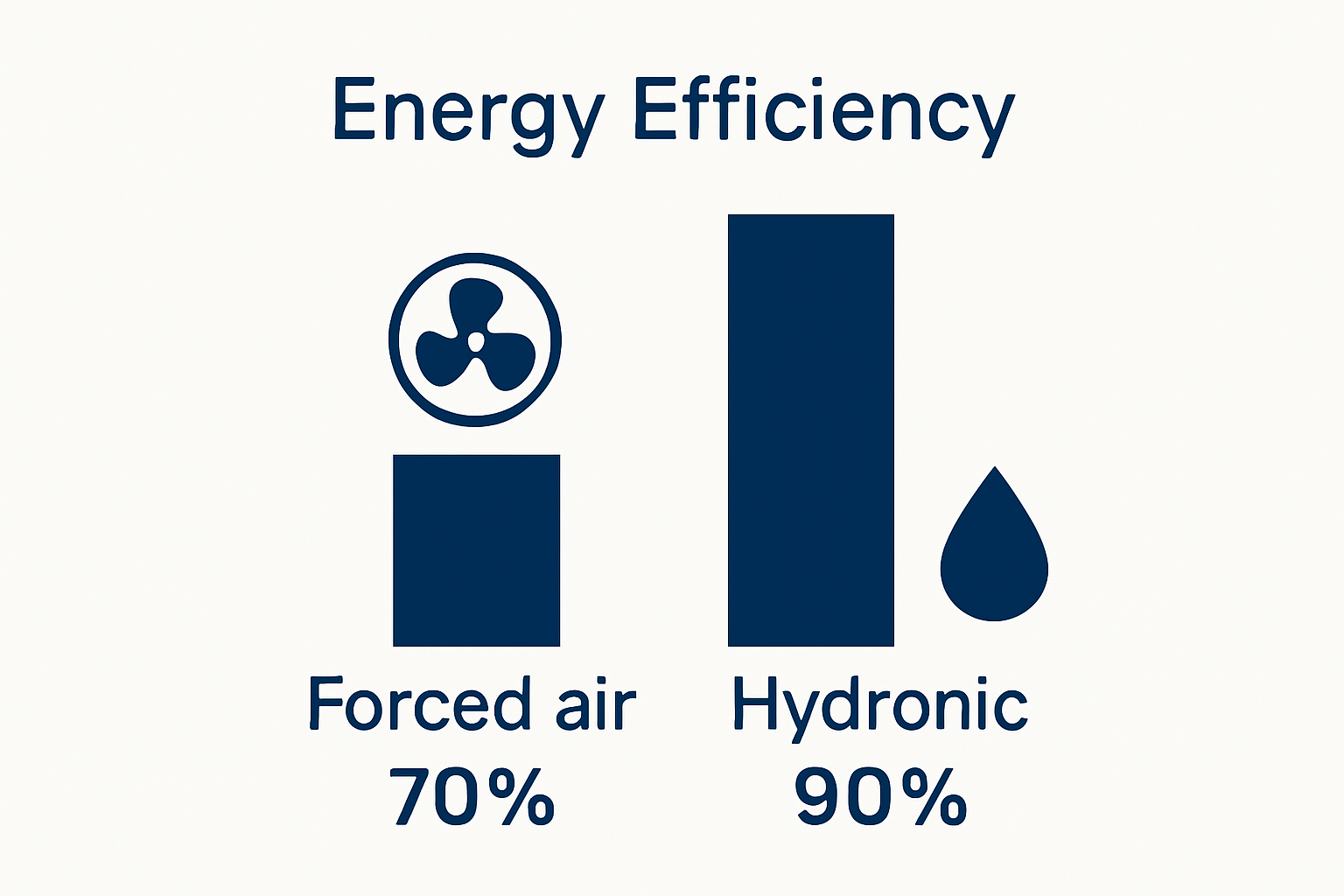 The even heat distribution eliminates cold spots and reduces energy waste associated with heat stratification common in other heating approaches.
The even heat distribution eliminates cold spots and reduces energy waste associated with heat stratification common in other heating approaches.
The versatility of hydronic heating systems also allows for multiple heat delivery methods, including radiant floor heating, baseboard radiators, and wall-mounted radiator panels. This flexibility enables homeowners to customise their heating solution based on specific architectural requirements and personal preferences.
The Importance of Hydronic Heating Systems in Modern Homes
Hydronic heating systems have emerged as a critical technological solution for contemporary residential environments, offering substantial advantages that extend far beyond traditional heating approaches. These advanced systems represent more than just a method of warmth distribution they embody a sophisticated approach to energy management and personal comfort.
Energy Efficiency and Cost Savings
The primary significance of hydronic heating systems lies in their remarkable energy efficiency. By utilising water as a heat transfer medium, these systems can achieve substantially lower energy consumption compared to conventional forced air heating. Research from the UK government indicates that advanced heating networks can generate bill savings of at least 30% when replacing traditional electric heating systems.
Key economic benefits include:
- Reduced monthly energy expenditure
- Lower carbon footprint
- Extended equipment lifespan
- Minimal heat loss during distribution
Comfort and Health Considerations
Beyond economic advantages, hydronic heating systems significantly enhance indoor environmental quality. The even heat distribution eliminates cold spots and reduces air movement, which can be particularly beneficial for individuals with respiratory sensitivities. Unlike forced air systems that can circulate dust and allergens, hydronic systems provide a cleaner heating experience.
The gentle, radiant heat produced by these systems creates a more natural warmth that mimics solar radiation, providing a more comfortable living environment. This method of heating feels more consistent and pleasant, maintaining stable temperatures without the sudden blasts of hot air characteristic of traditional heating methods.
For homeowners seeking comprehensive heating solutions, hydronic systems represent an intelligent investment in both comfort and efficiency. Their adaptability to various architectural designs and potential for integration with renewable energy sources makes them a forward thinking choice for modern residential heating.
Key Components of Hydronic Heating Systems Explained
Hydronic heating systems represent a complex network of interconnected components working harmoniously to deliver efficient thermal comfort. Understanding these critical elements provides insight into the sophisticated engineering behind modern heating technology.
The Central Heat Generation Unit
At the heart of every hydronic heating system lies the heat generation unit, typically a boiler or water heater. This crucial component is responsible for heating water to the desired temperature before distributing it throughout the heating network. Modern boilers come in various configurations, including condensing gas boilers, electric boilers, and renewable energy integrated systems that can significantly improve overall energy efficiency.
Key characteristics of central heat generation units include:
- Ability to reach precise temperature ranges
- High thermal efficiency
- Compatibility with multiple energy sources
- Advanced temperature control mechanisms
Circulation and Distribution Infrastructure
The circulation system represents the critical network that enables heat transfer throughout a property. This infrastructure comprises several essential elements:
- Circulating pumps: These powerful devices ensure water moves consistently through the piping network
- Insulated piping: Specialized pipes designed to minimise heat loss during water transportation
- Manifold systems: Complex junction points that direct heated water to specific zones or radiators
According to Warwick District Council, proper design and installation of these distribution systems are critical for maintaining overall heating performance and energy efficiency.
Control and Regulation Mechanisms
The sophistication of hydronic heating systems lies in their advanced control technologies. Smart thermostats and zone control systems enable precise temperature management, allowing homeowners to create customised heating environments. These intelligent systems can learn usage patterns, adjust temperatures automatically, and provide remote control capabilities through smartphone applications.
Modern control mechanisms offer significant advantages such as:
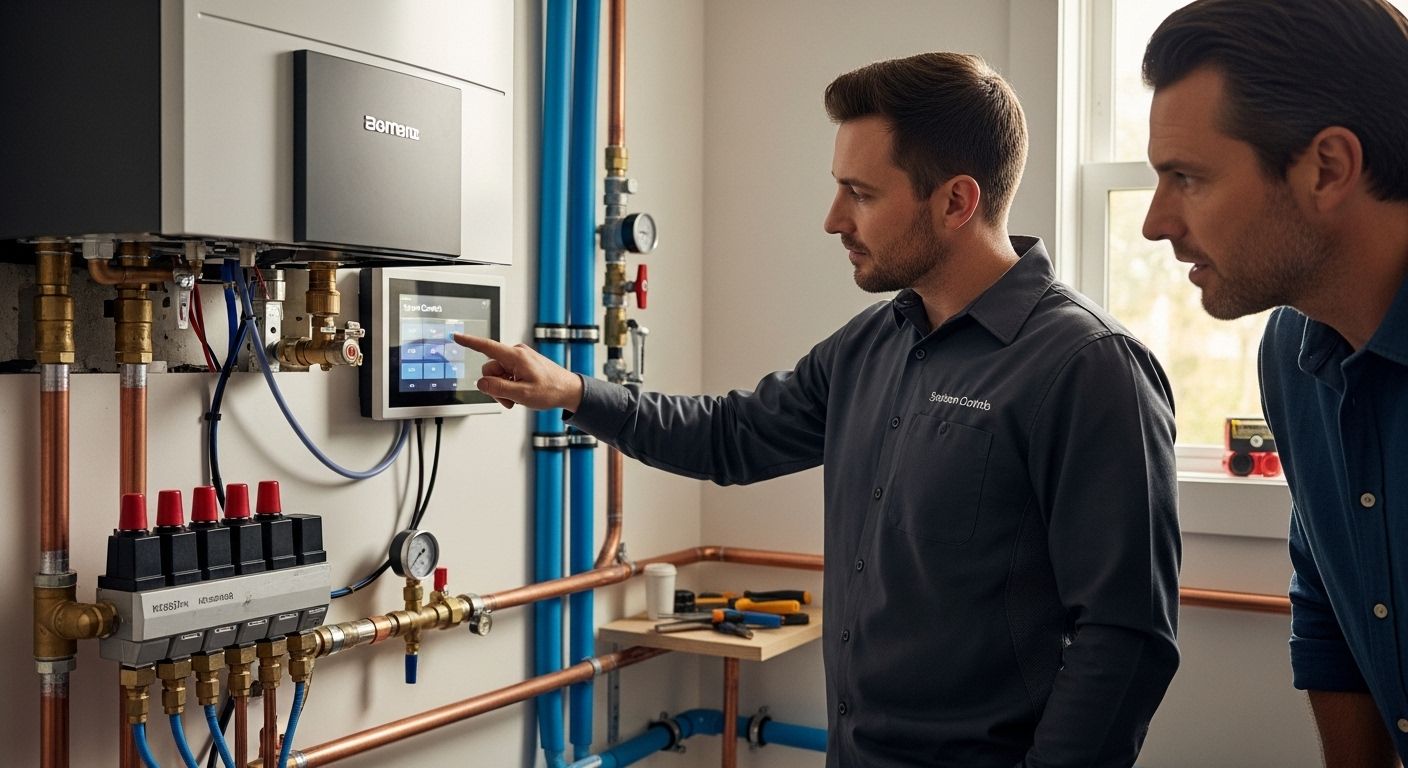
- Granular temperature management
- Energy consumption tracking
- Remote access and monitoring
- Adaptive learning capabilities
Learn more about our advanced heating solutions that integrate these cutting-edge technologies for optimal home comfort.
Benefits and Considerations of Using Hydronic Heating
Hydronic heating systems offer a sophisticated approach to residential thermal management, presenting homeowners with a range of advantages that extend beyond traditional heating methods. Understanding these benefits alongside potential implementation considerations is crucial for making informed decisions about home heating technologies.
Economic and Energy Efficiency Advantages
One of the most compelling aspects of hydronic heating systems is their exceptional energy efficiency. By utilizing water as a heat transfer medium, these systems can significantly reduce energy consumption and associated costs. Precise temperature control and minimal heat loss during distribution contribute to their economic appeal.
Key economic benefits include:
- Reduced monthly energy expenditure
- Lower long-term maintenance costs
- Potential increase in property value
- Compatibility with renewable energy sources
Comfort and Environmental Performance
Beyond financial considerations, hydronic heating systems provide superior comfort compared to conventional heating methods. The radiant heat distribution creates a more uniform temperature environment, eliminating cold spots and reducing air movement. This approach is particularly beneficial for individuals with respiratory sensitivities or allergies, as it minimizes dust circulation.
Environmental advantages are equally significant. UK Government research indicates that transitioning to low-carbon heating technologies can substantially reduce household carbon emissions. Hydronic systems, especially when integrated with heat pumps or renewable energy sources, represent a forward-thinking solution for sustainable home heating.
Installation and Maintenance Considerations
While hydronic heating systems offer numerous advantages, potential adopters must consider several implementation factors. Initial installation costs can be higher compared to traditional heating systems, and the complexity of retrofitting existing properties requires careful planning. Professional assessment of a property’s specific architectural characteristics is essential to determine optimal system design.
Important considerations include:
- Initial investment requirements
- Compatibility with existing infrastructure
- Professional installation expertise
- Long-term performance expectations
Explore our comprehensive heating solutions to understand how hydronic heating can transform your home’s thermal comfort and energy efficiency.
The Future of Hydronic Heating Systems in Energy Efficiency
The landscape of residential heating is undergoing a transformative evolution, with hydronic heating systems positioned at the forefront of sustainable and energy-efficient technologies. As global environmental concerns intensify, these systems are emerging as a critical solution for reducing carbon emissions while maintaining optimal thermal comfort.
Integration with Renewable Energy Technologies
Hydronic heating systems are increasingly being designed to seamlessly integrate with renewable energy sources, creating a sophisticated approach to home heating. Heat pumps, solar thermal collectors, and biomass boilers can now be effectively coupled with hydronic infrastructure, enabling homeowners to significantly reduce their carbon footprint.
Key technological advancements include:
- Advanced heat pump compatibility
- Solar thermal energy integration
- Smart grid interaction capabilities
- Modular system design for flexible upgrades
Smart Control and Predictive Management
The future of hydronic heating lies in intelligent control mechanisms that leverage artificial intelligence and machine learning. Predictive temperature management allows systems to anticipate heating requirements based on historical usage patterns, occupancy data, and external weather conditions. These smart systems can dynamically adjust water temperatures and circulation, optimizing energy consumption with unprecedented precision.
According to UK Government research, emerging technologies are set to revolutionize home heating efficiency, with hydronic systems playing a pivotal role in achieving national decarbonization targets.
Sustainable Design and Material Innovation
Material science is driving significant improvements in hydronic heating system components. Next-generation pipes with enhanced thermal conductivity, ultra-efficient heat exchangers, and corrosion-resistant materials are expanding the potential of these systems. Manufacturers are developing components that not only improve performance but also extend system longevity and reduce maintenance requirements.
Critical areas of innovation include:
- Nano-engineered pipe materials
- Advanced thermal insulation technologies
- Corrosion-resistant system components
- Modular, easily replaceable parts
Stay updated on our latest heating innovations and discover how we are shaping the future of sustainable home heating.
Upgrade to Advanced Hydronic Comfort with Trusted Local Experts
Are you tired of inefficient heating, cold spots, or rising energy bills? The article you just read explains how hydronic heating systems offer superior warmth, efficiency, and healthier air quality compared to traditional forced air heating. Many homeowners in Edinburgh and Midlothian find themselves stuck with outdated systems that cost more and deliver less comfort. Discover how you can experience consistent, energy-efficient warmth with the latest in hydronic and renewable solutions, professionally designed for your unique property.

Take the next step towards a warmer, cleaner, and more energy-saving home today. Speak with our Gas Safe Registered engineers, who can advise on modern boiler upgrades, smart thermostat controls, or integrating renewables like solar thermal or heat pumps. Visit thermatekheating.co.uk now to request a free home assessment and see why so many local residents rely on Thermatek for proven heating and plumbing expertise. Don’t wait for another harsh season to regret not upgrading. Book your professional consultation and start saving today.
Frequently Asked Questions
What is a hydronic heating system?
A hydronic heating system is an efficient method of heating spaces using water as the primary heat transfer medium, circulating heated water through pipes and radiators instead of using forced air.
How does a hydronic heating system work?
Hydronic heating systems heat water using a boiler, which then circulates the water through a network of insulated pipes and radiators, transferring heat directly into living areas.
What are the advantages of hydronic heating systems?
Hydronic heating systems offer several advantages including improved energy efficiency, reduced monthly energy costs, uniform heat distribution, and a cleaner indoor environment with less air movement that can circulate dust and allergens.
Can hydronic heating systems be integrated with renewable energy sources?
Yes, hydronic heating systems can be designed to integrate with renewable energy technologies, such as heat pumps and solar thermal collectors, enhancing their energy efficiency and reducing carbon emissions.
Recommended
Understanding the Best Temperature for Heating Your Home
Finding the right temperature for heating your home can feel like guesswork. Many people assume that a few degrees up or down does not make much difference. Yet heating accounts for nearly 45 percent of all household energy use, and just a small tweak on the thermostat can cut costs by up to 15 percent every year. This means choosing the best indoor temperature is about far more than comfort. It is the key to healthier living and surprising savings.
Table of Contents
- What Is The Best Temperature For Heating?
- Why The Best Temperature Matters For Your Home
- How Heating Efficiency Affects Comfort And Costs
- Key Concepts In Heating: Balancing Temperature And Energy Use
- Real-World Context: Heating Standards And Recommendations
Quick Summary
| Takeaway | Explanation |
|---|---|
| Maintain a temperature of 18°C to 22°C | This range supports comfort, health, and energy efficiency according to WHO guidelines. |
| Set thermostat to 20°C when home | The U.S. Department of Energy suggests this temperature for active hours to enhance comfort while reducing costs. |
| Lower the temperature when sleeping or away | Reducing the thermostat by several degrees can save up to 10% on heating expenses annually. |
| Consider vulnerable populations’ needs | Young children, elderly, and those with chronic conditions require stable temperatures for their health and well-being. |
| Invest in high-efficiency heating technologies | Upgrading systems and using smart thermostats can lead to significant long-term savings on energy costs. |
What is the Best Temperature for Heating?
The best temperature for heating is a critical consideration for homeowners seeking optimal comfort and energy efficiency. Understanding the ideal indoor temperature involves balancing personal comfort, health considerations, and energy consumption.
Understanding Thermal Comfort
Thermal comfort is not just about hitting a specific number on the thermostat. It represents a complex interaction between human physiology, environmental conditions, and personal preferences. Research from the World Health Organization suggests that the ideal indoor temperature ranges between 18°C to 22°C (64°F to 72°F) during waking hours.
Key factors influencing thermal comfort include:
The following table compares key factors that influence thermal comfort and their specific effects in the context of indoor heating, helping to clarify how each element contributes to overall comfort and health.
| Factor | Description | Effect on Thermal Comfort |
|---|---|---|
| Individual Metabolism | Rate at which a person’s body produces heat | Determines how warm or cold one feels |
| Clothing | Amount and type of insulation clothing provides | Can increase or decrease warmth |
| Humidity Levels | Amount of moisture present in the air | Affects perception of temperature |
| Physical Activity | Level of movement or exercise indoors | Generates internal body heat |
| Age and Health Status | Physical condition, age, and existing health issues | Affects sensitivity to temperature |
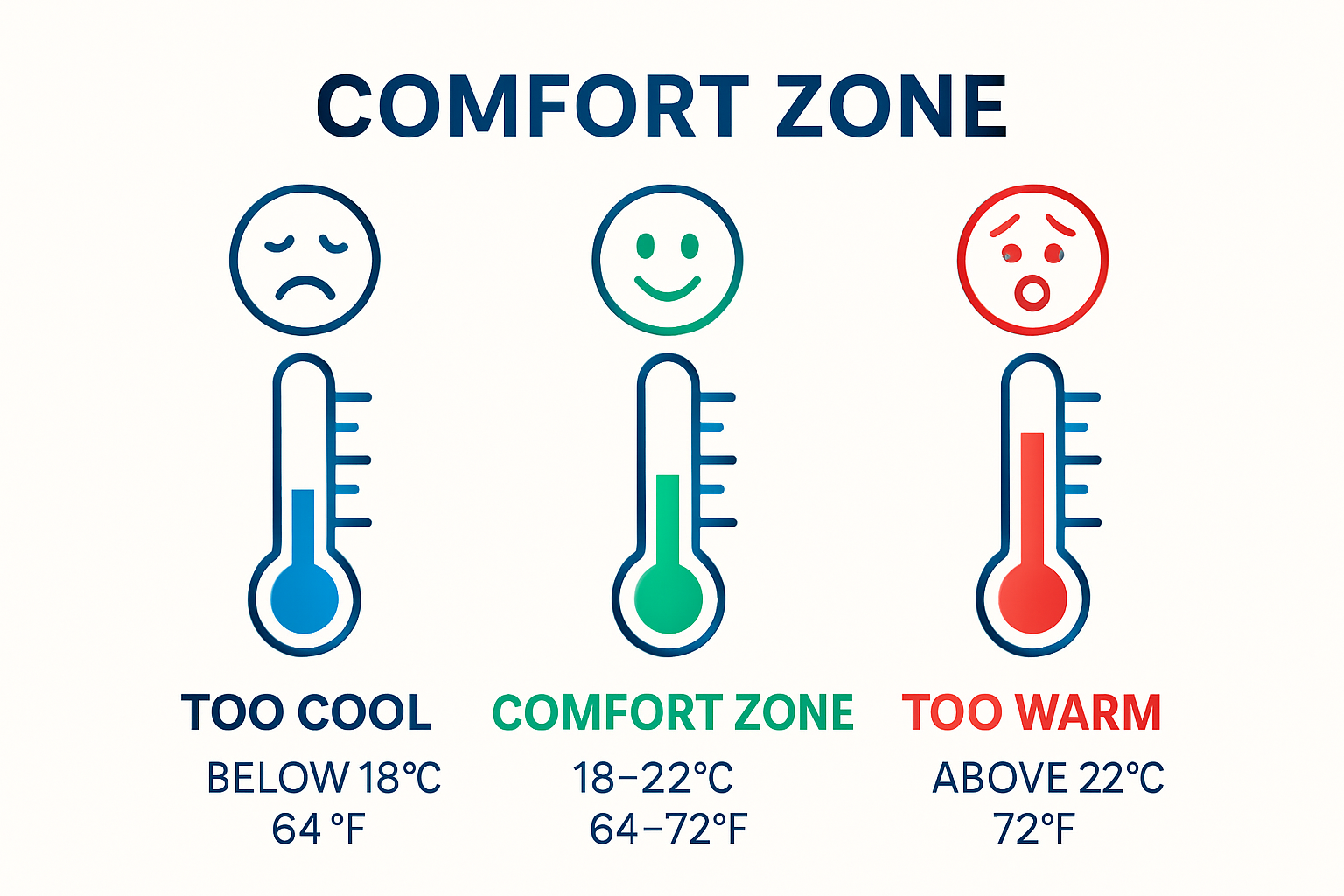
- Individual metabolism and body temperature
- Clothing worn indoors
- Humidity levels
- Physical activity
- Age and health status
Energy Efficiency and Temperature Management
Managing your home’s heating temperature is not just about comfort but also about reducing energy consumption and associated costs. The U.S. Department of Energy recommends setting your thermostat to around 20°C (68°F) when you are at home and active, and lowering it by several degrees when sleeping or away.
By implementing strategic temperature management, homeowners can potentially reduce heating expenses by up to 10% annually. This approach not only saves money but also contributes to reducing overall carbon emissions and supporting environmental sustainability.
Health and Heating Considerations
Maintaining an appropriate indoor temperature is crucial for health and well-being. Extremely cold indoor environments can increase risks of respiratory issues, cardiovascular strain, and decreased immune function. Conversely, overheating can lead to dehydration and discomfort.
Particularly for vulnerable populations such as elderly individuals, young children, and those with chronic health conditions, maintaining a consistent and moderate indoor temperature is essential for preventing health complications.
Why the Best Temperature Matters for Your Home
Choosing the right indoor temperature is far more complex than simply selecting a number on a thermostat. It represents a nuanced balance between personal comfort, health considerations, energy efficiency, and broader environmental responsibilities.
Economic and Environmental Impact
The temperature you select directly influences your household expenses and carbon footprint. According to research from the Energy Saving Trust, maintaining an optimal temperature can reduce energy consumption by up to 15% annually. This translates into significant financial savings and a meaningful reduction in carbon emissions.
Key economic benefits of strategic temperature management include:
- Reduced monthly utility bills
- Lower long-term heating system maintenance costs
- Minimised energy waste
- Potential eligibility for energy efficiency incentives
Health and Physiological Considerations
Indoor temperature plays a crucial role in human health and well-being. Inappropriate heating can lead to various physiological challenges. Consistently low temperatures may increase risks of respiratory infections, cardiovascular stress, and compromised immune function. Conversely, excessively high temperatures can cause dehydration, disrupt sleep patterns, and create uncomfortable living conditions.
Specific vulnerable groups such as elderly individuals, young children, and those with chronic health conditions are particularly sensitive to temperature fluctuations. Maintaining a stable, moderate indoor environment becomes essential for their overall health and comfort.

Psychological and Comfort Dimensions
Beyond tangible economic and health considerations, indoor temperature significantly influences psychological well-being and overall quality of life. A comfortable living environment promotes relaxation, productivity, and positive mental states. Research suggests that temperature plays a critical role in stress reduction and emotional regulation.
By understanding and implementing thoughtful temperature management, homeowners can create living spaces that support physical health, emotional balance, and sustainable living practices.
This table summarises the economic, health, and psychological aspects associated with indoor temperature management, highlighting why careful thermostat settings matter for different areas of home life.
| Aspect | Key Considerations | Implications |
|---|---|---|
| Economic | Energy costs, system maintenance, energy waste | Reduced bills, less energy waste |
| Health | Respiratory risk, cardiovascular health, immune function | Well-being, prevention of illnesses |
| Psychological/Comfort | Mental state, sleep, emotional regulation | Enhanced relaxation, productivity |
| Vulnerable Groups | Elderly, young children, chronic conditions | Increased need for temperature stability |
| Environmental | Carbon footprint, sustainability | Lower emissions, eco-friendliness |
How Heating Efficiency Affects Comfort and Costs
Heating efficiency represents a complex interplay between technological performance, energy consumption, and financial investment. Understanding how your heating system operates can unlock significant opportunities for improved comfort and reduced expenses.
Technological Performance and Energy Consumption
Research from ENERGY STAR indicates that heating systems account for nearly 45% of household energy consumption. The efficiency of these systems directly correlates with both financial expenditure and environmental impact.
Key factors influencing heating efficiency include:
- Insulation quality
- Equipment age and maintenance
- Thermostat programming
- Home architectural design
- Local climate conditions
Financial Implications of Heating Efficiency
The economic consequences of heating efficiency extend far beyond monthly utility bills. An inefficient heating system can result in substantial long-term expenses. Homeowners might experience increased repair costs, higher energy consumption, and reduced property value when heating systems operate below optimal performance levels.
Strategic investments in modern, high-efficiency heating technologies can yield significant financial returns. Upgrading to smart thermostats, improving home insulation, and regularly maintaining heating equipment can potentially reduce energy expenses by 10-15% annually.
Comfort and Performance Interconnections
Heating efficiency is not solely about cost reduction but also about creating a comfortable living environment. An efficiently operating heating system provides consistent temperature regulation, improved air quality, and enhanced overall home comfort. Advanced heating technologies enable precise temperature control, allowing residents to create personalised living spaces that adapt to individual preferences and daily routines.
By understanding the intricate relationship between heating efficiency, comfort, and costs, homeowners can make informed decisions that improve their living conditions while simultaneously reducing financial and environmental burdens.
Key Concepts in Heating: Balancing Temperature and Energy Use
Heating a home involves more than simply turning up a thermostat. It requires a sophisticated understanding of thermal dynamics, energy consumption patterns, and strategic temperature management to achieve optimal comfort and efficiency.
Thermal Regulation Fundamentals
Research from the National Renewable Energy Laboratory demonstrates that effective heating goes beyond maintaining a consistent temperature. It involves understanding how heat transfers, disperses, and interacts with various architectural and environmental elements.
Key thermal regulation principles include:
- Heat retention through proper insulation
- Understanding heat loss mechanisms
- Recognising individual metabolic differences
- Accounting for humidity and air circulation
- Considering building structure and materials
Energy Consumption Strategies
Strategic energy consumption requires a nuanced approach to temperature management. Homeowners can significantly reduce energy expenditure by implementing intelligent heating strategies that adapt to changing environmental conditions and personal requirements.
Effective energy consumption techniques involve:
- Programmed temperature adjustments
- Zonal heating approaches
- Utilising smart thermostat technologies
- Implementing passive heating techniques
- Regular maintenance of heating systems
Personal Comfort and Systemic Efficiency
Personal comfort is not a universal standard but a complex interaction between individual physiology, environmental conditions, and technological capabilities. Modern heating systems now offer unprecedented levels of personalisation, allowing residents to create tailored thermal environments that balance individual preferences with energy efficiency.
By understanding these intricate relationships between personal comfort, technological capabilities, and energy consumption, homeowners can create living spaces that are simultaneously comfortable, economical, and environmentally responsible.
Real-World Context: Heating Standards and Recommendations
Heating standards represent a critical intersection between scientific research, energy policy, public health, and individual comfort. These recommendations provide homeowners with evidence-based guidelines for maintaining optimal indoor environments.
Global and Regulatory Perspectives
Research from the World Health Organization establishes comprehensive guidelines for indoor temperatures that protect human health and well-being. These standards consider multiple factors beyond simple numerical temperature settings, including physiological needs, environmental conditions, and potential health risks.
Key international heating recommendations include:
- Maintaining minimum indoor temperatures of 18°C (64.4°F)
- Ensuring consistent temperature regulation
- Accounting for vulnerable population needs
- Balancing energy efficiency with health considerations
- Adapting recommendations to local climate conditions
Health and Safety Implications
Heating standards are not arbitrary numbers but carefully calculated recommendations designed to protect human health. Prolonged exposure to cold indoor environments can lead to significant physiological stress, potentially increasing risks of respiratory infections, cardiovascular complications, and compromised immune responses.
Vulnerable populations such as elderly individuals, young children, and those with pre-existing health conditions are particularly susceptible to temperature-related health challenges. Professional guidance on safe heating practices becomes crucial in mitigating these potential risks.
Technological and Economic Considerations
Modern heating recommendations increasingly integrate technological innovations and economic considerations. Smart home technologies, advanced thermostatic controls, and energy-efficient heating systems enable more precise temperature management, allowing homeowners to achieve optimal comfort while minimising energy consumption.
By understanding and implementing these comprehensive heating standards, individuals can create living environments that prioritise health, comfort, economic efficiency, and environmental sustainability.
Take Control of Your Comfort and Cut Heating Costs Today
If you are worried about finding the ideal balance between warmth, health and rising energy bills, you are not alone. As you read in our article, getting the best temperature for heating your home relies on more than guesswork. Inconsistent heating, outdated boilers and inefficient systems can leave your home uncomfortable and drive up your costs. Many households struggle with old equipment or uncertain thermostat settings, risking both their comfort and wellbeing.

You do not have to settle for uncertainty. At Thermatek Heating, our Gas Safe Registered experts offer everything from smart thermostat installation to new energy-efficient boilers and even renewable heating solutions. We help Edinburgh and Midlothian homeowners create healthy, consistent warmth while lowering their bills. Visit our boiler installation and repair or renewable energy solutions pages, or request your free quote direct from our homepage. Act now and take charge of your comfort with professional advice and reliable service.
Frequently Asked Questions
What is the ideal indoor temperature for heating a home?
The ideal indoor temperature for heating a home ranges between 18°C to 22°C (64°F to 72°F) during waking hours, according to the World Health Organization.
How can I save on heating costs while maintaining comfort?
To save on heating costs, the U.S. Department of Energy recommends setting your thermostat to around 20°C (68°F) when you’re at home and lowering it by several degrees when you are asleep or away.
Why is maintaining the right temperature important for health?
Maintaining the right indoor temperature is crucial for health as extreme cold can increase the risk of respiratory issues and cardiovascular strain, while high temperatures can lead to dehydration and discomfort, particularly for vulnerable individuals.
How does heating efficiency impact energy consumption?
Heating efficiency directly affects energy consumption, as inefficient heating systems can lead to higher energy bills and increased environmental impact. Improving insulation and using modern heating technologies can help reduce energy expenses significantly.
Recommended
- News
- Local Heating Installer Kicks Off His New Business With £500 Birthday Present
- Smart Thermostat Installation In Edinburgh
Obtain Your Gas Safety Certificate: A Step-by-Step Guide
Getting a gas safety certificate might sound like a chore, but there is much more at stake than just ticking a legal box. Over 1500 gas safety inspections in the UK each year uncover dangerous faults that could put lives in jeopardy. You might expect the hardest part is passing the inspection itself. Yet, the real secret is that smooth approval almost always comes down to how well you prepare before anyone arrives with a clipboard.
Table of Contents
- Step 1: Identify Your Gas Appliances And Systems
- Step 2: Gather Necessary Documentation And Access
- Step 3: Hire A Qualified Gas Safe Engineer
- Step 4: Schedule And Conduct The Safety Inspection
- Step 5: Review And Store Your Gas Safety Certificate
Quick Summary
| Key Point | Explanation |
|---|---|
| 1. Identify all gas appliances | Conduct a thorough inspection to list all gas systems and appliances with details like location, model, and condition. |
| 2. Gather essential documentation | Organise maintenance records, installation certificates, and previous inspection reports for efficient inspection preparation. |
| 3. Hire a qualified gas engineer | Choose a registered Gas Safe engineer with relevant experience and verify their credentials for a safe inspection. |
| 4. Schedule the safety inspection | Coordinate with your engineer and ensure all gas appliances are accessible for a thorough evaluation of safety risks. |
| 5. Review and securely store your certificate | After receiving the gas safety certificate, check for accuracy and store it safely, while also tracking future inspection dates. |
Step 1: Identify Your Gas Appliances and Systems
Obtaining a gas safety certificate starts with a comprehensive understanding of your property’s gas infrastructure. This critical first step involves systematically mapping out and evaluating all gas-powered systems and appliances within your home or commercial space.
Begin by conducting a thorough walkthrough of your entire property, paying close attention to every room and area where gas appliances might be installed. Look for heating systems, water heaters, gas cookers, fireplaces, and any portable gas equipment. Some homeowners overlook less obvious gas connections, such as those in utility rooms, garages, or external spaces.
While examining your appliances, make detailed notes about each device’s location, model number, age, and current condition. Professional gas engineers recommend creating a comprehensive inventory that includes manufacturer details, installation dates, and any previous maintenance records. This documentation will prove invaluable during your safety inspection and help understand your property’s heating systems.
Carefully inspect each appliance for visible signs of wear, corrosion, or damage. Check gas connections for any signs of potential leaks, such as unusual odours, hissing sounds, or discolouration around connection points. Warning signs like rust, physical damage, or irregular flame colours indicate potential safety risks that require immediate professional assessment.
Critical items to document during your inspection include:
- Manufacturer and model details of each gas appliance
- Location of gas meter and main shut-off valve
- Age and installation date of major gas systems
- Current condition and observable maintenance history
If you are uncertain about any aspect of your gas systems or lack technical expertise, scheduling a professional assessment is strongly recommended.
This troubleshooting table summarises common visible warning signs you may encounter and the recommended actions to take during your property walkthrough.
| Warning Sign | Possible Cause | Recommended Action |
|---|---|---|
| Unusual odours (e.g., gas smell) | Potential gas leak | Contact Gas Safe engineer immediately |
| Hissing sounds near connections | Loose or damaged joints | Arrange prompt professional inspection |
| Rust or discolouration around points | Corrosion or water ingress | Schedule maintenance assessment soon |
| Irregular flame colour | Faulty combustion | Have the appliance professionally serviced |
| Physical damage to appliances | Wear or accidental impact | Request a qualified engineer review |
Successful completion of this step means you have a clear, documented understanding of all gas appliances and systems within your property, setting a strong foundation for the subsequent stages of obtaining your gas safety certificate.
Step 2: Gather Necessary Documentation and Access
After identifying your gas appliances, the next crucial stage in obtaining your gas safety certificate involves systematically collecting and preparing all required documentation. This step ensures you have everything a certified gas safety inspector will need to complete a thorough and efficient examination.
Start by locating and organizing all historical maintenance records for your gas systems. Original installation certificates, service history, and previous inspection reports are essential. These documents provide inspectors with a comprehensive background on your gas appliances, helping them understand the equipment’s maintenance trajectory and potential risk factors.
Contact your current gas appliance manufacturers and request copies of original installation manuals and technical specifications if you cannot locate them. Many manufacturers provide digital versions online, which can be easily downloaded and printed. explore comprehensive heating system documentation to ensure you have all necessary paperwork.
Secure property access is equally important during this preparation phase. Coordinate with all relevant parties who might need to be present during the inspection. For rental properties, this means communicating with tenants well in advance and scheduling a mutually convenient time. Homeowners should ensure that all areas housing gas appliances are clear, accessible, and free from obstructions.
Documents you will need to compile include:
- Original installation certificates
- Service history records
- Manufacturer specifications and manuals
- Previous gas safety inspection reports
- Property ownership or tenancy documentation
Prepare a dedicated folder or digital file containing these documents, organized chronologically for easy reference. Consider creating both physical and digital backups to prevent potential loss. Digital copies can be saved on cloud storage platforms, ensuring you always have access to important records.
Verify that all documentation is current and legible. Blurred, damaged, or outdated documents might complicate or delay your gas safety certificate process.
Below is a checklist table to help you prepare the essential documentation before your gas safety inspection.
| Document Type | Purpose | Preparation Tip |
|---|---|---|
| Original installation certificates | Verifies correct initial installation | Request digital copies from manufacturer |
| Service history records | Shows maintenance and servicing history | Organise chronologically for easy access |
| Manufacturer manuals/specifications | Provides technical guidance | Download from manufacturer website if lost |
| Previous inspection reports | Displays past safety assessments | Ensure clarity and up-to-date information |
| Property ownership or tenancy documents | Confirms legal responsibility | Retain both digital and paper versions |
Successful completion of this step means you have a comprehensive, organized collection of documentation that demonstrates the maintenance history and current condition of your gas systems, setting the stage for a smooth and efficient safety inspection.
Step 3: Hire a Qualified Gas Safe Engineer
Selecting the right gas safety professional is a critical step in obtaining your gas safety certificate. This stage requires careful research and verification to ensure you work with a fully qualified and legally registered gas engineer who can provide a comprehensive and reliable inspection.
Begin by confirming that any potential engineer is registered with the Gas Safe Register, which is the official gas registration body in the United Kingdom. Valid registration is non-negotiable - it legally demonstrates that the professional has the necessary training, skills, and authorization to work safely with gas appliances. Ask to see their Gas Safe ID card, which includes a unique license number you can independently verify online.
comprehensive landlord safety services can help streamline this selection process. When contacting potential engineers, prepare a detailed list of questions that will help you assess their expertise and suitability for your specific gas safety requirements.
Research potential engineers through multiple channels. Check online reviews, request recommendations from trusted sources, and verify their professional credentials. Look for engineers with extensive experience in your specific type of property and gas systems. Professional engineers should be willing to provide references and discuss their approach to gas safety inspections transparently.
Critical factors to consider when hiring a gas safety engineer include:
- Current Gas Safe Register certification
- Proven experience with similar property types
- Positive professional references
- Clear communication and transparency
- Reasonable and competitive pricing
- Availability to complete inspection within your required timeframe
During initial consultations, discuss the scope of your gas safety inspection in detail. A reputable engineer will ask comprehensive questions about your property, existing gas systems, and any specific concerns you might have.
They should explain their inspection process, estimated duration, and provide a clear breakdown of potential costs.
Always request a written quote that outlines the full range of services included in the gas safety inspection. This document protects both you and the engineer by establishing clear expectations and preventing potential misunderstandings. Verify that the quote covers a complete examination of all gas appliances, connections, and associated safety checks.
Successful completion of this step means you have identified a fully qualified, professionally registered gas safety engineer who understands your specific requirements and can provide a thorough, reliable gas safety certificate inspection.
Step 4: Schedule and Conduct the Safety Inspection
Scheduling and conducting the gas safety inspection represents a pivotal moment in obtaining your gas safety certificate. This step transforms all your previous preparation into a comprehensive assessment of your property’s gas systems and potential safety risks.
Initiate the process by confirming a mutually convenient time with your selected Gas Safe registered engineer. Professional inspections typically require approximately one to two hours, depending on the complexity of your property’s gas infrastructure. Ensure you or an authorized representative will be present throughout the entire inspection to provide access and answer any potential questions.
comprehensive property safety evaluations can help streamline the inspection process. Prepare your property by ensuring all gas appliances are accessible, with clear pathways and no obstructing furniture or equipment. The engineer will need unimpeded access to examine each gas system thoroughly.
During the inspection, the engineer will conduct a meticulous examination of all gas appliances and associated systems. They will check for proper installation, ventilation, gas pressure, and potential safety hazards. Critical areas of focus include checking for gas leaks, examining flue systems, verifying proper combustion, and assessing overall appliance functionality.
Key elements the engineer will evaluate include:
- Proper gas appliance installation and positioning
- Ventilation and air circulation around gas systems
- Integrity of gas connections and potential leak points
- Combustion efficiency and flame characteristics
- Overall operational safety of each gas system
Be prepared to provide the documentation you compiled in previous steps, including maintenance records and previous inspection reports. The engineer may request additional information about the property’s gas system history or specific appliance modifications.
Remain engaged during the inspection process. Ask questions, seek clarification about any identified issues, and request a verbal summary of findings. Most professional engineers will provide an immediate overview of their observations, highlighting any potential concerns or recommended actions.
At the conclusion of the inspection, the engineer will issue a detailed report. This document is crucial, as it forms the basis of your gas safety certificate. Carefully review the report, paying close attention to any recommendations or required remedial actions. If any issues are identified, discuss immediate next steps with the engineer and understand the timeline for addressing potential safety concerns.
Successful completion of this step means you have undergone a comprehensive, professional inspection that thoroughly evaluates the safety and functionality of your property’s gas systems, bringing you closer to obtaining your official gas safety certificate.
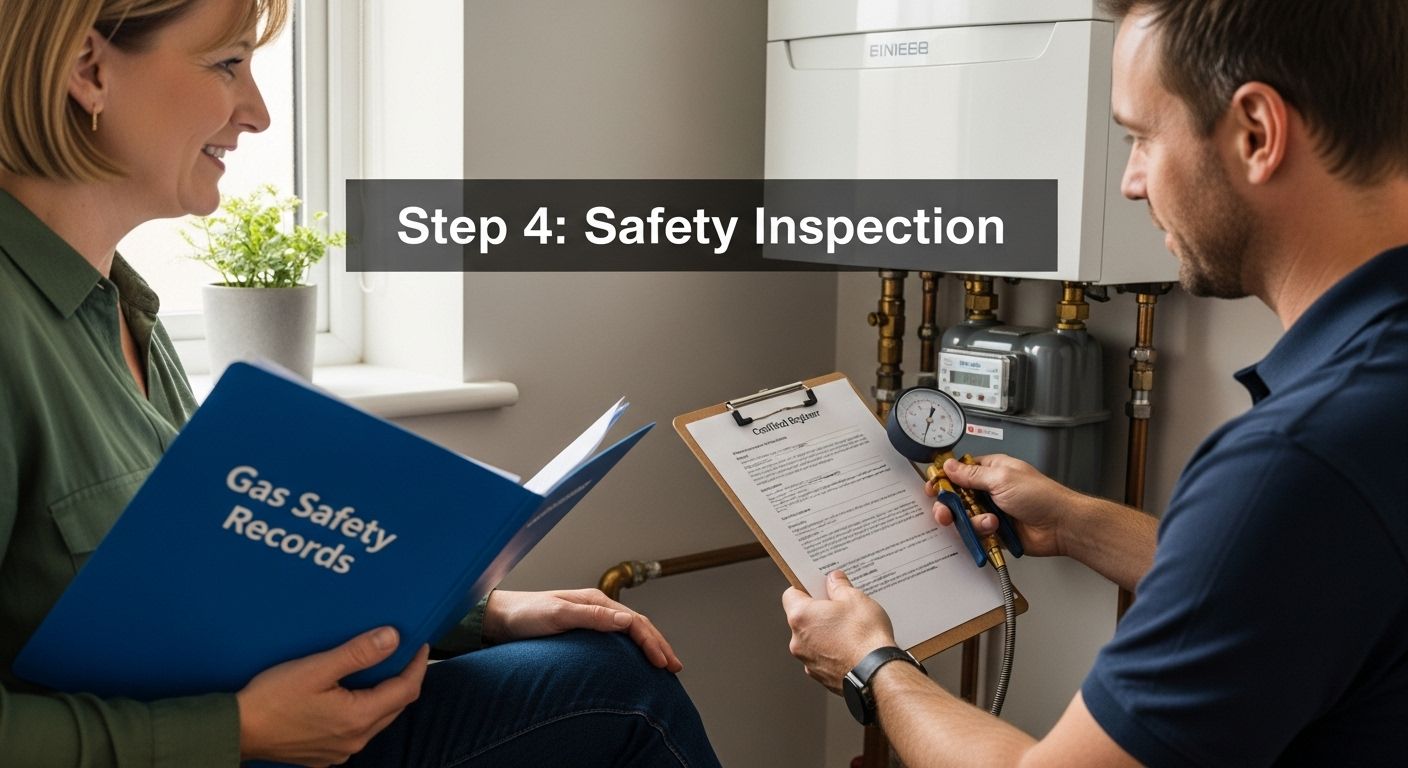
Step 5: Review and Store Your Gas Safety Certificate
After successfully completing the gas safety inspection, the final critical step involves carefully reviewing and securely storing your gas safety certificate. This document represents an official record of your property’s gas system safety and compliance, making proper handling essential for both legal and practical purposes.
Upon receiving your certificate, conduct a thorough initial review to ensure all details are accurate and complete. Check that your personal information, property address, and inspection date are correctly recorded. Verify that each gas appliance has been properly documented and that any identified issues or recommendations are clearly noted. If you discover any discrepancies, contact the engineer immediately to request corrections.
comprehensive property documentation strategies can help you maintain organized records. Create a dedicated storage system for your gas safety certificate that protects the document from potential damage while ensuring easy accessibility.
Consider creating both physical and digital backup copies of your certificate. For physical storage, use a protective plastic sleeve or folder kept in a cool, dry location away from direct sunlight and potential moisture. Digital copies should be saved in multiple secure locations, such as a personal cloud storage account and a backup external hard drive.
Key elements to verify on your gas safety certificate include:
- Correct property address and owner/tenant details
- Comprehensive list of inspected gas appliances
- Date of inspection and certificate validity period
- Gas Safe Register engineer’s identification number
- Detailed notes on any identified safety concerns or recommendations
- Contact information for the issuing engineer or company
Maintain a consistent record-keeping schedule. Most gas safety certificates are valid for 12 months, so set a reminder in your calendar for the next required inspection. This proactive approach ensures you remain compliant and can track the ongoing safety of your gas systems.
For rental properties, additional documentation requirements may apply. Landlords typically must provide a copy of the gas safety certificate to tenants within 28 days of the inspection. Keep a separate copy for your personal records and be prepared to present the document if requested by tenants, property management, or regulatory authorities.
Successful completion of this step means you have a carefully reviewed, securely stored gas safety certificate that provides official documentation of your property’s gas system safety, protecting both your legal compliance and personal peace of mind.
Ensure Complete Gas Safety and Peace of Mind with Local Experts
Feeling anxious about compliance or how to prepare for your gas safety inspection? This step-by-step guide explained the importance of identifying every gas appliance, gathering accurate documentation, and working only with fully qualified engineers. When it comes to gas safety, a single overlooked detail can put both your property and loved ones at risk. Your goal is to achieve total peace of mind with proof of legal compliance and a secure home or rental property.

Secure your gas safety certificate with help from a trusted local team. At Thermatek Heating, all our engineers are Gas Safe Registered and trained to spot safety issues others might miss. Whether you are a homeowner, landlord or property manager, we provide thorough inspections, clear records, and actionable advice. If you want a smooth inspection, accurate documentation or urgent remedial work, get in touch for a free quote and discover why so many in Edinburgh and Midlothian choose us for their heating and compliance needs. Act now to keep your property safe and fully certified.
Frequently Asked Questions
What is a gas safety certificate?
A gas safety certificate is an official document that confirms that all gas appliances and systems in a property have been checked and adhere to safety regulations, ensuring they are safe to use.
How often do I need to obtain a gas safety certificate?
A gas safety certificate is typically valid for 12 months. It’s essential to schedule a new inspection before the expiration date to remain compliant with safety regulations.
What does a gas safety inspection involve?
A gas safety inspection involves a thorough examination of all gas appliances, connections, and systems in your property. This includes checking for gas leaks, proper installation, ventilation, and appliance functionality.
What should I do if my gas safety inspection identifies issues?
If your gas safety inspection identifies issues, it’s crucial to discuss the findings with your gas engineer and take immediate corrective actions. This ensures the safety of your gas systems and compliance with legal requirements.
Recommended
- Landlord Gas Safety Certificates In Edinburgh
- Annual Boiler Servicing In Edinburgh
- New Boiler Installation & Replacement In Edinburgh
- Gas Heating Engineer & Plumber In Edinburgh
Understanding Energy Efficient Heating Solutions: A Homeowner's Guide
Energy efficient heating is not a distant dream for the future. More homes and businesses are switching than ever, and some households have slashed heating costs by up to 50 percent just by upgrading their systems. Most expect high-tech gadgets or solar panels on every roof, but the real surprise is how these solutions use everyday science to quietly cut bills and emissions without fuss or disruption. The biggest breakthroughs come from fine-tuned control and clever use of existing resources, changing what we thought was possible with heating.
Table of Contents
- What Are Energy Efficient Heating Solutions?
- Why Energy Efficiency Matters For Homes And Businesses
- How Energy Efficient Heating Solutions Work
- Key Concepts Behind Energy Efficient Heating Technologies
- Real-World Applications And Benefits Of Energy Efficiency
Quick Summary
| Takeaway | Explanation |
|---|---|
| Energy efficient heating reduces energy consumption | These systems optimise warmth delivery using less electricity or fuel, leading to lower energy bills. |
| Variety of technologies offers choices | Options include heat pumps, solar thermal systems, and smart thermostats, catering to diverse heating needs. |
| Financial benefits enhance property value | Implementing energy-efficient solutions can lower utility costs and improve the overall market attractiveness of homes or businesses. |
| Environmental impact is significant | These systems help decrease greenhouse gas emissions, contributing to climate change mitigation efforts. |
| Intelligent systems enable better temperature control | Smart thermostats and zonal heating improve comfort while optimising energy use, benefiting both users and the environment. |
What are Energy Efficient Heating Solutions?
Energy efficient heating solutions represent advanced technological approaches designed to minimise energy consumption while maintaining optimal home comfort and reducing environmental impact. These systems focus on delivering warmth using minimal electricity or fuel, thereby significantly lowering both carbon emissions and household energy expenditure.
Understanding the Core Principles
At their fundamental level, energy efficient heating solutions work by maximising heat generation while minimising energy input. Unlike traditional heating methods that waste substantial energy through inefficient conversion processes, these modern systems leverage sophisticated technologies to capture, transfer, and distribute heat more effectively.
Key characteristics of energy efficient heating solutions include:
- Significantly reduced energy consumption compared to conventional heating systems
- Lower greenhouse gas emissions
- Enhanced temperature control and zonal heating capabilities
- Potential for substantial long term cost savings
Types of Energy Efficient Heating Technologies
Modern heating technologies have evolved to provide multiple pathways for efficient home warming. Exploring renewable heating options reveals several innovative approaches that transform how households manage thermal comfort.
According to the U.S. Department of Energy, contemporary energy efficient heating solutions typically include:
- Heat Pumps: Devices that transfer thermal energy from external sources like ground or air
- Solar Thermal Systems: Technology harnessing solar radiation to generate domestic heating
- Condensing Boilers: High efficiency units that capture waste heat for additional warmth
- Smart Thermostatic Controls: Intelligent systems managing heating consumption dynamically
These technologies represent a sophisticated approach to home heating, prioritising efficiency, sustainability, and intelligent energy management. By understanding and implementing such solutions, homeowners can significantly reduce their environmental footprint while maintaining comfortable living environments.
To help readers quickly compare the main types of energy efficient heating technologies discussed in the article, the table below summarises their core features and advantages.
| Technology | How It Works | Key Benefits |
|---|---|---|
| Heat Pumps | Transfer thermal energy from air or ground to indoors | Highly efficient, versatile, reduces electricity use |
| Solar Thermal Systems | Use solar radiation to generate domestic heating | Renewable, reduces emissions, cuts energy bills |
| Condensing Boilers | Capture waste heat from exhaust gases | Increased efficiency, lower fuel consumption |
| Smart Thermostatic Controls | Intelligent dynamic management of heating system | Optimises use, improves comfort, lowers energy waste |
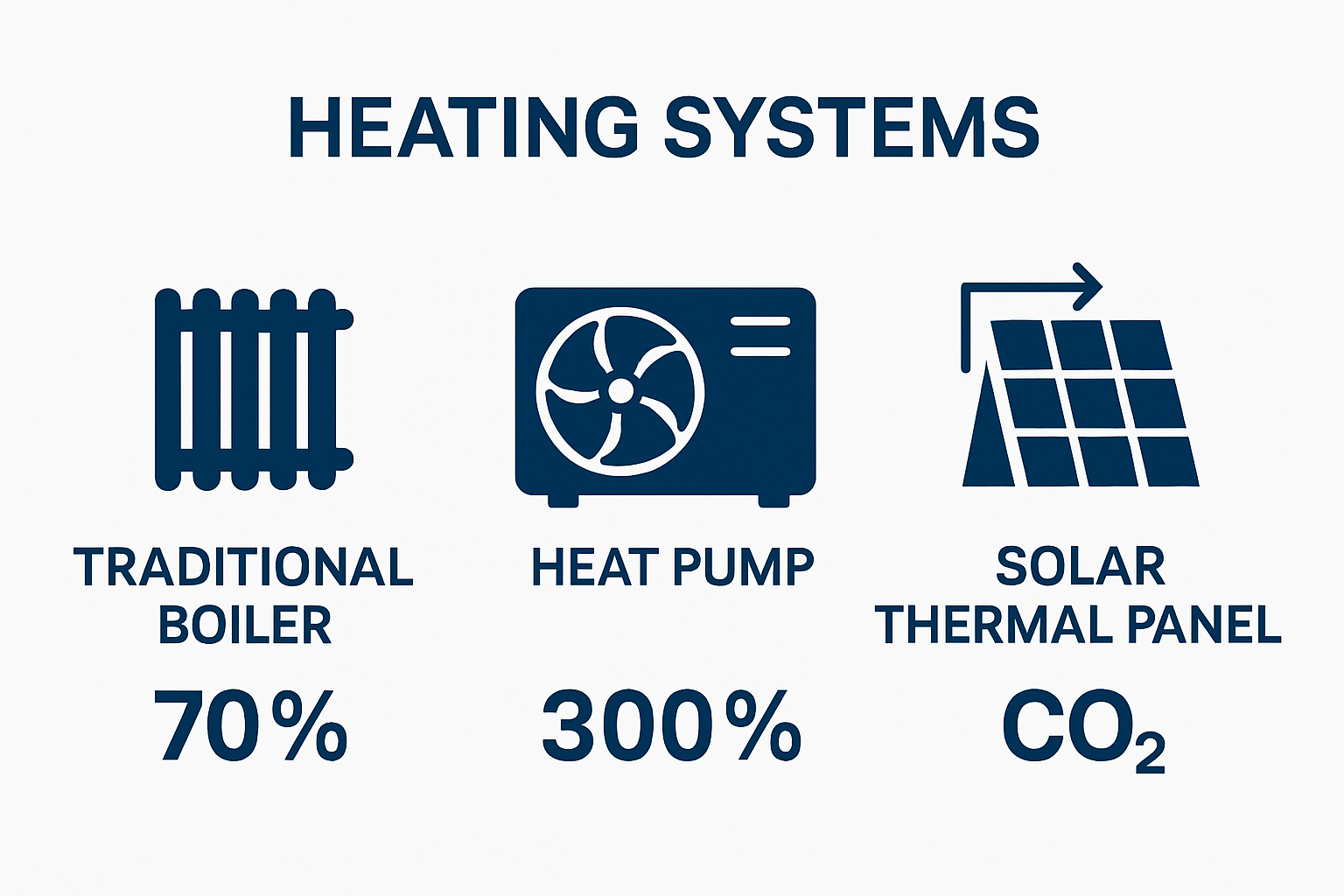
Why Energy Efficiency Matters for Homes and Businesses
Energy efficiency transcends simple cost savings, representing a critical strategy for environmental sustainability, economic resilience, and responsible resource management. It encompasses a comprehensive approach to reducing energy consumption while maintaining or improving performance across residential and commercial settings.
Economic and Financial Benefits
Implementing energy efficient solutions delivers substantial financial advantages for both homeowners and businesses. By reducing energy consumption, organisations and households can significantly lower utility expenditures and operational costs. Our comprehensive renewable solutions demonstrate how strategic investments in efficient technologies can generate long term economic returns.
According to research from the Environmental Protection Agency, energy efficiency offers remarkable economic benefits:
- Reduced monthly utility expenses
- Lower maintenance costs for heating and cooling systems
- Increased property value
- Enhanced operational productivity for businesses
Environmental and Social Impact
Beyond financial considerations, energy efficiency plays a pivotal role in addressing global environmental challenges. Reducing energy consumption directly correlates with decreased greenhouse gas emissions, contributing to climate change mitigation efforts. Efficient systems minimise waste, conserve natural resources, and support broader sustainability goals.
Key environmental advantages include:
- Substantial reduction in carbon dioxide emissions
- Preservation of finite energy resources
- Improved air and water quality
- Mitigation of climate change effects
By embracing energy efficient technologies, homes and businesses become active participants in creating a more sustainable future, demonstrating that economic prosperity and environmental responsibility can coexist harmoniously.
The table below presents a concise overview of the economic and environmental benefits of energy efficient heating solutions as highlighted in the article, helping homeowners and businesses appreciate their broader value.
| Benefit Category | Example Advantages |
|---|---|
| Financial / Economic | Reduced utility expenses, lower maintenance costs, increased property value, enhanced productivity |
| Environmental / Social | Reduced carbon emissions, conserved resources, improved air quality, mitigated climate change |
How Energy Efficient Heating Solutions Work
Energy efficient heating solutions leverage advanced technological principles to transform how thermal energy is generated, transferred, and maintained within residential and commercial environments. These sophisticated systems go beyond traditional heating methods by implementing intelligent design strategies that maximise energy utilisation while minimising waste.
Fundamental Energy Transfer Mechanisms
At the core of energy efficient heating solutions are sophisticated heat transfer mechanisms that differ fundamentally from conventional heating approaches. Explore our advanced heat pump technologies to understand these innovative energy conversion processes.
Unlike traditional systems that generate heat through direct combustion, modern energy efficient solutions employ multiple sophisticated techniques:
- Thermal Conversion: Transforming external energy sources into usable heat
- Energy Redistribution: Capturing and redirecting residual thermal energy
- Intelligent Temperature Management: Using smart controls to optimise heating efficiency
According to the U.S. Department of Energy, these systems typically operate through three primary mechanisms:
- Heat extraction from external environments (air, ground, water)
- Thermal energy transfer using minimal electrical input
- Precise temperature regulation through advanced sensor technologies
Technological Principles of Efficiency
Energy efficient heating solutions rely on cutting-edge technological principles that distinguish them from traditional heating systems. These principles focus on maximising energy conversion efficiency, minimising thermal losses, and implementing intelligent control mechanisms.
Key technological strategies include:
- Utilising phase change materials for thermal storage
- Implementing advanced insulation techniques
- Developing dynamic response heating systems
- Creating zonal heating capabilities
By integrating these sophisticated approaches, energy efficient heating solutions represent a quantum leap in thermal management technology, providing superior comfort while dramatically reducing energy consumption and environmental impact.
Key Concepts Behind Energy Efficient Heating Technologies
Energy efficient heating technologies emerge from intricate scientific principles that fundamentally reimagine thermal management. These advanced systems move beyond traditional heating approaches by integrating sophisticated engineering concepts that maximise energy conversion, minimise waste, and provide unprecedented control over indoor environmental conditions.
Thermodynamic Principles of Energy Transfer
At the core of energy efficient heating technologies lie complex thermodynamic principles governing heat movement and transformation. Learn more about our innovative heating solutions to understand these revolutionary approaches to thermal management.
Critical thermodynamic concepts driving these technologies include:
- Thermal Gradient Manipulation: Controlling temperature differences to facilitate efficient heat transfer
- Energy Conversion Efficiency: Maximising useful heat output from minimal energy input
- Entropy Reduction: Minimising energy dissipation and system losses
Key scientific mechanisms underlying these technologies involve:
- Extracting latent heat from ambient environments
- Transferring thermal energy through phase changes
- Implementing intelligent heat distribution strategies
Technological Innovations in Heat Management
Modern energy efficient heating technologies leverage cutting-edge innovations that transform traditional understanding of thermal systems. These technologies integrate advanced materials, intelligent control systems, and precision engineering to create unprecedented levels of performance.
According to scientific research, breakthrough concepts include:
- Quantum material design for superior thermal conductivity
- Nanotechnology-enhanced insulation techniques
- Adaptive temperature response mechanisms
- Machine learning driven predictive heating algorithms
By synthesising these sophisticated scientific principles, energy efficient heating technologies represent a paradigm shift in how we conceptualise and implement thermal management, offering solutions that are simultaneously more intelligent, sustainable, and responsive to dynamic environmental conditions.
Real-World Applications and Benefits of Energy Efficiency
Energy efficiency transforms theoretical concepts into tangible, practical solutions across residential, commercial, and industrial environments. By translating advanced technological principles into actionable strategies, these approaches deliver substantial economic, environmental, and performance benefits that extend far beyond traditional energy management practices.
Residential Energy Efficiency Strategies
Homeowners increasingly recognise the direct advantages of implementing energy efficient heating solutions. Discover our tailored renewable heating options to understand how these technologies can revolutionise domestic energy consumption.
Key residential applications include:
- Smart thermostat installations
- Comprehensive home insulation upgrades
- High efficiency heating system replacements
- Zonal heating control implementations
According to the U.S. Department of Energy, residential energy efficiency strategies can deliver remarkable outcomes:
- Potential heating cost reductions of 10%–50%
- Significant improvements in indoor comfort
- Substantial reduction in household carbon emissions
- Enhanced property value and market attractiveness
Commercial and Industrial Impact
Beyond residential settings, energy efficiency technologies generate transformative impacts across commercial and industrial sectors. These solutions provide organisations with opportunities to simultaneously reduce operational expenses, enhance environmental credentials, and improve overall system performance.
Significant commercial applications encompass:
- Advanced HVAC system optimisation
- Integrated energy management platforms
- Predictive maintenance technologies
- Comprehensive building performance monitoring
By implementing strategic energy efficiency approaches, businesses can achieve holistic improvements that extend beyond immediate financial considerations, creating sustainable, future focused operational models that balance economic performance with environmental responsibility.

Ready to Experience Real Energy Savings in Your Home?
You read about the power of energy efficient heating in our guide. Now imagine taking the next step and transforming your home with proven, cost-saving solutions right here in Edinburgh and Midlothian. If rising heating bills or an uncomfortable home temperature have left you frustrated, now is your opportunity to make a change. Thermatek’s Gas Safe Registered team specialises in everything from smart thermostat installations and boiler upgrades to cutting-edge renewable systems like air source heat pumps. We know that achieving true comfort and efficiency means having expert installation, honest advice, and ongoing support from a trusted local partner.

Act today to find out how our tailored heating and renewable services can reduce your energy costs and future-proof your home. Visit Thermatek Heating’s website to get your free quote or schedule a consultation with an engineer who understands your unique needs. A warmer, more efficient home is waiting for you—reach out now to start your journey.
Frequently Asked Questions
What are energy efficient heating solutions?
Energy efficient heating solutions are advanced technologies designed to minimise energy consumption while maintaining home comfort. They reduce energy use and carbon emissions compared to conventional heating methods.
How do heat pumps work as an energy efficient heating solution?
Heat pumps transfer thermal energy from external sources, such as air or ground, into your home, using significantly less electricity than traditional heating systems. They can operate in both heating and cooling modes, making them versatile.
What are the benefits of installing a smart thermostat?
Smart thermostats help optimise energy use by learning your heating patterns and adjusting accordingly. They can lead to substantial cost savings and improved indoor comfort by ensuring that heating is used only when needed.
How can energy efficient heating systems impact my energy bills?
By implementing energy efficient heating solutions, you can expect to see a reduction in your energy bills, potentially saving 10% to 50% on heating costs, depending on the efficiency of your existing system and the improvements made.
Recommended
- Air Source Heat Pump Installation In Edinburgh
- News
- Solar Thermal Installers In Edinburgh
- Smart Thermostat Installation In Edinburgh
Understanding How Long Does It Take to Replace a Boiler
Boiler replacements are more common than you might think, especially for homes stuck with ageing, unreliable systems. More than a third of UK homeowners face boiler troubles every winter yet many still put off a much-needed upgrade. Swapping out your old boiler does not just mean fewer chilly nights and fewer repair bills. The real shocker is how a new boiler can cut your energy usage by up to 30 percent compared to older models. This is not just about warmth, it is about transforming the way your home consumes energy.
Table of Contents
- What Is A Boiler Replacement And Why Is It Necessary?
- Factors Influencing The Duration Of Boiler Replacement
- Understanding The Installation Process Of A New Boiler
- The Impact Of Boiler Type On Replacement Time
- Real-World Examples Of Boiler Replacement Timelines
Quick Summary
| Takeaway | Explanation |
|---|---|
| Consider replacement after 15 years | Boilers over 15 years old are often inefficient and costly to maintain, warranting a new system. |
| Watch for rising energy bills | An increase in energy costs can indicate that your boiler is struggling, which may mean it’s time for replacement. |
| Look for visible damage or corrosion | Physical signs of wear on your boiler can signal that replacement is necessary to ensure safety and efficiency. |
| Complex systems take longer to install | The size and existing infrastructure of your property significantly influence how long the replacement will take. |
| Professional assessment is crucial | A thorough evaluation by professionals ensures the optimal size and type of boiler for your specific needs before installation. |
What is a Boiler Replacement and Why is It Necessary?
A boiler replacement involves removing an existing heating system and installing a new unit that provides more efficient and reliable heating for residential or commercial properties. When your current boiler becomes outdated, inefficient, or starts experiencing frequent breakdowns, replacement becomes a critical home maintenance task.
Understanding Boiler Replacement Fundamentals
Boiler replacements are not simply about swapping out old equipment but represent a strategic investment in home comfort and energy efficiency. The process involves carefully removing the existing heating system and installing a modern unit designed to meet current performance and safety standards. Learn more about our boiler replacement services to understand how we approach this complex process.
Key reasons for boiler replacement include:
- Significant reduction in energy consumption
- Improved heating performance and reliability
- Enhanced home safety and reduced risk of system failures
Signs Your Boiler Needs Replacement
Identifying when a boiler requires replacement is crucial for maintaining home heating efficiency. According to Energy Trust of Oregon, several indicators suggest it might be time for a new system:
- Boiler is more than 15 years old
- Frequent and costly repairs are becoming necessary
- Noticeable increase in energy bills
- Inconsistent heating performance
- Visible corrosion or physical damage to the unit
Modern boiler systems offer substantial improvements over older models, including better energy efficiency, more precise temperature control, and reduced environmental impact. By investing in a new boiler, homeowners can significantly lower their energy consumption and create a more comfortable living environment.
Factors Influencing the Duration of Boiler Replacement
Boiler replacement duration varies significantly depending on multiple interconnected factors. Understanding these variables helps homeowners anticipate the complexity and time investment required for a successful heating system upgrade.
Explore our comprehensive boiler replacement services to better understand the intricacies involved in this process.
Property and System Complexity
The physical characteristics of your property and existing heating infrastructure play a critical role in determining replacement timelines. Larger homes with complex heating systems typically require more extensive work compared to smaller, straightforward installations. According to University of Illinois’ EnergySense Resilience Center, several key variables impact replacement duration:
- Total square footage of the property
- Existing pipework and infrastructure condition
- Accessibility of installation areas
- Complexity of the current heating system
Technical Considerations and Preparation
Professional boiler replacement involves meticulous planning and execution. Preliminary assessments and preparatory work can significantly influence the overall duration of the project. Homeowners should anticipate additional time for:
- Comprehensive system inspection
- Potential modifications to pipework or ventilation
- Electrical and gas connection adjustments
- Removal of the existing boiler unit
- Installation of new high-efficiency system
Installation Timeframes
Typical boiler replacement projects can range from 4 to 10 hours for standard residential properties, with more complex installations potentially extending to 1-2 days. Factors such as system compatibility, property layout, and unexpected infrastructure challenges can impact the total time required. Professional heating engineers will provide a detailed timeline after conducting an initial property assessment, ensuring transparent communication about the expected duration and scope of work.
This table summarises the main factors that influence how long a boiler replacement will take, providing a clear view of what might impact your installation timeline.
| Influencing Factor | Description |
|---|---|
| Property Size | Larger homes may require more extensive work |
| Existing Heating Complexity | Complex setups can add to installation time |
| Pipework & Infrastructure | Poor or outdated condition may need modifications |
| Accessibility | Difficult-to-reach areas slow down replacement |
| Boiler Type | Installation times vary based on the type of boiler chosen |
| Preparation and Assessments | Extra time for inspections, planning, and compliance checking |
The goal is not just replacing an old boiler but creating an optimised heating solution that enhances home comfort, energy efficiency, and long-term performance.
Understanding the Installation Process of a New Boiler
The boiler installation process is a complex technical procedure requiring professional expertise and precise planning. Homeowners must understand the comprehensive approach professional heating engineers undertake to ensure safe, efficient, and compliant system replacement. Learn about our expert installation services to appreciate the intricate details involved in this critical home improvement project.
Pre-Installation Assessment
Before any physical installation begins, a thorough property evaluation is essential. According to the U.S. Department of Energy, professional heating engineers conduct detailed assessments to determine the most suitable boiler configuration. This preliminary stage involves:
- Measuring the property’s total heating requirements
- Evaluating existing pipework and infrastructure
- Checking electrical and gas connection compatibility
- Assessing ventilation and flue system specifications
- Recommending appropriate boiler size and efficiency rating
Technical Installation Procedures
The actual installation process demands precision and adherence to strict safety protocols. Professional engineers systematically approach the replacement by:
- Safely disconnecting the existing boiler
- Removing old equipment without causing structural damage
- Installing new mounting brackets and connection points
- Connecting water, gas, and electrical systems
- Configuring advanced control mechanisms
- Performing comprehensive system testing
Final Verification and Commissioning
Boiler installation is not complete until rigorous testing and verification occur. Engineers conduct multiple diagnostic checks to confirm the new system operates at optimal performance levels. This final stage includes checking combustion efficiency, measuring heat output, verifying safety mechanisms, and ensuring all components function seamlessly. Proper commissioning guarantees the boiler meets manufacturer specifications and complies with current safety regulations, providing homeowners with a reliable and efficient heating solution.
The Impact of Boiler Type on Replacement Time
Different boiler types significantly influence the overall duration and complexity of replacement processes. Understanding these variations helps homeowners prepare for the technical nuances involved in heating system upgrades. Explore our comprehensive boiler replacement options to understand how various boiler types impact installation timelines.
Condensing vs Non-Condensing Boilers
The technological sophistication of boiler systems plays a crucial role in determining replacement duration. According to the U.S. Department of Energy, condensing boilers represent a more complex installation compared to traditional non-condensing models. Key differences include:
- More intricate pipework requirements
- Additional condensate drainage systems
- More advanced control mechanisms
- Higher efficiency but more technical installation process
- Potential need for modified ventilation infrastructure
Combi, System, and Regular Boiler Variations
Each boiler type presents unique installation challenges that directly impact replacement timeframes.
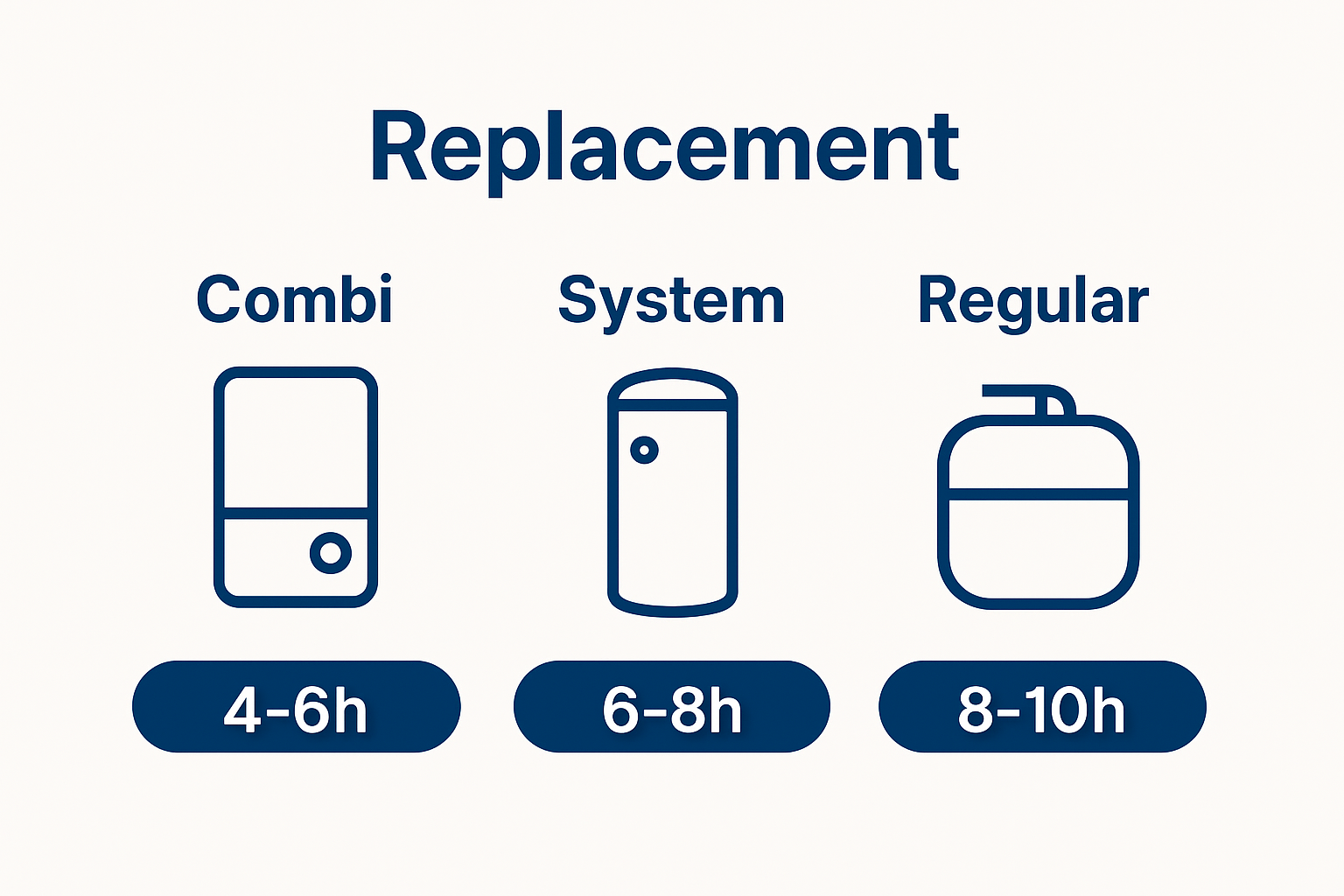
Combi boilers typically offer the quickest installation due to their compact, all-in-one design. System boilers require additional water storage components, while regular boilers with separate hot water cylinders demand more extensive setup procedures:
- Combi boilers: Fastest replacement (4-6 hours)
- System boilers: Moderate complexity (6-8 hours)
- Regular boilers: Most time-consuming (8-10 hours)
- Potential additional time for water cylinder modifications
Technical Complexity and Professional Assessment
Boiler replacement is not a one-size-fits-all process. Professional heating engineers conduct detailed assessments to determine the most appropriate installation approach. Factors such as property size, existing infrastructure, and specific heating requirements significantly influence the replacement timeline. The goal remains consistent: delivering a reliable, efficient heating solution tailored to individual home needs, with minimal disruption to daily living.
Real-World Examples of Boiler Replacement Timelines
Boiler replacement experiences vary widely across different residential and commercial settings, offering valuable insights into the practical realities of heating system upgrades. Discover our comprehensive replacement case studies to understand the nuanced timelines of professional installations.
Residential Property Replacement Scenarios
In typical domestic settings, boiler replacement timelines demonstrate significant variation. According to the Building America Solution Center, real-world replacement durations depend on multiple interconnected factors. Homeowners can expect the following typical scenarios:
- Standard terraced house: 6-8 hours total installation time
- Larger detached property: 8-10 hours replacement duration
- Complex heating system configurations: Up to two full working days
- Potential additional time for unexpected infrastructure challenges
- Minimal disruption with professional planning and execution
Commercial and Institutional Replacement Examples
Institutional and commercial boiler replacements present more complex timelines compared to residential installations. Larger facilities require more comprehensive planning and potentially extended replacement periods. Key observations from professional case studies reveal:
- School building boiler upgrades: 2-3 days total project time
- Office complex heating system replacements: 3-5 days
- Multi-zone institutional facilities: Up to one week for complete installation
- Significant emphasis on minimizing operational disruptions
- Detailed pre-installation assessment critical for timeline accuracy
Factors Influencing Actual Replacement Duration
While these examples provide general guidance, actual replacement times remain uniquely tailored to specific property requirements. Professional heating engineers consider numerous variables during the assessment, including building age, existing infrastructure, boiler type, and potential unforeseen complications. The goal remains delivering a seamless, efficient heating solution with minimal interruption to daily activities.
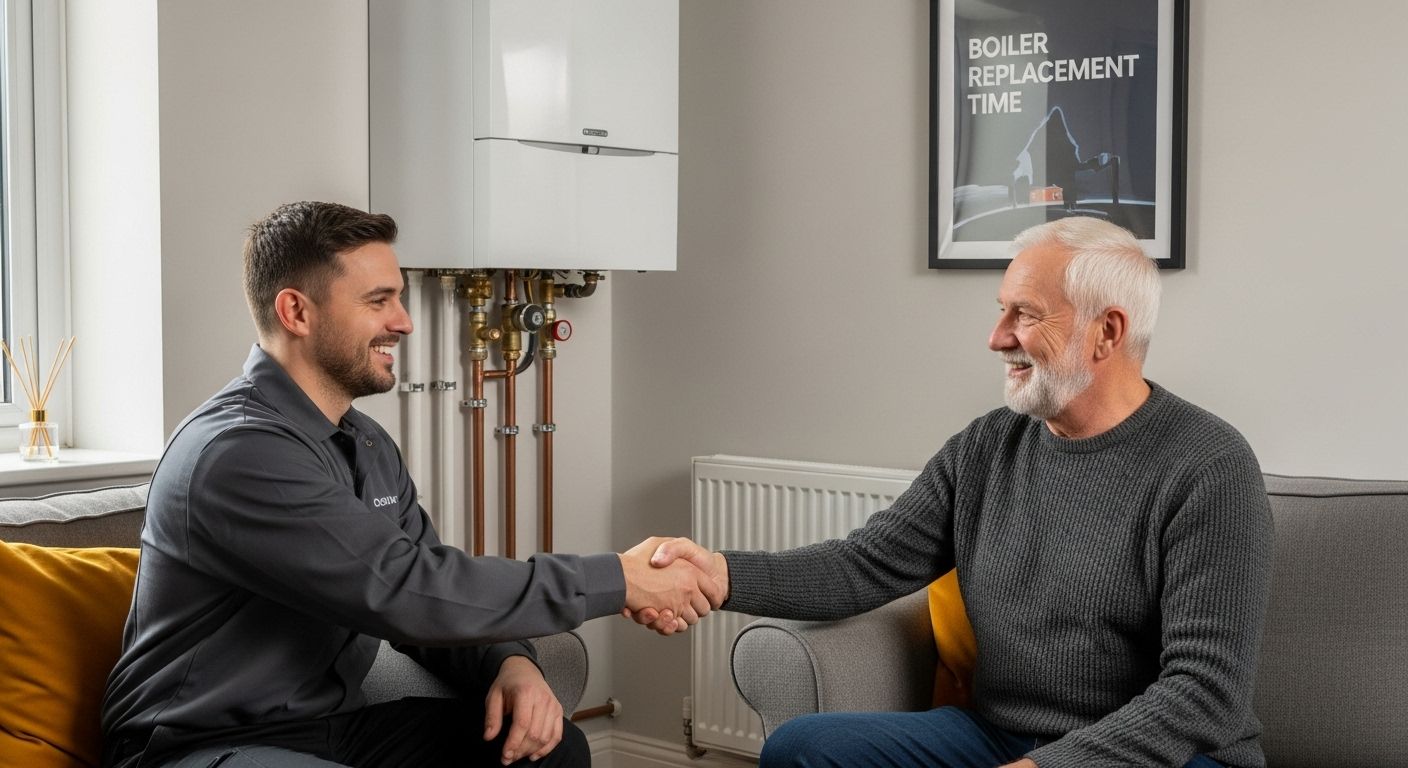
Ready for a Stress-Free Boiler Replacement Experience?
Unexpected boiler breakdowns and long installation times can disrupt your comfort and peace of mind. If you are concerned about how long a boiler replacement might take or worry about hidden challenges with older systems, you are not alone. With factors like system complexity and property layout affecting installation durations, it is vital to choose a team that is fully prepared for any situation and values clear communication.

Let the Gas Safe Registered experts at Thermatek Heating guide you through every step. We specialise in swift, safe boiler replacements while ensuring minimal disruption to your daily life. Access a trustworthy local service that also handles repairs and servicing, so you never have to face chilly days or mounting energy bills again. Visit our boiler replacement page to get a free, no-obligation quote and see why homeowners across Edinburgh and Midlothian trust us for efficient, reliable heating solutions. Take action today for a warmer, safer home.
Frequently Asked Questions
How long does it typically take to replace a boiler?
Typical boiler replacement projects can take between 4 to 10 hours for standard residential properties, while more complex installations may require up to 1-2 days.
What factors influence the duration of a boiler replacement?
The duration of a boiler replacement can be affected by factors such as the size of the property, the complexity of the existing heating system, the condition of the pipework, and any necessary modifications to infrastructure.
How can I tell if my boiler needs replacing?
Signs that your boiler may need replacing include its age (over 15 years), frequent breakdowns, rising energy bills, inconsistent heating, and visible corrosion or damage to the unit.
What are the different types of boilers and how do they affect installation time?
Boiler types, such as combi, system, and regular boilers, have varying installation complexities. Combi boilers are generally faster to install (4-6 hours), while regular boilers take longer due to additional components required (8-10 hours).
Recommended
- New Boiler Installation & Replacement In Edinburgh
- Air Source Heat Pump Installation In Edinburgh
- Boiler Repair In Edinburgh
- Plumbing Services In Edinburgh

